



In September 2012, Italian tactical media artist Salvatore Iaconesi got the diagnosis. He had a glioma (glial cell brain cancer) of approximately 2×3 cm on the surface of his right hemisphere. Upon asking to see all the data relating to his condition, he found that all of the documents, MRI scans, and so on were in obscure not readily used formats. This meant that if one wanted to view the data, you needed specific or corporate software.
What he did then was remarkable. Iaconesi then hacked the formats of the documents and converted them into open-source ones that anyone could read could read with FLOSS (Free Libre Open Source) software. He then created the site, La Cura, where he presented his records as an “open source cure”. People around the world could access his records and then add their recommendations and findings about his condition, cancer, and so on. I begin this interview with Salvatore on September 15, 2012, and the La Cura website already has a rapidly expanding database of information at http://www.artisopensource.net/cure/.
Patrick Lichty: Salvatore, thank you for having this conversation. I remember that it was only a year and a half ago when we were shop-giving copies of the REFF tactical media book from your project, Fake Press in Rome. So, it was a shock when I learned of the glioma the day you launched the site. Could you talk a little about what is on the La Cura site?
Salvatore Iaconesi: Hi Patrick! Yes I do remember, too. And that is also a great explanation on what can be found at La Cura site: it is like one of our “fakes”, except that it is not a fake.
La Cura is about an alternative reality which I want to materialize on this planet, now. In this alternative reality, when someone has a serious disease, life does not end. One can be social, creative, and friendly. Work, art, design, fun and entertainment are possible for diseased people in this alternative reality, just as it is possible to reach out to find cures in any philosophy, time, strategy, culture or way one wishes. And consider that even technologies in this alternative reality are designed to enable and facilitate all this, actively promoting the freedom and autonomy of people.But, sadly, life is not like this alternative reality.
I wanted it to be my alternative reality, so I just did everything it took to bring that reality into the world. It’s like when you make an Augmented Reality application: you do a series of things to “materialize” some other things into ordinary reality. And then you have them, right there. So, La Cura is my personal Augmented Reality, in which, if I want to, I have all the tools and information I need to find a “cure” for my disease in one of multiple ways and strategies, which are medical, cultural, technological, emotional, artistic, political etc.
To achieve this, I have had to go through a series of obstacles:
The first is connected to language and information, as the first thing you notice at the hospital is that they are not really talking to you. Medical language is difficult and complex, and they rarely take action to make things more understandable to you. One of the testimonies I received in La Cura was that of a lady who has found herself in front of a doctor shouting at her: “You really think that I will explain to you why your thyroid has to be removed? It has to be removed! That’s it!”
This is really not “open”, in any sense. And, in more than one way, it is an explicit evidence of the approach which medicine has towards patients: they cease to be “humans” and become sets of parameters on a medical record subject to certain protocols and standards. When you are in the hospital, it’s often as if you’re not there. The only thing that matters is your data: blood pressure, heartbeat, magnetic resonance etc.
And the way in which information reflects this if handled in this context. Data formats may be, technically “open”, meaning that they are described somewhere but they’re really an explicit reflection that when you’re sick you “step out of society”. That data is usable and accessible only to “professionals” and to those people who have tools and skills to handle them.

I, as someone with considerable expertise with computers, have had some difficulties in opening them. Imagine someone else with less skill! Most people would not have been able to benefit from all the types of “cure” which I am currently accessing from a variety of sources and modalities. They would not have access to a “cure” that doesn’t end at a list of medicines and dosages, but spreads out into society.
To do that, I have had to hack into the information and convert it into really “open” data, using multiple formats that could be used by many kinds of people to do multiple things. In the format that the data was originally in, even if it was “technically open”, that data would have been seen only by “professional doctors” and, instead of being a “human being”, I would only have been a “patient”, or worse yet, a “case”.
PL: What do you want people to do with the information?
SI: Whatever they wish! Obviously! What is important in this case is that we must agree on what the “information” is… What I am publishing is my autonomous will to disclose my state of disease, including all data and medical information. I have my own purposes for this, but it does not necessarily mean that this purpose must/should be shared by others.
My personal purpose for this disclosure is to autonomously shape my own human condition. I have a disease but I am not a “diseased person”. I am a person. And, as such, I wish to create my personal “cure”, which has to do with my life, not with my disease. For what people know, I might even consider cancer as not being a “disease” at all! I might, for example, consider it an expression of the “cure”, such as if I adhered to Hamer’s theories. Which I don’t, or, at least, not in the sense that “I believe” in Hamer’s theories; I take them into consideration, but I don’t believe in them, just as I don’t believe in chemotherapy, in Aloe Vera, in Caisse Formula, in surgery, in shamanism, in healers, oncology or in any of these things. I take all of them into serious consideration, just as I seriously consider certain philosophies that say that we are made of energy, energy creates matter, and cancer is “matter” and so on. Therefore, cancer must be created by energy in some form. And so it could possibly be that I created cancer myself in a way or another.

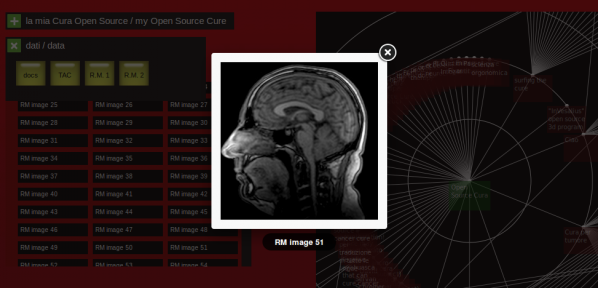
So in this sense, I think it is very important to be able to easily look at the images of my cancer and to say “hello” to them. It is important to turn them upside down, to edit them with GIMP, to make mosaics out of them, to speak to them, asking “hello?” What are you doing in there? Did I do something to cause you? Can I change something to make you/myself feel better?”
Both scientific and traditional evidence shows that art, positive emotions, laughter, reduced stress, and a good social life have great practical benefits to the human body, I want to seriously consider that part of my cure could be formed by receiving an image of my brain with a smiley face drawn across it over the tumor, or a picture of a friend of mine, or a video of a projection mapping done with Processing in which the images of my cancer cover a whole facade of a building.
And since I don’t want to believe, but I want to take all of these things into serious consideration, I cannot focus only on the “medical” approach (and the related information, and its formats). I need to access all of my information in multiple ways, and I wish that everyone could do the same (as, from my point of view, it’s part of my Cure). And, even if “technically open”, the format in which my medical records have been disclosed is not enough, because it is “open for professionals” and so the only thing I could do with it would be “show it to professionals”, missing out on all the other wonderful parts of the “cure” which are available in the world.
This for me, is an interesting starting point to think about what things such as “OpenData” could mean. This is far beyond the idea that some government can some data according to ways in which some “professionals” could grab it and, do something like make a visualization or an App out of them. Who knows? In this sense, instead, we would not be talking about “technology”, we would be talking about “humanity”.
In the end, this is exactly what I’d like people to do with the “information”. I want the world to take the fact that I decided to disclose the fact that I have a disease and that I want to actively search for a cure for from all of these perspectives. In the meantime, I want to reconsider what it means to be “diseased” in current times and what new conceptions of the word “cure”, “medicine” associated with my condition could mean.

PL: What has happened since you launched the La Cura site?
SI: Lots of things. People are contributing and participating in multiple ways. There are testimonies, art, poetry, suggestions, videos, performances. Many doctors have called in to propose their methodologies and technologies. I have had very interesting and profound discussions with people who are prepared to deal with very complex things every day of their lives. I’ve communicated with doctors who are perfectly open to the possibility of such a paradigm change for the word “cure”. Artists, designers, activists, are giving me wonderful parts of “cure”. Many “patients”, “ex-patients”, “relatives” and “friends” of “diseased people” are sharing their experiences, are opening discussions, are sharing the information I found on possible medical cures. And so many people want to talk to someone in new and different ways, becoming again, simply, humans. Journalists from all kinds of media have started to ask for interviews, texts and videos. We stopped that after a while, as we don’t wish to turn this into merely a “spectacle”. We only keep on working on this with journalists which we know we can trust and which we know will not transform what we say to produce their news.
PL: For your information, I had an MRI in 2009 here in the States, due to my doctors’ concerns of something similar (nothing was found), but when I asked for the data, I got a CD full of JPEG images. Were you surprised when you found out your records were in particular formats?
SI: They were not really in a proprietary format. Let’s call them “exotic formats for professionals”. And yes, I would have expected something which I could have shared easily (such as your JPEG images, and maybe some meta-data in some easy to use format such as XML, or even a spreadsheet). But this was a sort of paradox: an “open” format which is really hard to open and to use for something else other than putting the CD in an envelope and (snail)mailing to the next doctor.
PL: What do you think the line is between privacy and data oppression? Would that be when the patient is denied access to their rights to access the information and distribute it as they wish?
SI: We should all know this by now. Privacy is not a problem unless the “system” is made by lousy people. We have tools to protect ourselves and to promote ourselves, and these tools are dangerous only when who runs them is a lousy person. Privacy protection arises through education (understanding what is privacy and when/where/how/why would I want to protect it) and through the acquisition of decent ethics from the people and organizations which run the entire infrastructure through which all our digital data goes through. And obviously, and most importantly, our ethics is created by helping each other out in a P2P way, teaching each other what we know, what we discover and how we decided to handle it when we found out.
There is no single line between privacy and data oppression. Not one which everyone would agree on. We have the tools for each one of us to tune this line to our own wishes, according to what we want to do, what are our desires, what are our objectives etc. We “just” need more places (physical, digital, virtual, institutional, occasional…) in which to discuss and share our points of view, as every time this happens, many things are learned on all sides.
PL: Do you consider your site a form of radical tactical media intervention?
SI: I can now say “I have a radical tactical media intervention in my head”. Cancer is the new Black. The Cancer is the Message. And we could go on. I don’t know. I guess I could call it that. I also guess I could call it a performance. I guess I could call it life. I guess I could call it hacking or whatever. I will just call it La Cura.
PL: What has been the most inspirational information, art, or otherwise that has resulted from the launching of the La Cura site?
SI: The most enlightening thing that happened is the experience of talking about the same exact thing using dozens of different languages. I have spoken with neurosurgeons, shamans, nutritionists, pranotherapists, doctors, activists, macrobiotics, hippies, cyberpunks, punks, friends, relatives. Most of the time, I received incredibly good advice. When you look at that advice from different points of view, you start to understand that you are really talking about the same thing, but in different languages.
For example, two of the most important things which you deal with when you talk about cancer are the idea of creating alkaline environments in your body (because cancer cells cannot stand them) and the facts that anti-oxidants are a great tool in support of any type of therapy (because of the molecular reactions which are at the base of cancer).
Well, speaking of just these two, it occurred to me that multiple theories deal exactly with these two concepts. I have had an esoteric master describe my cancer as an invisible living being, and he suggested to drive it away using sulfur and Rosa Rubiginosa oil, in ways which turn them into two incredible anti-oxidants and creators of alkaline environments as well as powerful stimulants of the immune system. I have also spoken with nutritionists and macrobiotics communities and learned about their instructions on choosing food, cooking and eating, many of which are directed exactly to that: anti-oxidants and creating alkaline environments, but through food.
And when an oncologist explained us his therapy, that’s exactly what it was about: powerful anti-oxidants and alkaline environments. And on, and on and on. Aloe Vera, Caisse formula, fungus theory, chemiotherapy, Di Bella method, potassium ascorbate, ketogenic diets, etc: all highlight cancer cells in some way; create an environment around them which is as alkaline as possible; anti-oxidate them; activate the immune system as powerfully as possible so that the highlighted weakened, cancer cells can be more easily “convinced” at mutating back to a decent form or to commit suicide with the help of the immune system. Realizing this is an enlightening experience: it spans across thousands of years and also helps you make some choices (things stand out when they speak about different things!).
Everything else that is going on in La Cura is wonderful, but having realized this fact is just incredible and fascinating. You start imagining about all the other things we discuss about in our daily lives using multiple languages (energy, politics, emotions…) and start to wonder what would happen if you turned on this shared, P2P modality in those cases as well.
PL: How do you hope that others will benefit from the conversation that you are starting through La Cura?
SI: I don’t “hope” anything. I did this because I felt I needed to. When one talks about “revolution” dialogues start arriving at the point when one says, “Let’s burn everything down!” “Let’s destroy everything!” and so on.
We know we can’t do it. We can’t “destroy everything”. It’s not possible. What we can do is to create a reality as if everything already happened – as if the “revolution” already happened, as if the world had been burned down already, and rebuilt, just the way you like it. We can live life like this. It is a bit more than “seeing things”. But you do Augmented Reality, Patrick. You know what I mean. It’s a bit more than “writing”, it’s about creating worlds.
PL: As of this interview, what is the prognosis of your condition?
SI: Depends on what perspective you look at it from. From the medical point of view I have a low-grade glioma at intensity which is still undecided, between 1 and 2 (we will have to wait an histologic exam to know for sure). From the human point of view: I am fine! I have no apparent symptoms. I just need to be careful because if I find myself in stressful situations I could react by having an epileptic shock. So it is not advised that I drive or things like that. It’s the perfect excuse! 🙂
PL: Don’t you think it’s funny that the abbreviation for your name is “si”?
SI: Sì! Obviously 🙂
“Tweets in Space beams Twitter discussions from participants worldwide towards GJ667Cc – an exoplanet 22 light years away that might support extraterrestrial life. By engaging the millions of voices in the Twitterverse and dispatching them into the larger Universe, Tweets in Space activates a potent conversation about communication and life that traverses beyond our borders or understanding.”
Marc Garrett: Could you explain to our readers what ‘Tweets In Space’ is?
Scott Kildall and Nathaniel Stern: Tweets in Space is an art project — a networked performance event — which beams your Twitter messages to a nearby exoplanet that might support human-like, biological life. Anyone with an Internet connection can Tweet with the hashtag #tweetsinspace during the performance time, and their messages will be included in our shotgun blast to the stars. The performance is on September 21st, 20:30 – 21:00 Mountain Time (3:30 AM BST / London time).
MG: What was the motivation behind your current collaboration?
SK and NS: We found inspiration from various sources. First, in NASA’s Kepler mission, whose purpose is to discover planets in the “habitable” or “Goldilocks” zone. The project has found over 2000 exoplanets thus far, all of which are “not too hot, not too cold, but just right” for life as we know it. Scientists now estimate that there are at least 500 million planets like this in the Milky Way alone. Our conclusion: extraterrestrial life is almost certainly out there.
![The newly discovered planet is depicted in this artist's conception, showing the host star as part of a triple-star system. Image credit: Carnegie Institution / UCSC. [1]](http://www.furtherfield.org/wp-content/uploads/2012/09/planet_gj667cc.jpg)
“The latest discovery is at least 4.5 times bigger in size than Earth. Reportedly, the planet exists 22 lightyears away from Earth and it orbits its star every 28 days. The planet is known to lie, in what is being referred to as the star’s habitable zone. A habitable zone is a place where the existing conditions are just perfect for life sustenance. Astronomers, according to this report also suspect that the GJ667Cc may have been made out of earth-like rock, instead of gas.” [ibid]
Another source of great inspiration is how we use social media here on Earth. This is our second, large-scale, Internet-initiated collaboration. In 2009, we amplified the power structures and personalities on Wikipedia, and questioned how knowledge is formed on the world’s most-often used encyclopedia – and thus the web and world at large. Now, we are turning to the zeitgeist of information and ideas, feelings and facts, news and tidbits, on Twitter. The project focuses on and magnifies the supposed shallowness of 140-character messages, alongside the potential depth of all of them – what we say in online conversation, as a people.
We are directing our gaze, or rather tweets, via a high-powered radio telescope, towards GJ667Cc – one of the top candidates for alien life. It is part of a triple-star system, has a mass that is about 4 times that of Earth, and orbits a dwarf star at close range. GJ667Cc most certainly has liquid water, an essential component for the kind of life found on our own planet.
MG: Right from its early years when Jagadish Chandra Bose [2], pioneered the investigation of radio and microwave optics – science, technology and art have had strong crossovers. And it might be worth mentioning here that Bose was not only well versed as a physicist, biologist, botanist and archaeologist, he was also an early writer of science fiction. [3] Which, brings us back to ‘Tweets In Space’, wherein lies themes relating to science fiction, radio broadcasting (commercial, independent and pirate), wireless technology of the everyday via our computers, and ‘of course’ the Internet.
![J.C. Bose at the Royal Institution, London, 1897.[3]](http://www.furtherfield.org/wp-content/uploads/2012/09/JC-Bose-at-the-Royal-Institution-London-with-his-radio-equipment-The-date-is-1897.png)
But, what I want to pin down here is, where do you feel you fit in historically and artistically with other past and contemporary artists, whose creative art works also involved explorations through electromagnetic waves?
Scot Kildall: The work of JC Bose is incredible and what strikes me is that he eschewed the single-inventor capitalist lifestyle in favor of his own experiments. Isn’t this the narrative that artists (often) take and linked back in many ways to the open-source/sharing movement, rather than the litigious patent-based corporation? And it mirrors in many ways the reception of electromagnetic radiation as well. You can’t really “own” the airwaves. Anyone who is listening can pick up the signal. This comes back, as you point out, to the internet. Twitter is now, one of the vehicles, and, ironically entirely owned by a benevolent* corporation.
Nathaniel Stern: (Agreeing with Scott) and we can’t forget of course Nam June Paik, who played with naturally occurring and non-signal based electromagnetic fields to interfere with analogical signals (as well as the actual hardware) of tube televisions, and more. And of course, there have been other transmission artists, explored in depth by free103point9, among others. I think, like them and others, we are messing with the media, amplifying (figuratively and metaphorically) and intervening, pushing the boundaries of DIY and cultural ethico-aesthetic questions…
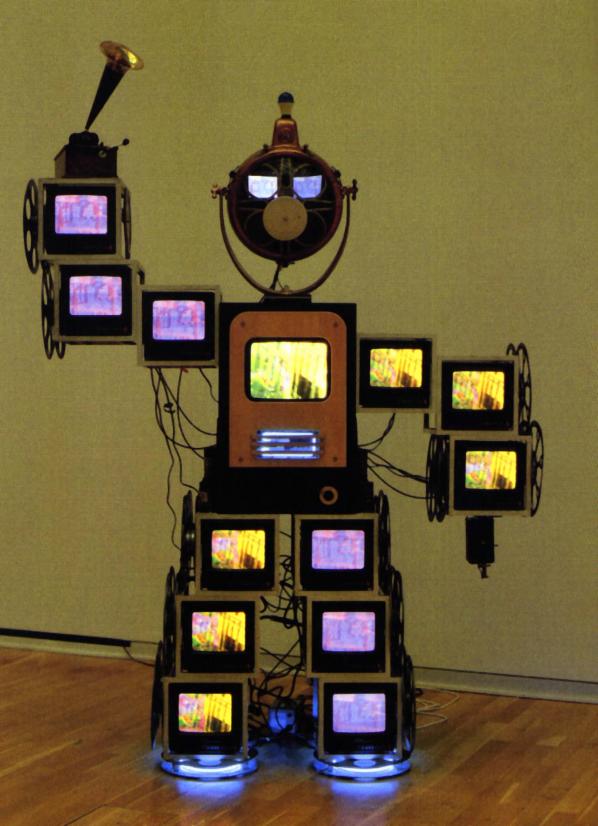
MG: What is especially interesting is that all the tweets submitted by the public are unfiltered. How important is it to you that people’s own messages are not censored when going into space?
SK and NS: Absolutely. Tweets in Space is by no means the first project to transmit cosmic messages with METI technologies (Messaging to Extraterrestrial Intelligence). Our fellow earthlings have sent songs by the Beatles, photos of ourselves shopping at supermarkets, images of national flags, and even a gold record inscribed with human forms – controversially, where the man has genitals and the woman doesn’t. These slices of hand-picked content exhibit what a select few believe to be important, but ignore, or willfully exclude, our varied and collective modes of thinking and being.
Tweets in Space is “one small step” with alien communications, in that it is open to anyone with an Internet connection. It thus represents millions of voices rather than a self-selected few. More than that, our project is a dialog. There have been, very recently, a small number of projects that similarly “democratize the universe” but none are like ours: uncurated, unmediated thoughts and responses from a cooperative public. We can speak, rebut, and conclude, and nothing is left out. Our transmission will contain the good, the bad, and the provocative, the proclamations, the responses, and the commentary, together, a “giant leap” for all of humankind – as well as our soon-to-be friends.
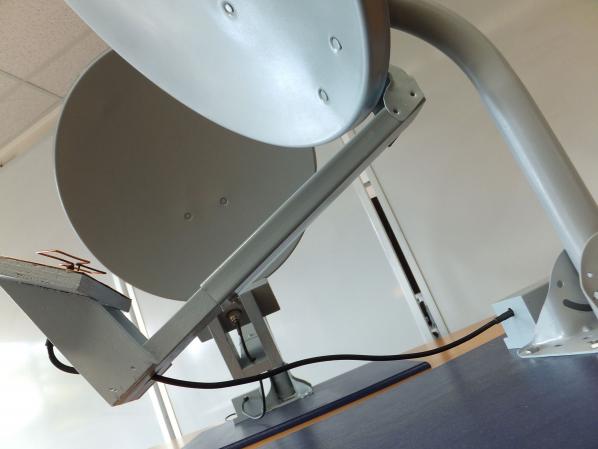
Furthermore, by limiting the event to a small window of only 30 minutes, we are encouraging all our participants to speak then respond, conversing with one another in real-time, through networked space. We are not just sending lone tweets, but beaming a part of the entire dialogical Twitterverse, as it creates and amplifies meaning. Tweets in Space is more than a “public performance” – it “performs a public.”
MG: Now, you will be transmitting real-time tweets toward the exoplanet GJ667Cc, which is 22 light-years away. How long will it all take to get there?
SK and NS: Well, first off, we’re collecting all of the tweets in real time, but only sending them out later in October. The main reason for this is that we have to wait for the planets to align – literally. We want line of sight with GJ667Cc from where our dish is. The added bonus of time, however, is that this will allow us to really flesh out how we send the messages in a bundle. We want to include a kind of Rosetta Stone, where we will not only send binary ASCII codes of text in our signal, but also analog images of the text itself. We additionally intend to choose the most frequently used nouns in all the tweets from our database, then give a kind of “key” for each. If “dog” is common, for example, we can transmit: 1. an analog image of a dog, like a composite signal from a VCR; 2. a text image of the word “dog” in the same format; and 3. the binary ASCII code for the word dog.
In terms of time/distance, when speaking in light years, these are the same thing. A light year is the distance light can travel in one year of Earth time (about 9.4605284 × 10 to the 15 meters). Since radio travels at the speed of light, a big dish on GJ667Cc will pick up the signal in 22 years. We should start listening for a response in 44 – though it may take them a while to get back to us…
MG: Will the code used for the project be open source, and if so, when and where can people expect to use it?
SK and NS: Yes it is! The most useful part of our code is the #collector, which saves real-time tweets to a database, that can then be used for live projections or web sites, or accessed and sorted later via all kinds of info. The problem is that it’s not really user friendly or out of the box – folks need a suped up server (VPN), and to plug into a few other open source wares. The main portion of the backend we used is actually already available at 140dev.com, and then we plugged that into Drupal, among other things. For now, we’re telling interested parties to contact our coder, Chris Butzen, if they want to use our implementation. And we hope to do public distribution on tweetsinspace.org if we are able to package it in a more usable format in the next 6 months.
MG: Are there any messages collected so far, grabbing your attention?
We’ve had thousands of tweets so far – even while just testing the ware in preparation for the performance. We’re anticipating a lot of participation! The tweets we’ve seen have ranged from variations on “hello [other] world” and “don’t eat us,” to political activism and negative commentary, to a whole surreal narrative of about 30 tweets per day over the last 3 months.
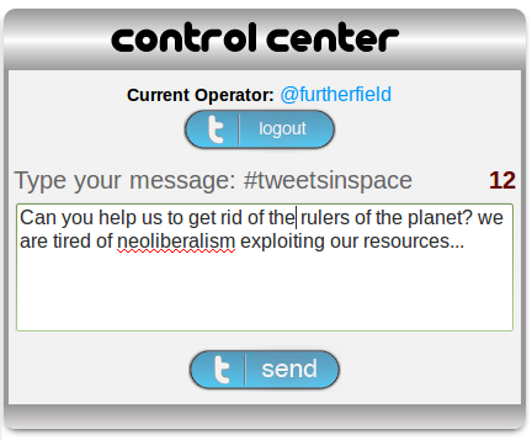
go to tweet aliens to add your own words…
Some of our favorite tweets have been those that question how to make our own world better. These speak to both the hope of space age-ike technology, as well as the hope in collective dialog – both of which our project tries to amplify. Such tweeters ask about the alien planet’s renewable energy sources, tax structures, education, art, and more.
We imagine the 30-minute performance will see a much more potent discussion about such things, and hope your readers will participate. The final transmission will be archived permanently on our site once we’ve prepared it for launch.
As part of the International Symposium on Electronic Art in New Mexico (ISEA2012). We will collect your tweets and transmit them into deep space via a high-powered radio messaging system. Our soon-to-be alien friends might receive unmediated thoughts and responses about politics, philosophy, pop culture, dinner, dancing cats and everything in between. By engaging the millions of voices in the Twitterverse and dispatching them into the larger Universe, Tweets in Space activates a potent conversation about communication and life that traverses beyond our borders or understanding. http://tweetsinspace.org/
AND THEY WILL BE SENT INTO DEEP SPACE!!!
Watch the stream LIVE here – http://tweetaliens.org/tweets/tweets.php
ALL WELCOME
A project by Sarah Waterson and dogs (and their human companions) of Finsbury Park.
+ Dog walks: every Wed-Sat, between Wed 17 October and Fri 30 November 2012
Laika’s Dérive invites Finsbury Park’s dogs and their human companions to record a walk in their local park and surrounding area. This walk offers a chance for interspecies communication and a sharing of knowledge that results in a collaborative mapping of each dog/human’s walk.
Each dog is kitted-out with a system that automatically photographs the dog’s favourite vistas and objects on location. The photographs are selected via the sniff and interest time of the dog, and are returned to the human as a series of the dog’s favourite snaps, and displayed on Laika’s Dérive website.
Laika’s Dérive is part of the WWW: World Wild Web exhibition at Furtherfield Gallery.
To take your dog for a dérive, please contact Furtherfield Gallery at info@furtherfield.org or phone 0208 802 2827.
Walks can be booked by one person/dog Wednesday to Saturday between 1-5pm, from Wednesday 17 October to Friday 30 November 2012, so book early to avoid disappointment!
The kit collection point for the walk is Furtherfield Gallery, McKenzie Pavilion, in Finsbury Park.
Event Coordinator: Laura Bottin
Event Producer: Alessandra Scapin
Laika’s Dérive/Dog’s DeTour (2011) is a new media locative data-mapping work by Sarah Waterson about interspecies communication, collaboration and knowledge. Community participants and their dogs use an electronic mapping system (custom iphone app-GPS, accelerometer, interval timed and geo tagged photography) within their local area. The data collected is incorporated into the online mapping and visualisation system (website) together with the participant narrative and profiles. This work engages cross species sensing to explore a psychogeography of place.
A sketch for this project was produced during the Kiss Club incubator residency at the Performance Space, Carriageworks, Sydney. Feb 2010.(A minisite for the project prototype can be found here).
The android mobile phone application and harness system was developed during a residency at Blast Theory, UK, June- July 2011.
More info at http://laikasderive.sarahwaterson.net
Sarah Waterson
Sarah has practised as a new media artist for the past twenty years. Her works include electronic installations, collaborations with performers, video and audio work, generative and software based artworks, VR environments and data visualisations and ecologies. Interdisciplinary and collaborative practice informs the development and ultimately the design of these artworks. Her current interests include data mapping, data ecologies and cross species collaboration.
Sarah’s recent interactive installations have included: Laika’s Dérive (Performance Space, Carriageworks 2011), 33ºSouth (collaboration with Juan Francisco Salazar, Casula Powerhouse 2009), a custom made data mapping system that juxtaposes the cities of Sydney (Australia) and Santiago (Chile) trope, a e-literature project developed for the Second Life environment (SWF 08, ongoing), subscapePROOF (collaboration with Kate Richards, Australian Centre for the Moving Image, Melbourne), and subscapeBALTIC (ISEA2004, Helsinki, Finland). Sarah is a senior lecturer in interactive media at the School of Humanities and Communication Arts, University of Western Sydney, Australia.
Furtherfield Gallery is supported by Haringey Council and Arts Council England
FURTHERFIELD GALLERY OPENING HOURS
WWW: World Wild Web exhibition
18 October – 01 December 2012
Open Thu-Fri 1-5pm, Sat 11-5pm
Opening Event: Saturday 13 October 2012, 1-4pmFree admission to exhibition and events
Location
Furtherfield Gallery
McKenzie Pavilion, Finsbury Park
London N4 2NQ
T: +44 (0)20 8802 2827
E: info@furtherfield.org
Featured image: London Hackspace http://wiki.london.hackspace.org.uk/view/London_Hackspace
…the machine is always social before it is technical.
(Gilles Deleuze)
Though the term ‘lab’ conjures the image of a fairly sanitised environment optimised for scientific experiments and populated by people in white coats, media labs – centres for creative experimentation – are quite different. At their most basic, they are spaces – mostly physical but sometimes also virtual – for sharing technological resources like computers, software and even perhaps highly expensive 3D printers; offering training; and supporting the types of collaborative research that do not easily reside elsewhere. In the early-to-mid-1990s, partly propelled by the exciting possibilities of the internet and associated web browser technologies, groups began to coalesce, bent on developing access to the inherent potential of collective creativity. With the exuberant new dot.com businesses fuelling a ‘creative economy’, the Californian ‘cybercafé’ (surf the internet and slurp the coffee) was emulated in urban centres around the UK and in some cases artists were heavily involved. They saw the internet’s myriad ways of changing the way we make, think about and share art – not to mention its capacity for social empowerment – and wanted to harness these qualities quickly and effectively. With many practitioners coming from the spaces, practices and communities forged by the independent film and video movement, the phenomenon of the UK media lab was born. However, despite the importance of these spaces as the hybrid homes of the then emergent and now embedded creative activities that characterise today’s rich field of digital and media practices, their history and contribution to current lab environments has been little discussed outside a niche arena.
Early Media Labs
Two of the earliest UK media labs were Artec and Backspace (aka Bakspc), both based in London. Artec, which was established in 1990, was initially funded by Islington Council and ESF (the European Social Fund), but soon won additional support from Arts Council England. Conceived by Frank Boyd and Derek Richards, its focus from the outset was to deploy technology for social empowerment and, early on, it provided valuable professional training to the long-term unemployed. In this sense, it did not operate from within an arts context proper, but combined art and technology in the name of social integration. Creative projects were led by Graham Harwood, whose own artistic practice and his collective Mongrel were formed through associations at Artec.
Harwood and Mongrel’s practice is known widely for scrutinising social, political and cultural divisions through a framework of technology. A notable piece from this period was Rehearsal of Memory (1995), which took the collective experiences of staff and patients at Ashworth high security mental hospital, near Liverpool, and presented them as a unified and anonymous computer-based group portrait. Now available as a CD-ROM, the work strongly undermines the assumptions we make about mental health, blurring the line between those branded ‘normal’ or not. It is an excellent example of the way artists and media labs habitually combine creative activities with technology to give people a renewed agency. Around 1995, Peter Ride was brought on board to curate a stream of activity called Channel, which lead to further powerful artworks including Ubiquity (1997) by David Bickerstaff and Susan Collins’ In Conversation (1997).
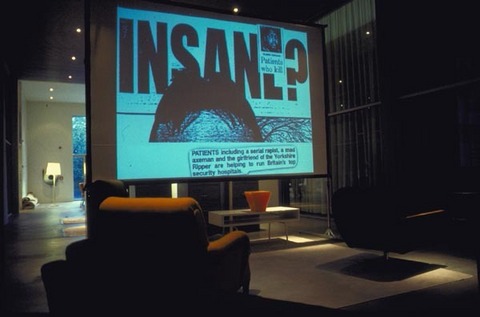
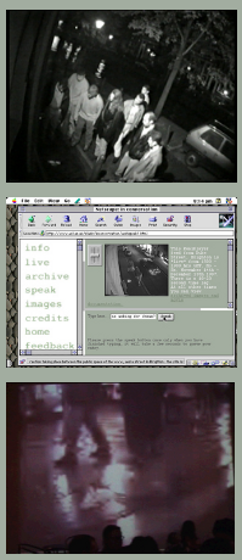
Without regular public funding, Backspace started out as an independent self-organised cybercafé. Initiated by James Stevens as a ‘soft space’ adjunct to his commercial web design business, Obsolete, it had a physical studio and lounge on Clink Street. People could drop in and use the web access and computer terminals in exchange for a nominal membership fee and commitment to maintain the space. What is notable about the Backspace model is how it attempted to foster a co-operatively managed resource. It exemplified a preoccupation amongst internet culture devotees with autonomy and new forms of governance, and struggled with all the contradictions of such ideals alongside the fact of its commercial parent entity. Obsolete shared its (at that time) capacious bandwidth. This gave people web hosting and streaming capabilities that would otherwise have been prohibitively expensive; allowed for the hosting of many artistic projects produced within the space itself; and facilitated many early streaming experiments with link-ups between other European media labs including as E-lab in Riga, Lativa and Ljudmila in Llubljana, Slovenia. Early attendees and co-facilitators of Backspace now list some central figures of the Digital and New Media art fields including: Matt Fuller, Simon Pope, Armin Medosch, Heath Bunting, Ruth Catlow, Pete Gomes, Manu Luksch and Thomson and Craighead – even Turner Prize winner Mark Lecky was a regular for a while.
Globally distributed discussion networks provided a discursive layer for these media labs, with early mailing lists such as Nettime, Rhizome and Syndicate forging international connections around technology, art and politics. Likewise, Mute (at first a newspaper, then a glossy magazine, now a web journal) provided regular critical commentary on burgeoning digital culture.
Foundationally different, Artec and Backspace were united by a belief in the importance of access to tools and training within a social context. In slightly differing ways, they put creative experimentation and social concerns at the centre of the agenda via technology. This was to become an important organisational strategy for this sector. Though both spaces have since closed, Stevens continues to build social and technological infrastructure as Deckspace, at Borough Hall, Greenwich. Without a physical space, Frank Boyd has evolved his media lab system into an industry-orientated programme called Crossover, which assembles creative professionals to workshop cross-platform ‘experiences’ from a variety of creative arenas including film TV and the computer games industry. Crossover is one of many peripatetic media lab models that privilege collaborative creative processes, although it is more goal-orientated than most as participants often pitch to a panel of industry commissioners.
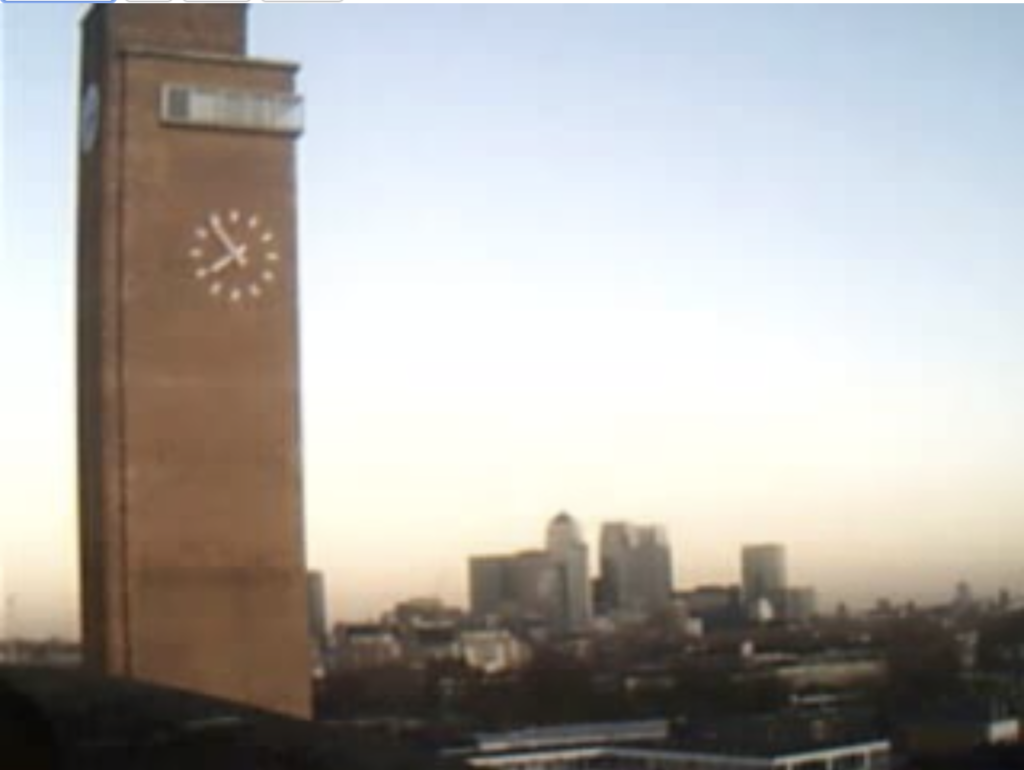
Process over Product
With less of an eye on industry and an abiding interest in the creative process itself, PVA MediaLab was formed in 1997 by artists Simon Poulter and Julie Penfold. In its first incarnation, it took up residence at Dartington College of the Arts, with funding from South West Arts. While there, artists were offered a well-equipped space in which to experiment with technology and develop ideas. In fact it is this developmental freedom that forms another core operational component of the media lab. Rather than asking artists to arrive with pre-formulated projects, or expecting them to see a piece through from start to finish, media labs have consistently placed value on self-determined exploration. PVA helps artists to manufacture methodologies rather than final artworks, fully designed products or content packages. They have also led the way in assisting other media labs to produce a similar system, through their Labculture programme. Highly itinerant, the Labculture model adjusts itself to host organisations, like Vivid, in Birmingham, so they can learn how to set and achieve goals while building the sorts of lasting partnerships that will sustain future activity.
This shared or Open Source way of working integral to media lab culture is also exemplified by GYOML (Grow Your Own Media Lab). A collaborative project between media labs Folly, Access Space and the Polytechnic, GYOML was designed to help generate more media lab initiatives. It has included: ‘GYOML in a Kitchen’, a sound recording and editing workshop by Steve Symons (Lancaster); ‘GYOML in a Van’, which staged an introductory workshop in media-lab culture for community group leaders (Lancaster); a game-centred ‘GYOML for teenagers’ (Rochdale); and ‘GYOML at the Canteen’, catering to film-makers and professional artists with an interest in open source (Barrow-in-Furness). Legacies of this project include the Digital Artists Handbook, an impressive guide to Open Source tools and techniques and ‘Grow Your Own Media Lab (the graphic novel)’, a set of inspiring case studies. Folly continue to work very much in this manner, forming essential infrastructural relationships as and where needed and guiding others through the adoption of free software.
Another example of this attention to operation and openess comes from GIST Lab, in Sheffield, which energises community-based projects through a space that hosts meetings and workshops. Even without a dedicated tech suite, their knowledge-exchange is a short-cut to all manner of original cross-over work, and they have supported yet another project that literally and metaphorically recreates aspects of the media lab model. 3D printing (or rapid prototyping) is increasingly popular in producing anything from car parts to jewellery, by layering materials like plastic into finished three-dimensional objects. RepRap, however, is able to print the spare parts it needs to be built while it is still itself under construction. Just like media labs, this self-replicating 3D Printer is all about sharing access to a successful system.
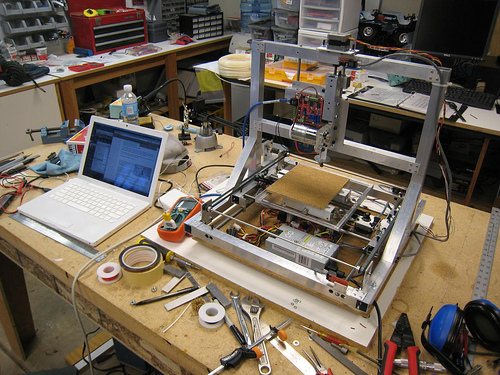
If media labs are not driven by material production, neither are they all about technology. Arising from the work of the art group, Redundant Technology Initiative, Access Space in Sheffield established its media lab through the use of free and recycled technology and learning. Given our cultural predisposition for wanting the latest, fastest equipment and our reprehensible dumping of perfectly serviceable technology, abundant hardware is sourced from all manner of locations. The latest Free and Open Source software is installed on the hardware where expensive proprietary software once lay and the media lab space, complete with this equipment, is opened to the public five days a week. The one proviso placed on this access – continuing the recycling theme – is that once a media lab participant has learnt how to do something, they should pass this knowledge on. As evidence of the success of this system Access Space boasts impressive outreach capacity: more than a thousand regular visitors, of which only about thirty-five percent are university educated, and over half are unemployed, and they habitually work with people experiencing disabilities, learning disorders, poor health, homelessness or other measures of exclusion.

One of the projects that clearly shows what they do is Zero Dollar Laptop, a collaboration with the Furtherfield organisation and community. Through a series of workshops, homeless participants are given the ability to use and maintain a free laptop complete with free software in self-led creative projects. It is this model of learning through self-directed creativity that arises again and again in media labs because it provides demonstrable results in helping people acquire and retain the skills they need. Without ‘bells and whistles’ new technology, Access Space emphasise the importance of ideas over technology and demystify all manner of computer-based skills. SPACE Studio’s MediaLab is also an excellent example of a lab working at a range of levels to offer beneficial specialised training. They teach software packages at a professional level to film makers, artists and a range of media industry workers, as well as offering film-making and media training for NEET (Not in Education, Employment or Training) teenagers in the local area. There are also a number of DIY Technology workshops including those regularly hosted by MzTEK who have expanded their operation as a result of their connections with SPACE. MzTEK are all about encouraging women to build technical skills and enter the new media sector. Growing from a small group to wide and supportive network they answer underdeveloped areas of knowledge. In addition to this, SPACE’s PERMACULTURES residency series has, to date, hosted eight residencies supporting over eleven artists, helping them explore technology and go on to show in a range of spaces.


The media lab also plugs an important gap in the art gallery and museum network. Digital and New Media arts are distinctive for collapsing boundaries between the place of production and exhibition. As a result, few existing art spaces have been in a position to fully represent it. Media labs, as well as community websites like Furtherfield and Rhizome, international festivals including ISEA and Transmediale and curatorial resources like CRUMB (the Curatorial Resource for Upstart Media Bliss) have imaginatively responded to this situation. Media labs in particular have been very successful in fostering relationships between artists and galleries. They have helped to translate not only the ideas expressed by this type of art – which can require much additional contextualisation – but also their physical installation in spaces not designed for this new breed of work.
For example, Folly recently collaborated on an experiment in the exhibition and acquisition of New Media art with the Harris Museum and Art Gallery. Entitled Current, the project saw expert panels first select works to be exhibited at the gallery (in Spring 2011) and then choose one to enter the permanent collection. Not only did this give the gallery the chance to add a timely contemporary work to their collection but it formed a useful public case study showing other institutions how they might engage with emergent art forms in various new media.
Media labs greatly contribute to the collaborative working methods the creative sector now thrives upon. Cross or interdisciplinary partnerships involve people from very different industries or working cultures combining and even reinventing the way they work in order to unearth all manner of new practices and products. Many universities, having born witness to a boom in research which straddles different academic subjects and industry sectors (due in some part to government funding imperatives around ‘knowledge transfer’), have established their own media labs. A relatively early example of this was i-DAT (the Institute of Digital Art and Technology) at the School of Computing, Communication and Electronics at the University of Plymouth. A large project with many interrelated strands is their op-sys (operating systems) network of research into architectural, biological, social and economic data and how it can be made publicly available and useful. The University of Nottingham has the Mixed Reality Lab, which was established in 1999 with £1.2 million in funding from the JREI (Joint Research and Equipment Initiative) programme as well as ongoing grants and investments. Run by Steve Benford, it hosts around eighteen PhD students providing resources for researchers and post-graduates working in areas that intersect its host department, the School of Computer Science, and associated training facility, the Horizon Doctoral Training Centre. It maintains a number of diverse projects, some of which have won prestigious awards and award nominations including Can You See Me Now, a collaboration with Blast Theory. The CoDE (Cultures of the Digital Economy) Institute at Anglia Ruskin University in Cambridge has a digital performance laboratory that focuses on sound-based work. Culture Lab is Newcastle University’s bespoke unit of media-lab-style flexibility, where artists work experimentally and across disciplines, and Sandbox, a similar resource, is located at the University of Central Lancashire. Another approach for universities is to partner with existing media labs. Pervasive Media Studio, a Bristol-located media lab, was set up by Watershed, a cross-artform production organisation, HP Labs and the South West Regional Development Agency. They have a partnership which runs for three years with the University of West England’s Digital Cultures Research Centre and work in a number of different ways including offering Graduate and New Talent residencies for those just starting out in their careers. The Pervasive Media Studio has helped to establish events like Igfest, the Interesting Games festival, held annually in Bristol, as well as development platforms such as Theatre Sandbox, which helps theatre makers introduce technology to their practice. They also support artists, including: AntiVJ, Duncan Speakman and Luke Jerram.
As we have seen, some labs have been nomadic or temporary while others have evolved into new incarnations. A media lab might be part of an array of dependencies with institutional responsibilities i.e. Folly, Isis Arts, Lighthouse, Pavilion, Pervasive Media Lab, PVA, Vivid and more, all of which regularly produce an abundance of quality experimentation in Digital art and culture. While new incarnations of the media lab may respond to three distinct but related phenomena: the rapidly evolving technology sector; the transient networks of geeks and digital experimenters; the need for sustainable models for innovation in industry. MadLab, in Manchester, provides space and facilitates meetings and workshops for ‘geeks, artists, designers, illustrators, hackers, tinkerers, innovators and idle dreamers’. Their ‘drop in’ events, commonly known as ‘Hacklabs’ (for example *Hack to the Future* during the Edinburgh International Science Festival), give people instant hands-on experience with all sorts of code and kit. Although hacking is still seen as a specialist and somewhat murky activity, the term is being increasingly decoupled from its conventional criminal associations and made accessible to mainstream arts territory. In January 2011 the Royal Opera House facilitated a ‘Culture Hack Day’, bringing cultural organisations such as the Crafts Council and UK Film Council together with software developers and creative technologists to usefully open up and share data. Other HackLabs may have less of an arts focus, but do have impressive resources built using the open membership model (pioneered by the likes of Backspace). The London Hackspace boasts a laser cutter, digital oscilloscope and kiln, all donated or collectively purchased.
Scattered through many of our city centres are office/studio-based working spaces which cater to the creative industries by offering flexible working environments and abundant networking and training opportunities. The Hub, in London’s Islington and Kings Cross areas (with up to thirty further Hubs in cities across the globe), gives fee-paying members access to facilities and a way of working orientated towards connecting people from across the network in cost-effective innovation. These spaces are indicative of the emphasis placed on the creative economy as the big hope for economic renewal driven by small entrepreneurs grabbing and shaping the opportunities in technology, entertainment and design.
Inspirational before Institutional
Looking briefly at some of the ways media labs have operated since the 1990s shows them as uniquely fertile spaces for all manner of shared expertise and creative innovation. They have made a fundamental contribution to Open Source culture. Working as openly and collaboratively as possible, participants have found ways of sharing process and product, while an interdisciplinary nature has revealed a plethora of creative possibilities. Fulfilling a difficult remit by offering a home for many of the emergent artistic practices currently transforming artistic activity, they have led us away from ‘art for art’s sake’ and towards work which has demonstrable meaning and lasting social and economic benefit. Large institutions might be extremely well-versed in mounting financially advantageous blockbuster exhibitions, but the beauty of media labs derives from their ability to develop and disseminate the socially-transformative systems that have already and will continue to shape the future of the arts.
A big thank you to everyone who contributed to this research despite their incredibly busy schedules and a special shout to: Simon Poulter for pulling over his car, Clive Gillman for kindly kicking things off, Sarah Cook for an innovative approach to note sharing and Peter Ride for not taking a lunch break.
You can find Charlotte’s original article on Collaboration and Freedom – The World of Free and Open Source Art http://p2pfoundation.net/World_of_Free_and_Open_Source_Art
As part of the Furtherfield collection commissioned by Arts Council England for Thinking Digital. 2011
Andreas Broeckmann writes on art, machine aesthetics, and digital culture. He is director of Leuphana Arts Program at the university in Lüneburg, and has played key roles at transmediale – festival for art and digital culture, ISEA2010 RUHR, TESLA-Laboratory for Arts and Media, Berlin, and V2_Organisation Rotterdam, Institute for the Unstable Media. Lawrence Bird interviewed him on our current experience of media and civil society. Image: A. Broeckmann, transmediale 2007 (© Jonathan Gröger)
Lawrence Bird: It’s often said that we inhabit the city differently today because of our engagement with media and media technologies. This has been one of your main concerns, and it makes for a very interesting intersection of media theory and public realm theory. Where does this preoccupation come from on your part?
Andreas Broeckmann: I have arrived at these questions not so much from a theoretical or academic perspective, but in response to specific artistic practices that I was interested in. For my own thinking about this area, the works that the artist group Knowbotic Research were working on in the 1990s were seminal. The participative public installation “Anonymous Muttering” (1996), for instance, initiated a radical clash of the physical urban space with the virtual ‘space’ of the internet, interlacing the activities of the participants in a way that created a strange intermediate zone – maybe we could say that it allowed people to place themselves _in_ the medium. In the series of projects that followed under the title “IO-dencies” (1997-99), Knowbotic Research further explored the possibilities of becoming active, of acting in a virtual environment in a manner that was connected to activities and events in the physical space.
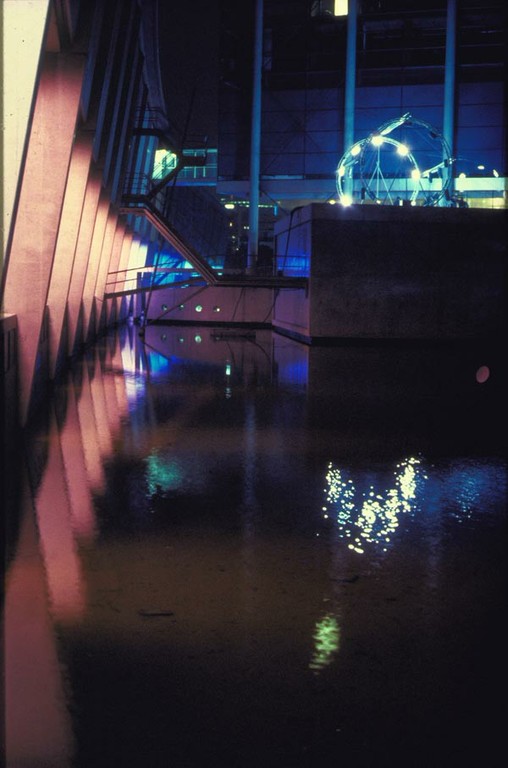
I was working quite closely with the group at the time, presenting some of the projects in Rotterdam where I was a curator at the V2_Organisation, co-authoring texts, organising workshops, etc.. This was a great opportunity to think through the issues of the new, hybrid public sphere that was opening up because of the Internet. In order to understand the works, it was necessary to develop a differentiated conception of what it meant to “be public” or to “become public”. The topic returned, for instance in projects I was involved in by Rafael Lozano-Hemmer in Rotterdam, or a publication on Polish video art by the WRO agency, or a major curatorial on a media facade in Berlin, or, for that matter, more recent projects by Knowbotic Research, like “Be Prepared Tiger”, or “MacGhillie”. Personally, I believe that privacy in all its guises – from camouflage and the absence of surveillance to “a room of one’s own” – is one of the great privileges of a modern individual. Contemporary media and communication technologies have transformed the possibilities of being private dramatically, just as the notion of what it means to be public is subject to drastic changes. And artists are articulating these changes which we are all part of, giving us opportunities to reflect on what is going on, and to imagine how things might also develop otherwise. I think that my interest in the relationship between publicness and intimacy is fed both by a personal sense of urgency and and concern, and by the inspiration I get from artists, not to fall into despair.
Lawrence Bird: Fascinating. So would you say that in the direction media are now evolving, there’s actually an increased scope for private “being” — not just in terms of a potential for increased anonymity and independence, but in terms of a richer and more developed individuality? To a greater degree — or perhaps qualitatively different — than was possible in earlier stages of modernity?
Andreas Broeckmann: Unfortunately not… I say that privacy is a privilege exactly because it is becoming such a rare condition these days. The developments that we speak about are, of course, not unidirectional and homogeneous, but very diffused and heterogeneous, and open to quite different interpretations. For many people, a platform like Facebook or Google-Plus is a way of discovering a new form of sociality in which they try out different ways of being public and being private.As for myself, having been brought up with the Critical Theory analyses of the Frankfurt School, I find it difficult not to see these optimistic readings as dangerously naive – it would be a bit like exploring your inner self in the highly regulated and commercial spaces of a shopping mall… I would not go so far as to say that privacy has completely disappered — as though we were now living in a global village of Big Brother containers, or in a vastly extensive version of the Truman Show. But I do think that today we lack a more widespread critical sense of resistance to the regimes of commodification that have taken the place of what were once “privacy” and “social relations”.
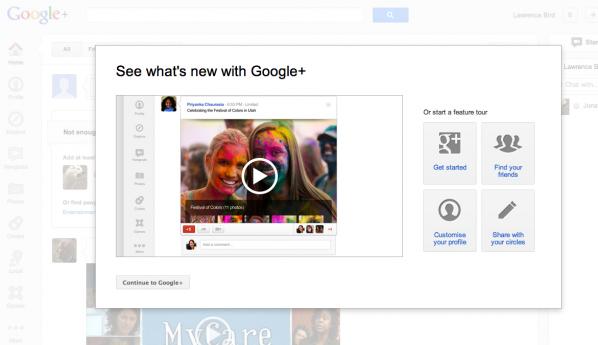
Lawrence Bird: You spoke about the concern of “falling into despair”. How general would you say that motivation is? I don’t know if you’ve thought about it this way, but I’m thinking in terms of Occupy, and the other social movements, many of them enabled by media and engaged by artists, which seem to generate new, and some evidence suggests quite lasting, relationships of trust and hope. Many of these seem to come in response to a recent loss of faith in corporations, governments, financial institutions — older social groups that had an important role in old definitions of “public”. I wonder if your comment connects with a widespread yearning for hope, in response to conditions that might well produce despair?
Andreas Broeckmann: I dare not speculate about the longevity of the relationships that have been built by the different branches of the Occupy movement, but I am skeptical about the longevity of anything that is built on specific internet-based media platforms. Facebook, for instance, was launched in 2004, that’s eight years ago, and the German and many other non-English Facebook services are no older than four years. That’s a very short time, and we might want to remember that platforms like Google (*1998), Facebook, Flickr (*2004) or Twitter (*2006) are not part of the natural environment, but recent services offered by profit-oriented companies which, just as well as they may rule the internet world throughout the 21st century, might also get drowned in the swamps of global capitalism (whose regime includes “customer confidence”).
I would refute the assumption, implicit in your question, that many of the people who protested on the squares in Madrid, Cairo, Washington or Athens last year were people who previously had faith in their governments, or the institutions of capitalism. Of course they didn’t, and quite rightly so. What was special about last year was that there is a new, articulate generation of people who would not put up with the situation of stasis, hopelessness and frustration that has paralysed major parts of global societies since 2003 when, in February of that year, millions who took to the streets around the world in protest, were not able to stop the US government and their allies from starting the war on Saddam Hussein’s Iraq. The inflection of this event is different in different parts of the world, but I believe that we share that moment. And this is where the protests in the Arab countries, and those in Spain and Greece, hit the squares on a parallel trajectory: In the same year of 2003, the German government started the implementation of what was called the “Agenda 2010”, a project based on the EU’s 2000 Lisbon agreement of economic restructuring, with the aim of making Europe more competitive on the global market. Since then, in Germany we have seen an erosion of the welfare state, drops in income for lower and middle classes and a huge increase in precarious jobs. But some economists also say that the reason for Germany’s relatively healthy economic situation today, compared with, for instance, Greece or Spain, is that these countries failed to reform their debt-pampered economies. Which is why there is a certain reluctance today in Germany to protect privileges for the Greek middle class, privileges which German citizens already had to give up years ago.
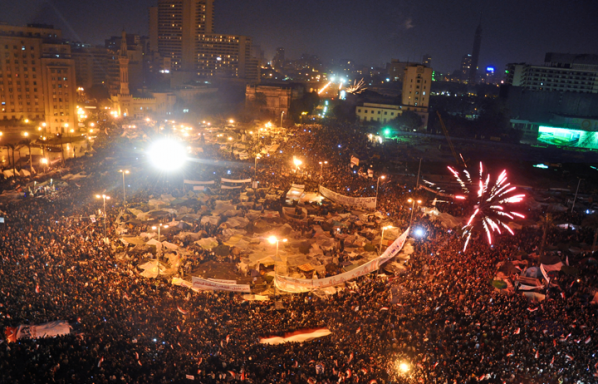
above: Tahrir Square on February 11, by Jonathan Rashad (CC-BY-2.0, 2011).
My point is that if we take things into a more extended historical perspective, and if we count our lives not in short Twitter months, we can see how the struggles, the hopes and the despairs of today are part of a broader set of transformations. And we can see that in these transformations there are forces at work which have a huge inertia and which need to be worked on and battled with both patience and long-term strategies. Like any other revolution, and like in the theatres of the Occupy movement, the one in Egypt may have started on Tahrir Square and the mobilisation of people through media-based social networks, but to complete that revolution, a difficult and drawn-out political struggle needs to be fought. Maybe that is the necessary realisation that hit “the movement” this past winter.
Lawrence Bird: And what form might those long-term strategies take? It’s a huge question perhaps, but do you have any ideas about the shape this restructured public sphere might have to take, what forms of governance and participatory democracy for example, to sustain a more permanent change?
Andreas Broeckmann: Personally, I believe that for the foreseeable future many political struggles will continue to happen in the ‘arenas’ of political institutions like governments, parliaments and other election-based structures, in political parties, public administrations, in transnational and inter-governmental decision-making bodies, in trade unions and NGOs. It is a realm that will only partly be affected or influenced by the online world, and even if the emerging public sphere of the Internet and its social media forums implies a huge expansion and diversification of the mass media dominated public sphere of the 20th century, this expanded public sphere will not necessarily have a bigger impact on political processes than the ‘old’ public sphere did. The experience of the ‘movement’ in Egypt today might be analoguous to that of the APO (the extra-parliamentarian opposition of the students movement) in 1960s and 70s West Germany, i.e. realising the necessity of getting involved in existing state institutions (“the long march through the institutions”), which brought members of that generation to power some 25 years later in universities, in parliaments, in national governments. The relevance and standing of the new Egyptian parties is not proven or disproven in the first elections; it is decided when in ten or twenty years from now they may or may not have been able to change the social consensus about democracy, rights, and freedom.
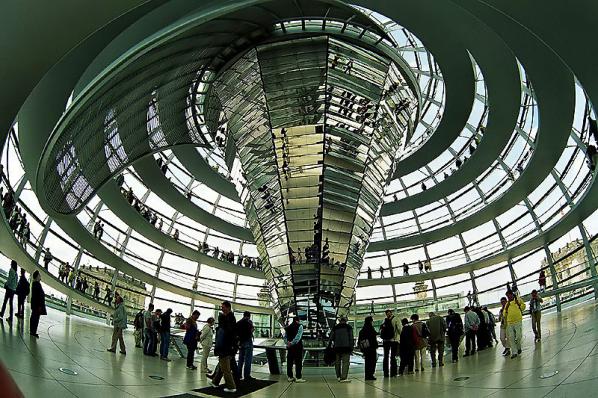
Lawrence Bird: A confession here: I’m an architect, so I always assume, perhaps naively, that a built infrasructure can play a role in these kinds of transformations. In your opinion, might a material intervention be a necessary part of those changes — distinct from, though perhaps in dialogue with, the mediated public realm? What kind of physical (urban) spaces might serve as a counterpoint or moderator to the transience of the Twitter world — and are those spaces any different from the urban spaces we have now?
Andreas Broeckmann: I doubt whether architecture in the narrower understanding of the term will play much more than a symbolical role in these struggles and transformations. Of course, the built environment, especially the way in which public space is configured, plays a significant role in how public life can unfold in cities. And there are political issues to be fought over: for instance, I find it curious how in many of the European cities the authorities allow the construction of one shopping mall after the other, pushing the social and commercial activity of shopping into privatised and highly regulated control spaces, and then those same authorities are surprised when the neighbourhoods in the vicinity of these malls deteriorate because the normal shops are abandoned or have to be closed, making room for trash and money laundering businesses. The resistance against such developments can at times most effectively be fought in local parliaments that, at least in Germany, have to give their consent to such major construction projects. This makes it necessary to join a political party, get elected into the local parliament, sit around in meetings, deal with all sorts of issues of public interest, etc., and be there when the application for the next shopping mall is up for decision…
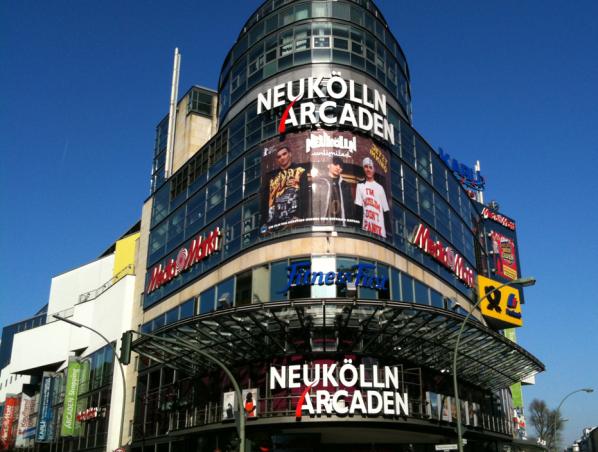
Of similar relevance is the designing of the digital sphere through software ‘architectures’ – both in terms of individual applications and services, and in terms of the overall technical infrastructure, both hard- and software, and its governance. The critical discussions around the status of ICANN and, more recently, the public protests against law-making initiatives like SOPA and ACTA, have shown that protests can in fact have an impact on such structures. Yet, that impact will remain cosmetic if the public outcry is not followed up by sustained political work through which the drafting of and the decision-making on such laws is factually influenced. This is what lobby groups do, and this is what social movements also have to do, finding whatever possible and suitable political instrument or institution through which to act.
The major arena of constructing and designing the new political sphere will be in law-making, and I believe that the movement needs critical lawyers, historians of economy and charismatic intellectuals more urgently than architects – although, of course, everybody has an important role to play and no-one who wants to contribute should be sent away.
Lawrence Bird: And how about artists — do they have a role in this? To provoke, perhaps? To articulate social and political conditions? Would you say that whatever that role is, it can be part of the sustained transformation you’re talking about — or do they need to step down into a governance role to take part in that (Vaclav Havel being one example).
Andreas Broeckmann: In my understanding of art, there is no particular role that it can, or even “should” play. I would argue that the most important aspect of art for society is its autonomy and the fact that it has no particular responsibility. Art can beautify, it can decorate, it can irritate, it can disturb, it can question, it can affirm, it can simplify or complicate. Such an “open program” of course implies that individual artists or groups, or specific projects, will take a particular political stand, will try to influence a social or political situation — will seek real impact. This is a form of activism that art can borrow from political groups and movements, but it is not the activism that is crucial for the artistic practice, it is the transgressive articulation that artists may achieve in their own dealing with social realities. I want to emphasize that this is my understanding of art, and I fully respect people who think that art can and must be more engaged in social processes in order to be relevant. But again, I think that what art can give us most importantly is what happens in a zone of freedom that is morally, aesthetically and sometimes also politically more risky than anybody who acts in the political arena — save for the mavericks — would want to be.
So the question, “what should artists do,” can in my understanding only ever be answered: “they should do whatever they do.” It must be the best thing that they can do, they have to be precise in their formulations and realisations, they have to be committed, diligent, and daring. It is wonderful if they can, in that way, help proliferate good ideas and push the political situation in a good direction. But by the same token I believe that it is equally wonderful if artists ask questions that are impossible to answer, or pointing out unsolvable ethical dilemmas, or remove the mask of an opponent only to don it themselves.
There is, in my eyes, certainly no obligation to go into politics like Havel did. Artists are not always people with a high moral reputation, and stepping into the political arena like Havel did requires stamina and a certain habitus. And there are many ways in which people can intervene in social and political processes. Take the example of Aliaa Magda Elmahdy who posted a photograph of herself naked on her website and sparked a huge debate about the situation of women in the Islamic world. This was not an art project, but it shows what work in the realm of symbols can achieve.
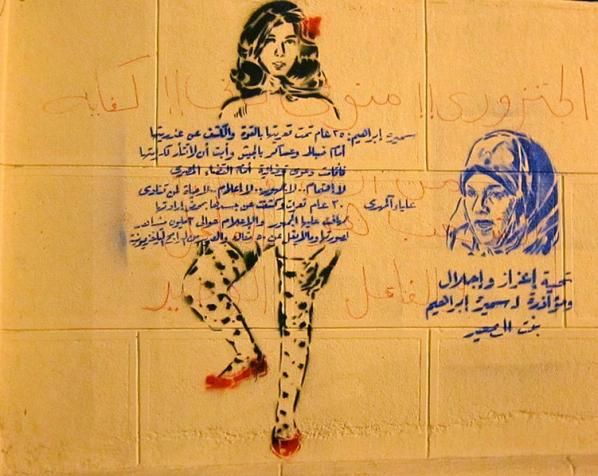
Lawrence Bird: If I could I’d like to steer the conversation in the direction of your thinking on “the wild” — perhaps it relates through the transgressive nature of art you’ve just been discussing, and the tricky relationship of that to civic functions, governance, and related realms of responsibility. Cities have been conceived as set apart from the wilderness — within the city lay the realm of humanity, civility, politics; outside its walls, the wild, monsters, raw life. Girorgio Agamben makes the case that the violence of our times equates to the obliteration of that line: between political life (zoe) and bare life (bios).
In light of what you’ve already said about art and transgression, and the value of that; and the precarious status of privacy today, and the danger of that; your understanding of media and the political movements underway today which involve some significant transgression of the boundaries of authority, I’m willing to bet you have a more nuanced take on this issue. What’s our condition now with regards to the edge of the wild? Is it a constantly shifting boundary, what Agamben refers to as the caesura? Does it imply a human condition interdigitated with an inhuman condition, like a werewolf, or cyborg? Does our humanity in fact find its source in the wild?
Andreas Broeckmann: The questions that you raise are of course extremely complex and very difficult to do justice in the current context. So allow me to shirk the anthropological discussion, which I guess I don’t have a particularly original opinion on anyway. When I spoke about the “wild” as an aspect of digital art a few years ago, it was in a half ironic, and half romantic way: ironic in the sense that art that makes use of digital media is technically conditioned and requires a “tamed” environment to function at all; even what is referred to as ‘glitch aesthetics’ is predicated on general functionality, the glitch being only a minor aberration, not a substantial fault. Yet, as you would gather from what I said before, I am also ‘romantically’ attached to the idea of an artistic practice that transgresses these technical functionalities and explores failure, dysfunctionality, misuse, or uncontrollability as categories of aesthetic experience. I’m thinking of artists like Gustav Metzger, Jean Tinguely, Herwig Weiser, or JODI, who in their works perform, we might claim, the potential wildness of technology. This is mostly a controlled, at times even metaphorical wildness, whereas the true wilderness of technology, if we want to go there, is probably the realm of the accident that Paul Virilio has so poignantly written about. An “art of the accident”, as we entitled a festival in Rotterdam in the late 1990s, is, I believe, only possible in the realm of metaphors.
What I’m currently wondering about is whether in our 21st-century cybernated world a notion of “nature” as something different from culture maybe disappears completely, as we have full Google-ised view and total measurability of what happens on Earth, from millimetre shifts of tectonic plates to carbon dioxide output of cattle. In such a world, there would be no room any more for the “wild”, only for different degrees of pollution on the one hand, and endangerment of species on the other…
In the long run I have trust in the finality of all existence, and the futility of all human efforts. But in the short term, that is, in our lives, I believe that we have to work to make the world a little better, or at least do our best to not make things worse than they are.

Part of Furtherfield Open Spots programme.
Please join us for a drop-in ‘clipsourcing’ workshop led by Swedish artist Josefina Posch in collaboration with artist and new media developer Mike Blackman (UK).
Using online tools specifically created for the project, participants will identify who the speakers are, contribute keywords, and rate short movie clips from the online public domain Film Noir Archive. The contribution will help shape the final interactive piece that will be streamed live at Futherfield Gallery in December 2012.
See images of the workshop on Flickr.
{crowdsourced} Noir / Love Beyond Recognition is a process-based artwork encompassing a sculptural installation and an interactive stream across the World Wide Web. The origin of both parts of the project is based upon the notion of ‘crowdsourcing’. The principle being that more heads are better than one. By canvassing a large crowd of people for ideas, skills, or participation, the quality of content and idea generation will be superior. In this instance, crowdsourcing will be applied through the use of clipsourcing tools which have been developed to aid in project-related tasks that can only be achieved through human interaction/intervention. This way, the crowd will help the artist achieve these tasks whilst adding a democratic element to the final outcome of the project.
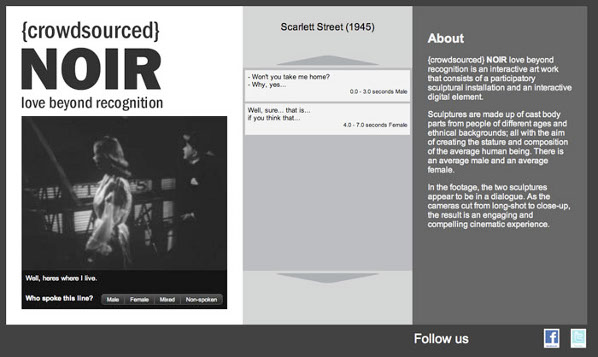
During Spring and Summer 2012, an interested public will be able to both participate and contribute to the project’s creative process in two distinct ways: in Sweden as models, whereby a cast will be taken of a chosen body part (the body parts will later be assembled to full figure sculptures) and in the UK by taking part in a workshop at Furtherfield Gallery to help source short clips from the Online Public Domain Film Noir Archive through our online tool. The final iteration of the project will be exhibited in Gothenburg, Sweden in December 2012 with live interactive streams at Furtherfield Gallery, London.
Josefina Posch
Josefina Posch is a Swedish artist that has worked and exhibited extensively abroad, including at the 52nd Venice Biennale, Fondazione Pistoletto’s Cittadellarte, Sculpturespace NY and a residency at Duolun Museum of Modern Art Shanghai. During her 3 month residency at Art Space, Portsmouth, in Autumn 2010, she began her collaboration with artist and new media developer Mike Blackman in the development of her digital concepts.
The project is supported by Arts Council England/British Council and the Gothenburg City Arts Council.
Lies, Lawlessness and Disbelief: An Attempt at Thinking Art and Capital is an essay by Canadian artist & critical thinker, Katie McCain. McCain discusses how capitalism has become on the one hand all-encompassing and on the other utterly unreal. Arguing that we need to focus on moments of paradox, illogic and the impossible in order to rethink capital, this essay explores and succumbs to the circuity of it’s own thinking. Drawing on a host of sources, it attempts to weave an account in which system failure is seen as a point of rupture, whether in legislation, bureaucracy or thought itself.
Moments of paradox are seen as a space in which to re-orient our capacity for thought, and in doing so find a place for art as a point of resistance. It promotes a negative approach to capital, a re-imagining of nihilism, and fosters a general penchant for the illegal and the illogical. Ultimately it seeks the expansive space contained within what is impossible or unknown, although this is known to be impossible.
Download PDF of Lies, Lawlessness and Disbelief: An Attempt at Thinking Art and Capital
Featured image: “Born in 1987: The Animated GIF” from the site’s page.
Marc Garrett interviews Katrina Sluis, the new curator of the Digital Programme at The Photographers’ Gallery, London. We discuss about the gallery’s recent show Born in 1987: The Animated GIF and what kind of digital exhibitions and projects we can expect from the gallery in the Future.
An edited selection shown on the London Photographers’ Gallery’s new digital wall, during the final weeks of the show. http://thephotographersgallery.org.uk/the-wall-2
The exhibition microsite. An open conversation where anyone can join in and contribute their own GIFs. http://joyofgif.tumblr.com/
Marc garrett: You have joined The Photographers’ Gallery and as part of the new digital programme launched the exhibition “Born in 1987: The Animated GIF”. Could you tell us about this project?
Katrina Sluis: The digital programme presents projects both online and offline, which respond to recent dramatic shifts in the digital image as it becomes increasingly screen-based and networked. As part of this new programme we have launched ‘The Wall’ – a permanent exhibition space on the ground floor of the Gallery, visible both to visitors and passersby on Ramillies street. The Wall itself is a 2.7 x 3m Sharp video wall which we installed after considering a number of different technologies. We were conscious not to use digital projection as it would locate the project within traditions of cinema and video art, and we wanted the screens to respond to the reception and distribution of images within wider visual culture.
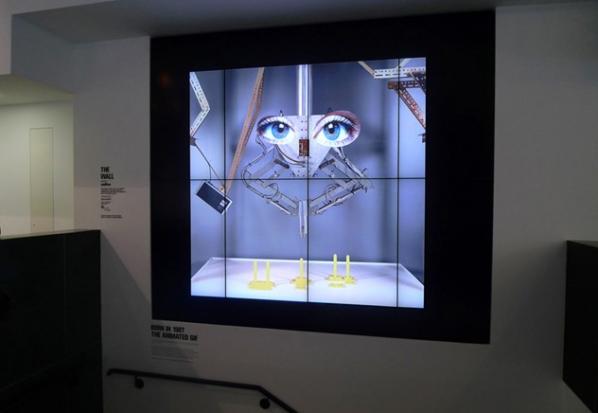
For the opening show, we decided to focus on the animated gif for a number of reasons. Firstly, the gif is a uniquely screen-based image format, in which the specific characteristics and limitations of the image file are inherent to the form, in contrast to the other kinds of images the gallery might show which might adopt digital techniques but result in traditional print-based photographic work destined for the gallery space.
I also wanted to disrupt certain expectations about the screens – the fetishisation of resolution and image quality, and what kinds of photographs The Wall’s programme might seek to address. The animated gif in this sense is very interesting – it is one of the first image file formats native to the web, and although it is 25 years old this year it has been undergoing a resurgence on platforms such as Tumblr. In a commissioned essay for the show, Daniel Rubinstein speculates that current resurgence of the gif “is not only part of the nostalgic turn towards the blurred, the unsharp and the faded but it is also a marker of a moment when the history of the network becomes the material from which the digital image draws its living energy.”[1] Frequently authorless and contextless, the gif image works on a different economy in which its value is based not on its uniqueness and scarcity (as in certain forms of art) but its circulation and proliferation. Although there have been significant practitioners of the gif form, it is a format which ultimately resists canonization. And, in the context of a photography gallery, it opens up other debates concerning medium specificity and the ‘post-photographic’.
In approaching the exhibition, I was keen to ask a diverse range of photographers, writers, organizations and other practitioners to contribute a gif for the show. In keeping with the unmonumental nature of the form, I asked contributors to respond within a short timeframe of 7 days. For many contributors, this was the first time they had made a gif; but other contributors already had large followings on Tumblr and some were established net artists. This opening show and associated Tumblr site (http://joyofgif.tumblr.com) became a starting proposition for the project in order to then open up The Wall to gif contributions from the wider public. We will continue to update The Wall with public responses on a daily basis until the final day of the show on 10th July.
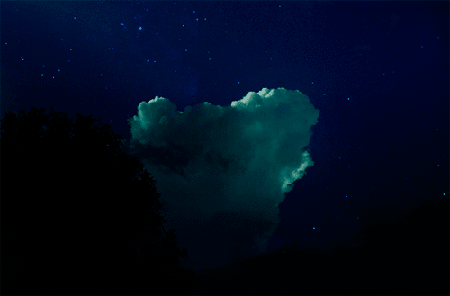
MG: At first, some may assume that the first part of the exhibition title ‘Born in 1987’, refers to the fact that today so many young people using computers these days were born in 1987. Yet, the GIF format, short for ‘Graphics Interchange Format’, was introduced to the world of computers by CompuServe in 1987. Was the title of the show deliberately playing with both notions?
KS: I like this idea! The title does self consciously play with the way in which the digital is valorised for its endless ‘newness’ and novelty but yet has this long and frequently overlooked history of creative experimentation. You can also see this reflected in the recent hype around the work of Kevin Burg and Jamie Beck who have (problematically and entrepreneurially) re-branded the gif as the ‘cinemagraph’.
MG: Do you consider this project to be net art, if so, how does it relate to other forms of net art?
KS: The project (and The Wall’s programming) does pose certain problems as it seeks to relocate certain forms of online practice(s) into the space of the art museum. At the same time, the project exists in an online context with its own very different life on Tumbr, where the work circulates in a very different context with a very different audience. I think there are many interesting opportunities which emerge from this intersection of the institutional frame of the museum (with its associated issues of cultural and curatorial authority and the legacy of aesthetic modernism) and the values and politics which inform certain kinds of networked arts practices.
But I also think the project also needs to be understood in the specific context of The Photographers’ Gallery, its history and audience. Whilst the project shares the concerns of net art by raising questions concerning authenticity, authorship and ‘the social’, it is also motivated by the need to rethink familiar notions of photography and temporality, indexicality and the economy of the image – concerns which presently haunt the field of photography theory.
![Kennard Phillipps. GIF image by Peter Kennard and Cat Phillipps. Born in 1987: The Animated GIF. The Photographers' Gallery 2012 [2]](http://www.furtherfield.org/wp-content/uploads/2012/07/fuck-the-markets-latest1.gif)
![Rad Racer glitch 3. GIF image by tracekaiser. Born in 1987: The Animated GIF. The Photographers' Gallery. 2012 [3]](http://www.furtherfield.org/wp-content/uploads/2012/07/tumblr_m5tqfl62wl1qew2moo1_400.gif)
MG: In what way do you see this form of creativity relating to others who may not be so well versed with net art culture, or digital networked practices?
KS: The Wall presents an opportunity for the Gallery to collaborate with diverse communities who can bring their distinct expertise and experiences to the programme, and the net art community has much to offer in this respect. For this reason, we aim to develop The Wall’s future programme through the framework of ‘collaborative research’, in which our audience, along with the organizations we partner with, are potential co-researchers. The co-researcher model developed as an approach to research democracy in the Social Sciences, particularly in the approach of Action Research in the NHS but in a more relevant cultural example was used extensively in the Tate Encounters: Britishness and Visual Culture research project. Co-research recognises both the collaborative and collective nature of meaning construction, through a process which attempts to trace and reveal the complex manufacture of meaning.
At the same time, there is still another related project to be done in highlighting and responding to digital projects whose life is online – this is of course something I admire Furtherfield for doing so brilliantly. On a smaller scale and with a more narrow focus, we hope to launch a blog which will draw attention to online work which relate to photography as it becomes polluted, valorized, hybridized and networked.
![GIF image by Paul Flannery. Born in 1987: The Animated GIF. The Photographers' Gallery. 2012 [4]](http://www.furtherfield.org/wp-content/uploads/2012/07/tumblr_m442xish4q1rvlji4o1_500b_0.gif)
MG: Some, may view this this exhibition as relating to Internet Folk Art. There is an interesting article by Kenneth Goldsmith[1] where he discusses the digital theorist Rick Prelinger’s claim “that archiving is the new folk art, something that is widely practiced and has unconsciously become integrated into a great many people’s lives, potentially transforming a necessity into a work of art.”
Now, this is not directly relating to the show itself, but it resonates something regarding the inclusiveness of the show. So, in respect of it ‘possibly’ possessing aspects of Folk Art, what connections do you see as relevant or not, and what does it mean to you?
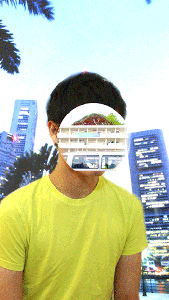
KS: By focusing on the gif the show does problematise the distinction between artist and audience, in which participation, openness and the ‘crafting’ of the image becomes key. However I have reservations about the use of the term Internet folk art, which could be construed as imposing a certain modernist logic on the discussion, burdening it with an analogue modeling of high and low culture. The research approach has been adopted precisely to avoid the trap of binary nominalism, and to problematise the tendency to shoe horn internet practices into the language of cultural studies and aesthetics.
MG: The Photographers’ Gallery was the first independent gallery in Britain devoted to photography and has been going since the 70s. It is the UK’s primary venue for photography and has been dedicated in establishing photography as an essential medium, representing its practice in culture and society. It seems that The Photographers’ Gallery is going through another transition. You have already mentioned how hybridized and networked the nature of future projects will be. So what kind of exhibitions and projects can we expect in the future?
KS: Because digital technology is not in itself a new photographic medium, but essentially a hybrid and converged set of technological practices, it raises many interesting problems, both theoretical and practical for a Gallery focused on photography. To the computer, the photograph is indistinguishable from the other binary blobs of data we used to call books, films and songs. The crisis of digitization and medium specificity now extends to the domain of the camera – Digital SLRs are coveted for their ability to shoot high quality digital video, and we turn to our mobile phones when we want to take snapshots. This is a very rich context for the programme to explore, and ideally the future projects will respond to the technical, creative and cultural languages of photography as produced by computer engineers, web developers, photographers, artists, networked communities, social scientists and other practitioners.
Our next show on The Wall (opening 13th July) features the practice based research of Susan Sloan into portraiture using motion capture and 3D animation techniques widely used in entertainment, medicine and the military. Her motion studies refer to the traditions and conventions of portraiture and the changing role of the camera as a recording device. At the same time, her work raises questions concerning the convergence of painting, animation, film and photography in the digital realm.
The future digital programme which will occupy different spaces and address various photographic practices including augmented reality, social media, electronic publishing, interactive media, mobile computing and synthetic imaging.
The Joy of GIF – the London Photographers’ Gallery’s new digital wall. Article by Wendy McMurdo.
http://www.foam.org/foam-blog/2012/may/photographers-gallery
Featured image: corporations are not people – the Overpass Light Brigade
Overpass Light Brigade in Tosa from Overpass Light Brigade on Vimeo.
Wisconsin has arguably been ground zero for union busting, DIY social movements, corporate takeover of government, and divisive – and often misinformed – political debate in the US for more than a year. And the Overpass Light Brigade (OLB), initiated by Milwaukee artists Lane Hall and Lisa Moline, have been a guiding light – literally – in how ground-up messaging and change can happen. Now a collaboration between many people, the OLB relies on an ever-widening community of activists, artists, thinkers, and do-ers for their “Signs of Resistance.” After a few rounds of local rye whiskey at Milwaukee’s Riverwest Public House Cooperative – one of the only co-op bars in the country – I did an email back and forth with OLB co-founder Lane Hall to find out more about what makes them tick, how they see themselves, and where the movement they are a part of is headed.
Nathaniel Stern: What is OLB? It feels more “struggle-” rather than “goal-” orientated, despite that its first mainstream recognition is in relation to a specific campaign. Can you talk a bit about its history: how it started, where it headed, and what it might become?
Lane Hall / Overpass Light Brigade (OLB): On November 15 of last year a rally was organized by grassroots groups in Wisconsin in order to kick off the Recall Walker campaign. It was to begin right after work, at 5:00 pm. Both Lisa Moline (co-founder of OLB) and I had been very active in what we now think of as the Wisconsin Uprising, and we asked ourselves the simple question, “How do we achieve visibility for graphic messages when it is dark at 4:30?” We began to tinker with off-the-shelf Christmas lights, and found some battery-powered strings of LEDs. We built our first sign, a 3′ x4′ panel that spelled out RECALL WALKER. When we arrived at the rally, we were immediately asked to be behind the speakers. That sign got on the Rachel Maddow and Ed Schultz show that evening, so we knew we had hit on something that afforded powerful visibility. That first sign is now, incidentally, in the archive of the Wisconsin State Historical Society.

We then proposed a second design challenge to ourselves: how do we get messages out to masses of people, since we can’t command the airwaves like Walker’s Koch-fueled campaign? Once we decided to go out on highway overpasses, we “scaled-up” the letters so that we could spell out words, refrigerator magnet style, one letter per 2′ x 3′ placard.
Our first night out was on an overpass in South Milwaukee. It was very cold, fairly miserable really, with freezing winds kicking up from the passing semi-trucks. We had a few fellow activists to help, and our idea was to bungee-cord the signs to the fence while we stood by. We were accosted by a right-wing nut, a Young Republican, who was vehement in his insistence that we were breaking the law by affixing the signs to the fencing. He ended up in a physical altercation with Lisa in his insistence to rip our signs off the fence as well as forcefully take Lisa’s video camera, since she was capturing his vigilante actions on video. When the police came, they did reiterate that nothing could be affixed to the bridges, though also supported our right to be there. From that night on, we realized that for OLB to work, we needed Holders of the Lights – one person per letter, as well as “spotters” for safety and a couple of people to take video and photos. This was a profound tweak of the original idea, in that it shifted our actions from mere signage to a form of witness or testimonial. It is very powerful to see one person per placard, positioned high above the highway, committed to the politics of physical presence.
We began to go out around the area, scoping out different overpasses, hooking up with different grassroots groups in Madison and Racine and Kenosha and Milwaukee. For about two months we took out RECALL to various locations, often getting hassled by people, questioned by cops, pushed to defend our rights to be out in these odd public spaces. We began to add letters and attract more volunteers who were attracted to our strange mix of Fluxus happening and focused message. RECALL WALKER, then 1% WALKER, then JOHN DOE (referring to an ongoing investigation into alleged campaign corruption when Walker was Milwaukee County Executive), then WALKER=JOBS FAIL and WALKER LIES and WALKER IS A CROOK, etc. We have always tried to index the message to what is breaking in the broader mediascape, so that there is resonance between multiple layers of information and our activist response.
Once Walker was officially recalled (he was “recalled to election”) things really picked up. We were getting invited to hold actions around the state – Madison, Fond du Lac, Portage, Appleton, Kenosha, Racine – and more and more people began to join us. The 2 hour overpass occupations began to take on a real festive quality, with people bringing food, making music, chatting, singing, chanting and enjoying the angry and happy honks from the freeway. Our messages expanded, and our Bridge Parties have become somewhat legendary, with anywhere between 40 and 120 people commonly showing up. We even have a bagpiper who often leads us on and off the overpass.
A big part of the success of OLB is its mediagenic quality. Photographs and videos have been distributed freely and widely, at times even virally. We’ve been highlighted in the NY Times, CNN, Time Magazine, the Milwaukee Journal Sentinel, countless blogs and Facebook sites too numerous to even itemize. Our Facebook “reach” was hitting 182,000, and I was getting constant queries about the project. Our community of activists is extremely diverse, which is one of the things I am most appreciative of. It is odd how powerful holding a sign over a highway is, how many conversations happen in the two hours of bearing witness, and how compelling the action remains for our volunteers.
We immediately went out the night after the disappointing results of the recall. I felt that what I call “essential visibility” was even more important for the progressive community. WE SHALL OVERCOME and SOLIDARITY FOREVER graced the bridges, and we subsequently began to help some striking workers in Milwaukee pizza factory with BOYCOTT PALERMO’S. Since the recall, I feel we have gotten stronger and deeper, no longer relying on the easy binary of our disaffection towards our tea-bagger governor. Our issues are bigger and broader, more national. We just went out in Madison with CORPORATIONS ≠ PEOPLE and 56 volunteers showed up, along with some projector-shine activists, live-streamers, and a phalanx of videographers. We have also taken out QUESTION AUSTERITY and are integrating it with a social media #questionausterity campaign. I see the synthesis of physical and virtual space as the future of OLB actions, as well as our growing ties with the Occupy movement.
NS: This is more than inventive campaigning or even creative activism, but protest art with heavy political, aesthetic, ethical, and technological implications. The Graffiti Research Lab was first to use high technology to ask, “Can any public space be a blackboard?” You take that as given, provide the chalk, and ask for important messages to be broadcast on said blackboards. I’d like for the both of you to write a bit about your practice as artists, as activists, where they are one and the same, and where sometimes they differ.

OLB: The Graffiti Research Lab is a continued inspiration for us in terms of their open-source ethos, and their bold pushing at the “public” aspect of “public space.” I have great admiration for what they accomplished, yet have always felt frustrated that their messages generally stayed within existential parameters. That is, their presence in urban space was implicitly political, but their projections were generally, “I exist” with variations on the theme such as “Fuck you!” However, the way their events brought people together in the streets is also noteworthy. OLB has achieved some of these same dynamics, though with very directed and explicit political messaging. We are a fluid mix of relational aesthetic, Fluxus happening, street party and progressive messaging, all part of an inherently ethical practice. We think of ourselves as “the people’s bandwidth,” having found an open venue that takes a lot of dedication but only a small outlay of capitol, which is intrinsically public to thousands of passersby.
Our own work has been collaborative for a long time. Before the Wisconsin Uprising, our art – often about environmental issues and animal subjects – was implicitly political, but rarely pushed the boundaries of sanctified institutional spaces. Once the Uprising began, we got very involved with activist work, and took our creative efforts to the streets. We were inspired, set up a PAC called The Playground Legends with some other activists, and began working within some of Milwaukee’s African American communities on voter education and Get Out The Vote campaigns. We set up “parties in the parks” for neighborhood groups, and used these relational activities to help create cohesion around a political purpose. This was exhausting and finally not sustainable for us, but some larger groups such as Wisconsin Jobs Now emulated our inventiveness and have really made a difference in spite of the Right’s coordinated campaigns of disenfranchisement.
After working with this PAC, and struggling with the official requirements of a 501C3 and meetings with minutes and budgets and fundraising and reports, we chose to make OLB as flexible and open as possible. We are a loose affiliation of activists who show up on bridges and hold signs. It is very simple. Anyone can join. All ideas are welcome for consideration. Our community of activists is really the heart and key to sustainability with OLB. Most of them don’t care whether this is art, or what the cultural precedents might be. All of them value this odd form of engagement, where they can see a beautiful and directed message reflected back through social media, and be a part of a much larger – and historical – emergence of a progressive political movement.
NS: Who do you want to follow your lead? Who do you want to help OLB progress to more innovative interventions? How can we help you help us?
OLB: We freely share the instructions for making the signs. They are very easy in concept, very DIY, and need only basic wood shop fabrication skills, akin to stretching canvasses or making a woodcut print. However, each sign does take a lot of concentrated construction, which can discourage some who have wanted to create their own. So far, we have 3 different chapters that have taken to the bridges: OLB-Fox Valley, OLB-Dane County (both in WI) and OLB-Harrisburg. We’ve also seen other iterations, such as a Madison based “Sign Brigade” doing daytime roadside actions. I see that OLB has a function as a model of empowerment, as well as the joy (or anger) one gets from seeing a message “done up in lights.” One thing that hasn’t happened yet is an ongoing series of “hacks” that extend and expand the idea. The off-the-shelf lights get expensive. Could someone figure out how to make battery powered (not big battery + inverter, but lightweight AA batteries) LED light strings so that we could build our own? How about other variations? This would be great to see, especially now that the Graffiti Research Lab’s open inquiry with LEDs seems a thing of the past.
NS: What have been some favorite moments from the bridges?
It always amazes me when some random stranger pulls off the highway and comes to find us. Sometimes, especially at first, this would mean trouble, in that aggressors would want to direct anger at us. But one night in the bitter cold weather of January, an African American man came up to the bridge, told us he saw us and wanted to give us a gift, and offered each Holder a beautiful knit hat. He was a salesman of sports clothes, and had a lot of hats. We each left that night with a new Milwaukee Bucks hat!
Another time, just a few weeks ago, two women – an older woman and her adult daughter – came up to the overpass. Both were public school teachers. The teachers have been so demonized in Wisconsin – it is both ridiculous and shameful, but it obviously works to divide us, and as obviously takes its emotional toll on these new “enemies of the state.” The older woman exclaimed that they were “so grateful to see us out there doing this” and she burst into tears. There were lots of hugs and they hung around for awhile, held a couple of letters, and left. It was very moving, as a lot of our Holders are themselves teachers.
We also hosted the famous “Nuns on the Bus” tour – the politically progressive group of Sisters who are going around the midwest to decry the austerity budgets of Paul Ryan and the Republicans. It was amazing when their bus pulled up by the overpass, and these elderly activists (along with the powerful Sister Simone) approached the bridge and saw the QUESTION AUSTERITY message we had created just for their tour. There were 96 people on the bridge that night, and they all sang happy birthday to one of the Sisters since it was her 72nd celebration that day. That was a wonderful event, and a great example of diverse activist communities coming together based on these joyful actions.
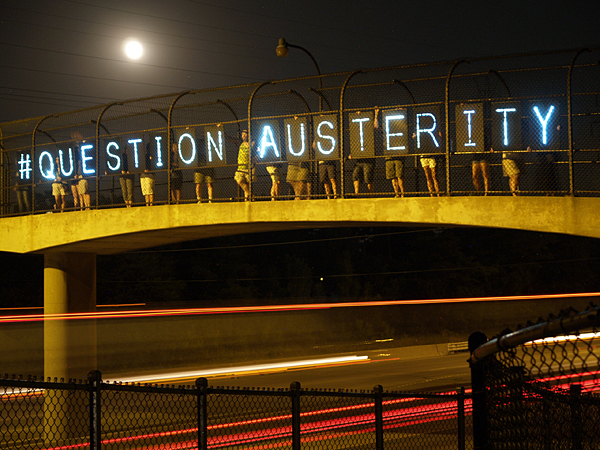
I could go on and on. Each action, each Bridge Party, is a whole narrative – interactions with police, with passersby, with neighbors both supportive and critical, and now and then with aggressors who have busted out our car windows or tried to shut us down. But it is all powerful, all a microcosm of the rifts in our country. The bridge is a forceful metaphor beyond its commanding physical presence over the geospatial distribution network function of our highways. It works both linguistically and architecturally, and affords a curious perch for our loose affiliation of committed brigadiers.
NS: How can we make our own stuff?
OLB: Check out our new site at http://overpasslightbrigade.org/
You can also find “noise of rain” posts on the Daily Kos site
http://www.dailykos.com/user/noise%20of%20rain
Featured image: “All Hail Damien Hirst!”, Tamiko Thiel, 2012. Turbine Hall, Tate Modern, London.
Interest in Damien Hirst and his commercialized, celebrity status is well known. So when we heard that Tamiko Thiel was making the artwork “All Hail Damien Hirst!”, we were immediately curious. Hirst is an extremely rich individual with powerful allies within wealthy, traditional art establishment circles. This includes Charles Saatchi, and commercially dedicated art mags and art institutions whom have all successfully helped in marketing his particular brand as part of their own economic strategy. With this in mind and acknowledging the potential risk in satirizing a well known art celebrity we thought it was a good idea to interview Thiel about her ideas and experience on the project?
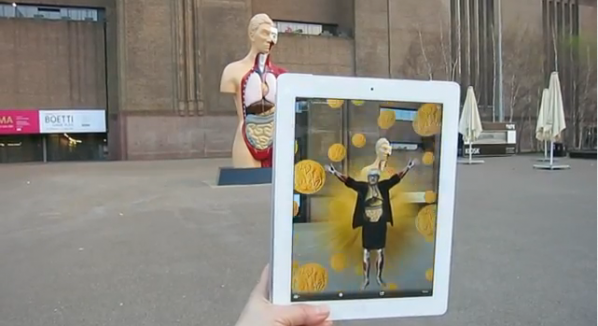
MG: Many are curious about your new augmented reality project “All Hail Damien Hirst!”. It is an art installation and intervention. Why have you chosen to create an artwork aimed specifically at him, during his retrospective exhibition at the Tate Modern?
Tamiko Thiel: As a visual artist my projects start with having a strong image in my mind’s eye that compels me to pursue the project further. When I heard of the retrospective at the Tate I immediately had an image of Hirst – depicted in a style relating to his own working methods – hovering in the vast space of the Tate Modern Turbine Hall. On findng out that the space was not going to be used except for the small room housing his diamond skull, I saw an opportunity to give visitors an experience that would utilize the space beautifully, compliment his own work and bring the contradictory feelings that many have about him and his work into sharper focus.
In my own work I often draw on the power of religious imagery. This aspect of Hirst’s work, and also his themes of the body and death, are very compelling to me. On the other hand, he plays a master hand at making the art market dance to his tune. I find the market value of his carefully ordered spot paintings, for example, in marked contrast to the artistic power of Yayoi Kusama’s spot obsessions, which were exhibited probably not by coincidence at the same time at the Tate Modern.
To top it off, while flipping through a United Airlines onboard magazine I chanced upon an image depicting the value of Hirst’s artworks as an exaggerated – and spotted – version of the movement of the stock market:

I wanted to make a work that addressed multiple issues surrounding Hirst as a person, as an artist and as a force in the art market at a time of extreme tension in the world’s financial markets. I knew however that Hirst is very litigious, so I was careful to use none of Hirst’s actual artworks, so I do not infringe on his copyright!
I had done an earlier augmented reality work, Reign of Gold, as part of the AR Occupy Wall Street project. In this work, viewers all over the world can chose the site at which to view the piece on their smartphones, and then see an animated rain of gold coins superimposed over the live camera view of their surroundings. I have photos of this work against the New York Stock Exchange, the Bank of England in London, TEPCO in Tokyo – the company that brought us the Fukushima nuclear disaster – and other choice sites around the world. You will see a clear visual relationship between the rain of gold coins and Hirst’s spot paintings, which many say are destined to go through a similar boom and bust cycle as are the world financial markets.

If I was a painter I would’ve gone off and made a painting, and that would have been the end of that. Since I work with augmented reality however I could place the image in and around the Tate Modern itself, the very site of Hirst’s exhibition. This puts a whole different spin on the artwork, as having an artwork “in” a prominent arts venue is seen as a form of “canonization” in the art world, even if the artist places the work there by him- or herself, as did Banksy.
This brought in yet another level to the project, as the work functions now not only visually, but by dint of its location also questions the system by which the art world consecrates artists and artworks. What does the location of an artwork mean, if every artist decides for herself where to place the work? Walls cannot keep us out, nor can walls keep us in. Even Hirst, who is known as a control freak, cannot exercise control over augmented reality.
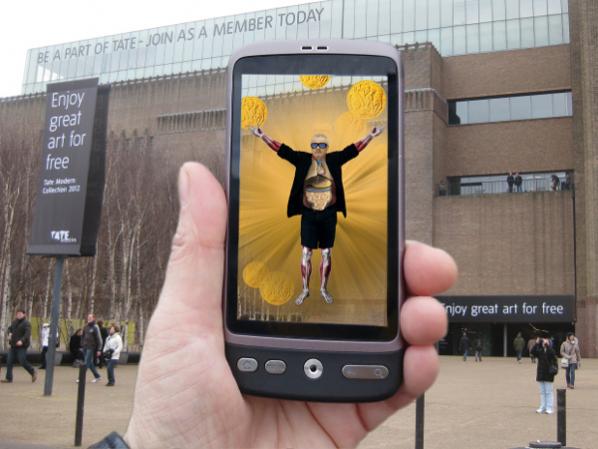
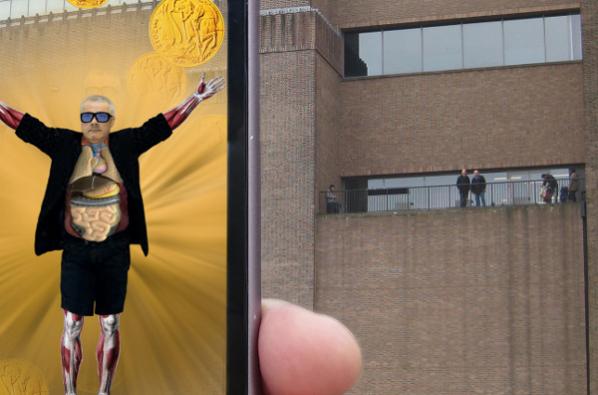
MG: You visited the Tate Modern and interacted with the public. What kind of responses did you receive by visitors to the intervention?
TT: Delight! Most had come to see Hirst’s exhibit with contradictory feelings about the man and his art because of similar issues to those that had motivated me to make my artwork originally. They were delighted at how my artwork spoke to these feelings while leaving the conclusion open for the viewer. They liked the spatiality of the piece, how it surrounded them and filled the cavernous empty space of the Turbine Hall when viewed inside the Tate Modern, and reflected on Hirst’s “Hymn” sculpture when viewed outside by the river. There was also fascination about this new technology which none had ever seen before, and of course some puzzlement about how it worked.
MG: What message are you hoping to communicate with this interventionist project?
TT: What attracts my attention as an artist are topics that provoke contradictory or unresolved emotions in myself. By their very nature I can’t answer these topics with a simple message. Instead I try to create striking images and visual/kinesthetic experiences that evoke the contradictory feelings I have myself, in the hopes that my works can help focus or sharpen the issue, or at least provoke dialog in those who view them.
To cite a different work from my art practice: even in “Shades of Absence,” in which I surround anonymous golden silhouettes of censored artists with terms of censorship, I am myself of two minds about many of the artworks I cite in the linked website on censored artists. I made Shades of Absence as an intervention into the 2011 Venice Biennale, at a time when Ai Wei Wei was imprisoned by his own government. In his case I am strictly against the censorship of him as an artist and a person, but in many other cases I have cited, I myself could not say I would always be against censorship when it could incite hate and physical violence against others.
MG: Is it mainly Hirst you are critiquing here or is he representative of something bigger in art and its culture that you are questioning?
Hirst is the British Jeff Koons! Every era and every country finds such a figure to represent the eternal tension between art as a sublime personal experience and art as the magnet for glamour and status and money. I wonder if it was any different for the artists of the cave paintings?
MG: In the publicity for the project, it says ‘Augmented Reality is the Street Art of the 21st Century!’. Could you elaborate what this means to you, and share with us some examples of other interesting works in this field?
TT: In this regard, to be frank I think the work of my cyberartist collective Manifest.AR is the leading work in the field at this moment, perhaps because we are all so diverse and cross-fertilize each other!
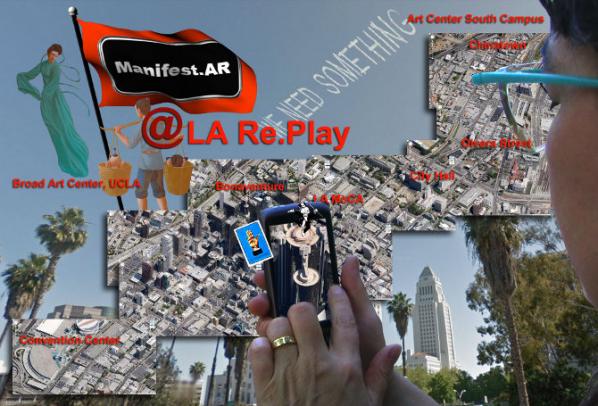
Of course augmented reality is not as visible as a graffiti on the side of a building – but it also cannot be removed, and we can place them wherever we want without fear – yet – of arrest or fines. Also, the smartphone or mobile tablet is becoming an extension of the self, and our primary interface with the extensive virtual society in which we are embedded. It is how we will communicate, how we will find information, how we will share our social space with everyone who is not standing in exactly the same room at exactly the same time, it will become our entertainment device, our payment device and god forbid our identification device. You do not go to someone’s house to look through their photo album, you go to their Facebook site. Why shouldn’t you start finding their thoughts and expressions as augmented reality images around you in space?
I just successfully co-wrote a major Rockefeller Foundation grant to help residents of a very poor area of a major city put up their own history and artwork in their neighborhood using augmented reality. I can’t say much about it as the official publicity has not yet been released, but the organization I wrote it for is convinced that in a couple of years, more of their youth will look at art on smartphones than in museums and art galleries. Will the middle and upper classes lag behind, because they think the only art worthy of note is hanging on gallery walls?
All Hail Damien Hirst! An augmented reality installation celebrating Damien Hirst at the Tate Modern.
http://www.allhaildamienhirst.com/
“Reign of Gold” – part of AR Occupy Wall Street
http://www.mission-base.com/tamiko/AR/reign-of-gold.html
Tamiko Thiel – Online Portfolio
http://www.mission-base.com/tamiko/
Tamiko Thiel is a media artist developing the dramatic and poetic capabilities of various forms of virtual and augmented reality as media for exploring social and cultural issues.
A founding member of the cyberartist group Manifest.AR, she participated in the pathbreaking augmented reality exhibit “We AR in MoMA,” an uninvited guerilla takeover of MoMA New York. Videos of Thiel’s “Art Critic Face Matrix” were featured in articles in the New York Times and on WNYC (National Public Radio). In 2011 she led the Manifest.AR Venice Biennial AR Intervention, placing her work series “Shades of Absence,” on censorship in the visual arts, in the Venice Giardini and in the German National Pavilion (which won the Golden Lion Award for best national pavilion). This led to an invitation to participate in the ISEA2011 exhibition UNCONTAINABLE, an official parallel program of the Istanbul Biennial, where she placed her artwork series “Captured Images” into the main biennial exhibition
Anonymous, untitled, dimensions variable is the title of a show by 0100101110101101.ORG (Eva and Franco Mattes) at Carroll/Fletcher gallery in London from 13th April to 18th May 2012. Or at least it was. The title changes each day based on submissions to a blog (http://exhibitiontitlechange.tumblr.com/). The new titles have been printed out and displayed on the wall to the left as you walk in to the gallery.
You don’t expect this kind of playful intersection of the virtual and the real in a gallery off of Oxford Street, across from Soho, opposite other new galleries. Carroll/Fletcher’s glass-fronted welcomingly brutalist interior says “serious contemporary art space”. Inhabiting such a space presents a challenge to net and digital art that must be met with careful presentation and considered curation.
Through the glass front of the gallery, and as you enter, you see a sculpture or assemblage of a (stuffed) cat trapped in a birdcage by a (stuffed) canary (Catt, 2010). The cat has suffered Epic Fail as the Internet would say, and did in the meme image that the sculpture is based on. It’s a comic and unnerving object even without the extra layers of reference provided by the original meme and the knowledge that it was originally presented as a fake Maurizo Cattelan sculpture. It is art with its roots in the net that can stand on its own without that context. Its companion piece, Rot, 2011, is a fake Dieter Roth sculpture consisting of detritus in a glass jar on a plinth against the far wall. 0100101110101101.ORG briefly inserted it into the Wikipedia page on Roth, and the fact that its materials were all ordered via the Internet drives home just how commonplace this has become.
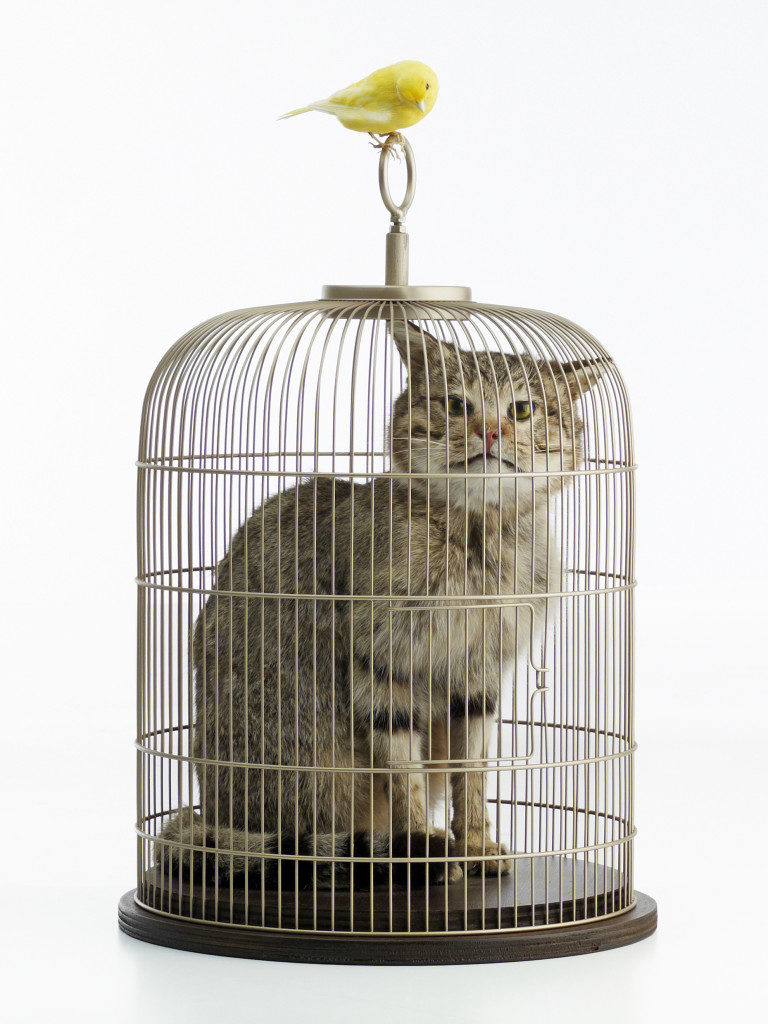
Both are given the room they need to work as objects in a gallery. Neither originates in itself as net art, more in 0100101110101101.ORG’s history of tricksterism and transgression. These are concerns that are easily linked to net culture, possibly too easily on the part of the reviewer, but it is telling that they are the works that the show opens with. They physically establish the playful appropriation and hyperreality that is the basis of much of 0100101110101101.ORG’s work.
Pride of place in the first room of the gallery goes to the projection The Others, 2011, 10,000 digital photographs (supposedly) copied without authorization from the folders of computers used by people on a peer-to-peer filesharing network that 0100101110101101.ORG used to distribute their own work. These are private images, projected at an angle and slightly across the corner. Configure your peer-to-peer filesharing client wrongly and it shares all the files in the folder you share. Including the images of you naked, drunk, lonely, partying, or whatever else you wouldn’t post anywhere a future employer might find them.
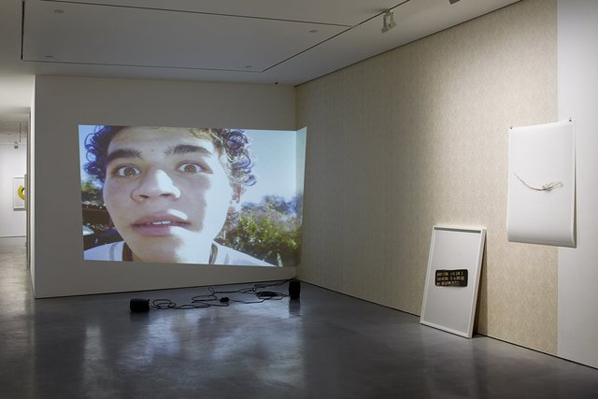
In the next, smaller, room is Colorless, odorless and tasteless, 2011. It is an old-fashioned car racing video arcade game retro-fitted with a petrol engine that starts up when you insert a coin and revs as you press the pedal to accelerate the virtual car on the screen, filling the (sealed…) room with carbon monoxide. Combining the virtual made physical of Catt and the moral impact of The Others, it is the most immediately dangerous artwork I’ve ever had to review.
Moving into the larger room at the back of the ground floor of the gallery, the video No Fun, 2010, is the most shocking piece in the show. Franco Mattes pretending to hang hineself on the random Internet webcam video chat switchboard Chatroulette is one thing, but the reactions of other Chatroulette users as they connect and see him apparently hanging there is quite another. Some laugh, some jeer, only one I watched displayed any lasting concern. This is the moral and aesthetic flipside of The Others.
Reenactments, 2007, is my aesthetic and technical favourite piece in the show. Videos of canonical performance art pieces being re-enacted by Eva and Franco’s Second Life avatars are displayed on CRT monitors arranged at floor level surrounded by the cables and adapters used to play back the video from SD cards. It’s much easier for an avatar to remain still as a “Singing Sculpture” than it is for a human being, making it even stranger, and Marina Abramovic’s “Imponderabilia” works much better with impossibly buff avatars than with mere naked human models stood in a doorway. It exquisitely foregrounds the social mediation of Second Life and its players self-presentation. A large cartoon wolf squeezes through between the naked avatars, their polygons intersecting. A vampire attempts to fly over them but hits the bounds of the architecture. The crowd in the background chat and bide their time. The virtual intensifies the real, out-doing and critiquing its appropriated source material.

Stolen Pieces, (1995, made public 2010) claims to move beyond fakery and unauthorized copying to physical appropriation. Stolen physical fragments of canonical postmodern artworks (Duchamp, Warhol, Koons, Rauschenberg) are displayed like forensic evidence, protected in small plexiglass containers, accompanied by large photographs of them and by documentary evidence of their theft. There’s no statute of limitation on theft in the UK, and damaging artworks shouldn’t be applauded. But it’s a daring performance and a concrete critique of the fetishism that lies at the heart of the art market and the institutions that help drive its value.
Following the brutalist concrete staircase to the basement reveals My Generation, 2010, a smashed but still working early-2000s PC lying on the floor. On its monitor, that appears to have fallen on its side, show video clips of computer game players giving in to and venting their frustration at the games they play. This isn’t the kind of image of yourself you want as your lasting monument on the Internet. Gathered together, like the images in The Others and the videos in No Fun, they again form a summation of an aspect of society and our visual environment that could not be achieved with such immediacy by other means. And the clear space and architectural solidity of the gallery again help to put a different emphasis on the material than if it was encountered on the web.
The wall-filling video projection of Freedom, 2011, records Eva’s attempts to plead with the players of networked First Person Shooter computer games not to kill her character. Touch-typing might have helped, but even when Eva manages to type long enough to explain that she’s an artist, or to ask people not to shoot, the social and game logic of the virtual world mean that her character is executed again and again, the screen shifting to third person as her avatar moves out of her control in death. Like No Fun, there is a core of callousness to these Internet interactions, and like My Generation they are unexpectedly preserved and presented for contemplation.
The final piece in the show is the documentary Let them believe, 2010, a video record of 0100101110101101.ORG’s Tarkovsky-haunted journey into Chernobyl’s “Exclusion Zone” in order to recover part of a fairground ride to turn into Plan C, 2010. Bringing part of the ride to life in a place where people can enjoy it is an effective and resonant symbolic resolution of the kind that art more than any other mode of human endeavor can provide.
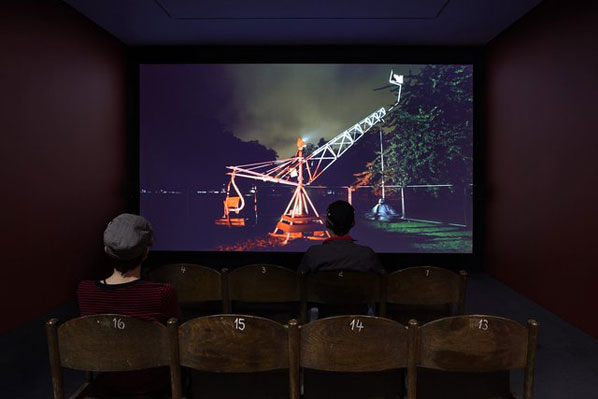
0100101110101101.ORG’s work presented physically has more than enough presence to fill the gallery and benefits from the space and the considered curation afforded it here. Some of the work is more physical than virtual and vice versa, sometimes the ethics of the work place 0100101110101101.ORG as the villain sometimes as the victim, and sometimes the work is performance whereas other times it is assemblage. I mention this to point out both the strong themes to the work and how individual the effect of each piece is.
Net art in the gallery might seem a category error, like museum postal art. Or it might seem a commodity, like auctions of land art documentation. But net art is transitioning from being the contact language of artworld emigrants learning the net’s protocols to the contact language of net emigrants learning artworld protocols. 0100101110101101.ORG have made art of these encounters from the start, and have always been as at home in the gallery as on the net.
The text of this review is licenced under the Creative Commons BY-SA 3.0 Licence.
There’s a splendid exhibition currently on at Manchester’s Cornerhouse. Entitled Subversion, it presents a selection of artworks, a good number of which are moving image pieces, from various artists who are united by a strong connection to the Arabic speaking world. We’re already in loaded territory, for all sorts of obvious reasons. Those reasons could give rise to a long discussion which I’m not going to approach directly here, instead simply quoting a programmatic statement from Glaswegian Egyptian-Turkish writer Omar Kholeif, the show’s curator:
‘Like many of the artists I was looking at, I felt that collectively curators and writers associated with the politically unstable Arab world were being asked to step up and perform to an identity that the world wanted us to play. With Subversion my aim was to do just the opposite. I worked with artists who referenced this very language but who wanted to dissent, poke fun, critique and re-define themselves as artists of the imagination, and not of any specific social or political condition.’
And, in case you’re wondering, he succeeds richly in this aim and, I think, more.
If you can get to Manchester with at least a couple of hours to spare before 5th June your life will be enriched thereby.
I’ve already written a short piece on the show, with a couple of video clips, on DVblog and I’ll be writing a longer review, including consideration of some of the thornier question alluded to above, for MIRAJ 4, out in June 2013.
What I’d like to do here is to look in some detail at one particular piece from the show, a short video by Khaled Hafez. I don’t mean to suggest that it is somehow best in show although I do love it – the show is too diverse for that kind of simple-mindedness. I do think a careful examination of it will yield support for Kholeif’s position. What we have here is a complex work of art, which bears repeated viewing, which doesn’t bend or break but thrives under that hard scrutiny and which, although inevitably stamped with the experiences, background, the moment in time, the physical location of its creator – what isn’t! – is universal (Problematic term! Of course we can’t know what 100 years will make of it but we can assert its current universality and adduce evidence that it is a work which promises to be of some long-term interest too.)
Hafez is probably better known as a painter of striking mash-ups of ancient Egyptian gods, comic book heroes, bodybuilders and models set against richly textured, feverishly beautiful and largely non-perspectival landscapes of the imagination. His paintings are characterised not only by this content (and of course what we lose in a run down of content is the aftermath of the act of painting, facture’s narrative, the play of line, geometry and colour. I’ve seen none of his pieces ‘in the paint’ but I’d bet money they’re good enough to eat.)
Furthermore, series, numbers, line-ups, multiples and queues of those Gods, comic book figures, bodybuilders and hybrids thereof seem to be important to him (and I don’t think I’m wrong in perceiving an echo of hieroglyphs and their implied grid and of pre-Arabic Egyptian art too).
There’s a strong sense of directionality and of motion arising from these lines and groupings and even if one knew none of the background it wouldn’t be surprising to learn of Hafez’s deep interest in moving image.
OK – to the piece itself. Let’s stay zoomed-out for a while and point out first that it was made in 2009, two years prior to the revolution which brought down Hosni Mubarak, exemplifying the ‘storm petrel’ effect whereby artists, who can often be infuriatingly ditzy as politicos, nonetheless, in virtue of their trade – their looking, their seeing, their empathy, empathy often of a strangely disinterested variety except for the can-I-make-art-from-it question, which question perhaps even makes their antennae the sharper, their sensitivity to society’s emotional weather, their readiness to make apparently random or intuitive connections – can be uncannily prescient about impending social change. Artists often ‘get it’ before the key actors begin to have the confidence to move.
So, you need to know that the piece contains so much reference to social conflict that, at first sight, to the outsider at least, it could have been made in the last year.
We start in darkness. Titles: “Anubis productions presents”. A number of soundtracks sewn together in a kind of faux short wave radio polyphony which resolves to a solo piano playing something doomily romantic which I don’t recognise (on subsequent listening it appears to be of a piece with the up-tempo stuff that follows, so I assume it’s especially composed). Over this we hear an extract from the resignation speech given by General Gamal Abdel Nasser in the immediate aftermath of the defeat in the six day war against Israel in June 1967. (He resigned for a day, coming back to office surfing a wave of popular support and grief and then ruling until his death in 1970).
I presume that to quote Nasser is a potent gesture in Egypt. I assume, despite any criticisms anyone might make of him he carries a ‘father of the nation’ type weight and that an allegorical comparison between him and Mubarak would come naturally – here is a flawed but somehow heroic figure, indubitably at the least a genuine anti-imperialist – offering his resignation, but, now, in stark contrast, his pale epigone, his inheritor as dictator but not as hero, clings grimly on by force and brutality and mired in sleaze.
The audio continues and we see more titles:
“The A77A Project (On Presidents and Superheroes)”
Hmm – presidents. In the plural.
Also: you don’t strictly need to know this, but it was gleefully explained to me by the artist that A77A is Egyptian blogger ‘slang’ in that it represents Arabic characters difficult to transliterate directly to Roman for the Arabic word for ‘Fuck’. Of which more soon.
The next thing we see is a detail of the lower centre of a painting by Hafez from the previous year, “Outside Temples”. We focus in on three figures seen in profile. They are almost identical except that whereas the two outer ones have the jackal heads of Anubis the central one wears… a Batman mask. They stand in profile, in body builder pose, right arms raised above and in front of the head forming a sinuous S curve to mirroring left arms behind the lower back.
We zoom into these figures as music changes to a metronomically regular disco drum and cymbal rhythm and the two rightmost figures ‘detach’ themselves from their background and walk forward out of frame to the right.
This detaching happens five times – series in time as well as space.
Three sets only of the figures then parade past us with the arms that had been set in the raised arm pose pumping up and down (crudely animated by pivoting at the shoulder, a similar device setting the legs in motion) in what I surmise is an offensive gesture. It is certainly charged with a raw and vulgar vigour. At this point the figures march against a plain white field – slowing the piece down reveals stray blocks of pixels generated in the animation process. This lack of polish, the retention of rougher edges, feels like a Brechtian distancing. It certainly helped to sharpen my attention as well as endowing the piece with a kind of elephantine grace.
We move to a landscape, I’m guessing a poorer or outlying area of Cairo, with a building site before us. Two of the figures continue their rightwards motion across the frame. They loom large against the background and even allowing for distance, dwarf the human figures behind them. Interestingly the background imagery appears to have been shot from a vehicle moving across the frame to the left, which further cranks up the energy level.
We cut to a 3D software generated mannequin walking in the same direction in a similar landscape. The two painted figures catch up and merge with it – by the somewhat clunky use of a split screen – giving birth to a single Anubis headed mannequin who is our protagonist for the rest of the piece.
The figure continues into a landscape dominated by a still of the Sphinx of Giza, ( Abū al Hūl, in Arabic, translating into English as The Terrifying One) which, in a move straight from Terry Gilliam, picks up the next words of the Nasser speech, ‘mouthing’ with a detached and hinged lower jaw . In the background, the ‘sky’ – in fact simply the background where the image has been cut out in Photoshop – cycles through various colours from a fierce red through multiple greys to black. As you might have surmised realism is not the key term here… except…except …there is a kind of higher realism going on… A pastiche of the stuttering effect so overused in popular music in the early days of sampling is applied to the ends of words in the speech – and here, in Nasser’s Arabic translated as ‘I decided to step down’, the bloggers’ A77A appears, repeated and repeated, a splendidly childish and satisfying equivalent to shouting ‘Fuck! Fuck! Fuck! Fuck! Fuck! Fuck! Fuck! Fuck!’
From now to the end every background image is a still and our Anubis – visitor from another realm, mostly an observer, bemused God in a world gone insane, who intervenes only once and then as a kind of trickster, stepping backwards to change a banner in English reading “Presidential Elections” to “Presidential Erections” ( and then the Arabic banner too – Hafez told me that, strangely, a small change will accomplish precsely the same transformation in both languages) but who pauses politely to allow a photographer to snap five women with cheesy shutter noise and all – processes inexorably rightwards through a number of frames of varying character: some, surreal collage: a man on a bike with a wheelbarrow on his head; some whose strangeness arises from a sophisticated deployment of the warped perspective arising from the lo-fi animation technique – another man-on-bike whose movement at an apparent 70 degrees ‘through’ the frame emphatically underlines the constructed nature of what we are watching followed by a subtle but delicious section where the background image is smaller than full frame size and Anubis steps decorously up into and then down out of it; some, more serious – confrontations between demonstrators and riot police, with the arm-pivot device once again deployed to enable a middle aged women make our putative vulgar gesture repeatedly to the cops.
Anubis finally vanishes into what I take to be a polling booth.
This is such a rich work. It is both enormously local and particular and at the same time hugely general. It is full of ‘content’ but at the same time driven by smart, knowing and dextrously deployed formal devices, which reside not in the background but near to the surface and greatly add to the pleasures of the piece, which presents weighty and serious matters, but does so with great geniality, a geniality and humanity I for one wish to firmly identify with the awakening oppressed as they genially, but definitively and unsentimentally, sweep aside and settle accounts with their former oppressors.
—–
This review is a collaboration between Furtherfield and DVBlog.
Watch the film on the DVBlog website

Sign up: ale[at]furtherfield.org
To accompany Invisible Forces, Furtherfield invites all gallery visitors to take part in a programme of public play, games, making and discussion led by alert and energetic artists, techies, makers and thinkers: Class Wargames, The Hexists, Dave Miller, Olga P Massanet and Thomas Aston.
Saturday 23 June 2012 – 1-5pm
Summer Board Games and Picnic with Class Wargames and Kimathi Donkor
Saturday 30 June 2012 – 1-5pm
Summer Board Games and Picnic with Class Wargames
Wednesday 04 July 2012 – 9-11am
3 Keys – The River Oracle – The Hexists
as part of Moving Forest by AKA The Castle
Wednesday 11 July 2012 – 11-5pm
Technologies of Attunement – Olga P Massanet and Thomas Cade Aston
Saturday 21 July 2012 – 2-5pm
Dave Miller’s Finsbury Park Radiation Walk
Featured image: Sculptured relief of Roman soldiers fighting the barbarians.
Lies, Lawlessness and Disbelief 1. Thinking Art and Capital: Unknown Unknowns, is the second of five essays by Canadian artist & critical thinker, Katie McCain. McCain discusses how capitalism has become on the one hand all encompassing and on the other utterly unreal. Arguing that we need to be prepared to think the impossible so that resistance is able to grow.
DOWNLOAD the full text (including all 5 parts) here, or read part two below:
In 1942 the Ministry of Defense labeled Gruinard Island as X Base. It was an isolated island that had been deemed acceptable for testing the viability of an anthrax weapon, as it was unknown if the spores be able to survive the blast. An anthrax bomb was dropped on a herd of sheep kept in individual crates, their heads in hoods so they could not lick the spores. Of 15 sheep, only 2 survived. The test was repeated with less success as a change in wind direction caused the bomb to land in a peat bog where it sank. The test was moved to Wales. In 1981 operation dark harvest – led by a team of microbiologists – collected soil samples from Gruinard Island, which had since been quarantined. Their demand was for the government to decontaminate the island or the samples would be weaponized and distributed. Two samples were found outside a research facility in Porton Down, and in Blackpool, where the ruling conservative party were meeting.[1]
Unknown unknowns are intrinsic to this conceptual, contemporary capitalism, and operate as the risk that can eventually cause a system to fail. Failure emerges from the unprecedented, from the unthinkable, from the things you do not know you do not know.[2] Instead of attempting to predict these events for market gains, what would it mean to merely acknowledge the paradoxical nature of thinking the unthinkable? Unthinkable operates as the other to any thought capacity, and in an attempt to access this impossible, it would be possible to access a non-knowledge, something on the edge of logic, of research, of ideas.
Non-knowledge is not the same as ignorance, but rather references the other of the knowledge system itself, an indeterminate zone between knowledge and ignorance.[3] Huberman addresses this topic in the exhibition catalogue: For the Blind Man in the Dark Room Searching for the Black Cat that Isn’t There. The phrase was initially attributed to Charles Darwin’s description of a mathematician, but here is used to underscore the type of knowledge, the type of logic, that art explores. A work of art that isn’t. As a method of generating new forms of thinking and unknown circuits of consciousness, visual art often verges on logic.[4]
Quantum physics is constantly pushing the boundaries of the unknown. If these formulations, these theories, constitute the boundary of the known, imagine the possibilities contained in unknown unknowns. This of course is impossible, but in the impossible lays unimaginable possibilities. The acceptance of the fact that there are unknown unknowns and, like dark matter, they are invisible, but make up the majority, could operate as a placeholder for limitless possibilities.[5] The things we do not know are impossible, contradictory and badly behaved; the things, then, that we do not know we do not know could be more radical still in terms of reality and the perception of it –an impossibility for thought, but this is the heart of it, the possibilities contained in the impossible. It is fundamentally possible for anything to be true (or conversely false), to be known (or to be unknown)[6]. The more this point is exhumed the more amazing and simultaneously frustrating it can become.
Quantum reality proves that we can alter reality just by looking at it. Photons behave differently under scrutiny than when left to their own devices, which leaves us incapable of describing their behaviour.[7] Einstein asked physicist Niels Bohr if he really believed that the moon disappears when no one is looking at it, to which the retort was “can you prove otherwise?”[8] The answer is of course no, we are incapable of removing ourselves, of removing our relation to the thing-in-itself, of removing the impact of thought from suppositions of reality.
‘Quantum physics is an exciting theory because it is extremely precise, it is mathematically beautiful, it describes everything. It just doesn’t make sense.’[9]
Perhaps the language of mathematics is not a language invented in order to describe reality, but rather is the basis on which the physical world manifests, and slowly consciousness grasps more and more of this structure. If the theory is wrong, fundamental physics will hit a roadblock beyond which is it impossible to tread; if the theory is right everything is potentially understandable, dependant on thought’s capacity to understand.[10] These fundamentally opposite poles of reality offer, to us, the same plain of comprehension – the capacity of thought, the very limit of which we cannot pass.
Dreamwork, specters, illogic, the impossible – it is where thought begins to break down in terms of accuracy or coherent narrative that it begins to get interesting. On the fringes of thought lie truth, radicalism, subversion and change. And on the fringes of reality are lies, paradox and the imaginary. Does this mean that truth can be found in lies, paradox and the unreal?
The market depends on our belief in it, and our lack of faith can have catastrophic results. So bolstering collective belief in markets is the main strategy for their stabilization. But consciousness is not so simple; the market begins to rely not only on our belief in it, but in our belief in our belief in it[11], and so on ad infinitum. An infinite regress of belief created in order to prop up that self-same belief. How can consciousness continue to reconcile itself with this infinite regress? In quantum physics, observing photons can change how they behave. In the market, disbelief can cause it to collapse. A ping pong ball, by the time it’s bounced nine times factors the gravitational pull of a body standing next to the table into it’s bounce, by the 56th bounce ever single elementary particle of the universe has to be present in your assumptions [12]. In reality, many things are affected by human existence, but thought, or existence itself is not one of them.
It is not true that in order to live one has to believe in one’s own existence. There is no necessity to that. No matter what, our consciousness is never the echo of our own reality, of an existence set in “real time.” But rather it is its echo in “delayed time,” the screen of the dispersion of the subject and of its identity – only in our sleep, our unconscious, and our death are we identical to ourselves. Consciousness, which is totally different from belief, is more spontaneously the result of a challenge to reality, the result of accepting objective illusion rather than objective reality. This challenge is more vital to our survival and to that of the human species than the belief in reality and in existence, which always refers to spiritual consolations pertaining to another world. Our world is such as it is, but that does not make it more real in any respect. “The most powerful instinct of man is to be in conflict with truth, and with the real.”[13]
Asleep, unconscious or dead. These are the three options in which one is identical to oneself. But what does that mean? Harman discusses sleep as a lack of relations. We still exist as pieces that make a physical whole, but the thing we lack in sleep is relations. ‘Sleep is our closest approach to the freedom from relations in which we are most ourselves’[14]
An object, too, can be dormant. It is capable of existing apart from a specific situation, and therefore is capable of existing apart from any situation at all; therefore, it is relationless, or has the possibility to be relationless. Unlike objects, however, this dormancy is not so much a freedom from the world, as a dormancy to the world, withdrawn, incapable of anything else.
Yet, in a sense we are always inside the world through the fact that we are made up of pieces – and only therefore are we free, with our components doing the work of liberty on our behalf. For there is an excess in our pieces beyond what is needed to create us, and this excess allows new and unexpected things to happen.[15]
So perhaps seeking freedom in individuation, in isolation, as the linking of subject to object, in the perpetual delay of satisfaction that capitalism offers is the achievement of the exact opposite of the freedom sought. Perhaps the individual freedom presented by capital and democracy is in fact a relationless sleep that removes the other, the alternative, removes the opportunity for change, and ultimately time itself.
sl
sle
slee
sleep
Freudian kettle logic is an example, a joke employed by Freud to explore the mind’s capacity for self-deception. It is this logic, or rather this illogic that some manages to access the impossible. Kettle logic refers to the thought process of a mind on the defensive. It shows the impossibility of thought or rather it’s circular nature, that manages to disregard laws of non-contradiction. It goes as follows:
A neighbour is accused of borrowing a kettle and returning it with a hole. He answers simultaneously that 1) he did not borrow the kettle; 2) it was unbroken when he returned it, and 3) that it was broken when he borrowed it.[16]
Freud uses this to unpack dream logic, during which time mutually exclusive answers or states can easily co-exist. “Wendy Brown says that dreamwork provides the best model for understanding contemporary forms of power. It produces a confabulated consistency that covers over anomalies and contradictions”[17]. Žižek uses Freudian kettle logic to explain the U.S.’s right to wage war on Iraq, and the notion of the pre-emptive strike, which renders events of the future to a fictional or probabilistic past.[18]
Žižek also argues:
If we postpone our action until we have full knowledge of the catastrophe, we will have acquired that knowledge only when it is too late. The certainty on which to act is never a matter of knowledge, but a matter of belief. If, accidentally, an event takes place, it creates a preceding chain which makes it appear inevitable – Hegelian dialectic of contingency and necessity. In order to confront a disaster – we should accept it as fate, as unavoidable, and then retroactively insert into the past of the future possibilities on which to act in the present.[19]
This is frighteningly similar to the rhetoric of war used by the right, but employed by the left with regard to environmental disaster. Both the right, and the quite radical left in this instance, are using the same logic of prediction to validate an action. The difference, it seems, is Žižek’s disbelief, or awareness of the impossibility of a situation that requires action despite the fact that the specifics of the situation itself are still largely unknown.
Link to first article
https://www.furtherfield.org/lies-lawlessness-and-disbelief-1/
Adorno, Theodor.W. Negative Dialectics. Translated by E.B. Ashton. New York: Continuum, 2005. First Published 1966 by Suhrkamp Verlag.
Associated Press. “Romanian Witches Curse Latest Government Clampdown,” The Guardian, February 9, 2011, main section, 20.
Bartlett, Monica Y., Aida Cajdric, Nilanjana Dasgupta and David DeSteno, “Prejudice from Thin Air: The Effect of Emotion on Automatic Intergroup Attitudes.” Psychological Science 15, no. 5 (May, 2004): 319-324.
Baudrillard, Jean. Global Debt and Parallel Universe. Translated by Francois Debrix. http://www.egs.edu/faculty/jean-baudrillard/articles/global-debt-and-parallel-universe/ (accessed April 4, 2011).
Baudrillard, Jean. Radical Thought. Translated by Francois Debrix. Edited by Sens & Tonka. Paris: Collection Morsure, 1994.
Bey, Hakim. T.A.Z.: Temporary Autonomous Zone, Ontological Anarchy, Poetic Terrorism. New York: Autonomedia, 2003. First Published 1985.
Bradley, Will. “Guarana Power.” in Self-Organization/Counter-Economic-Strategies, edited by Bradley, Hannula, Ricupero and Superflex, 311 – 333. New York: Steinberg Press, 2006.
Brassier, Ray. “I Am a Nihilist because I Still Believe in Truth” Interview with Marcin Rychter. Kronos: March 4, 2011 http://kronos.org.pl/index.php?23151,896 – accessed: march 23rd, 2011.
Brassier, Ray. Nihil Unbound: Enlightenment and Extinction. Basingstoke: Palgrave McMillan, 2007.
Critical Art Ensemble. Marching Plague: Germ Warfare and Global Public Health. New York: Autonomedia, 2006.
Declercq, Frédéric. Lacan on the Capitalist Discourse: Its Consequences for Libidinal Enjoyment and Social Bonds. Psychoanalysis, Culture & Society 2006, 11, (74-83).
Fisher, Mark. Capitalist Realism: Is There No Alternative? Winchester: Zero Books, 2009.
Foucault, Michel. Power/Knowledge: Selected Interviews & Other Writings: 1972-1977. New York: Pantheon Books, 1980.
Fromm, Erich. The Fear of Freedom. London: Routledge & Kegan Paul Ltd., 1966.
Groys, Boris “Art and Money,” E-Flux 24 (2011), http://www.e-flux.com/journal/view/226.
Harman, Graham. Circus Philosophicus. Winchester: Zero Books, 2010.
Hofstadter, Douglas R. Gödel, Escher, Bach: An Eternal Golden Braid. London: Penguin Books Ltd., 1979.
Holt, Jim. “The Way We Live Now: Against Happiness,” New York Times, June 20, 2004.
Horizon: What is Reality? Documentary. Directed by Helen Shariatmadari. BBC: ep. 9, 2011.
Huberman, Anthony, ed. For the Blind Man in the Dark Room Looking for the Black Cat that Isn’t There. St. Louis: Contemporary Art Museum St. Louis, 2009.
Huxley, Aldous. Brave New World. London: Vintage Books, 2007. First published 1932 by Chatto & Windus.
K-Punk Blog. http://k-punk.abstractdynamics.org/archives/004421.html
Kafka, Franz. The Castle. Middlesex: Penguin Books Ltd., 1964. First published 1926 by Das Schloss.
Kurant, Agnieszka and Nassim Nicholas Taleb. “Unknown Unknowns: A Conversation between Agnieska Kurant & Nassim Nicholas Taleb about the Benefits of Uncertainty.” Frieze, September 2010, 127 -135.
Lacan, Jacques. “Seminar on the Purloined Letter.” Yale French Studies 48 (1972): 39-72.
Lacan, Jacques. The seminars of Jacques Lacan: Book II: The Ego in Freud’s Theory and in the Technique of Psychoanalysis 1954-1955. Ed: Jacques-Alain Miller. New York: W. W. Norton and Co., 1991.
MacKinnon, Catharine A. “Feminism, Marxism, Method and the State.” Chicago Journals 8, no. 4 (1983), 635-658.
Meillassoux, Quentin. After Finitude: An Essay on the Necessity of Contingency. London: Continuum, 2008.
Mouffe, Chantal. The Democratic Paradox. London: Verso, 2000.
Noys, Ben. Persistence of the Negative: A Critique of Contemporary Continental Theory. Edinburgh: Edinburgh University Press, 2010.
Place, Vanessa and Robert Fitterman. Notes on Conceptualisms. New York: The Ugly Duckling Presse, 2009.
Stephen, Kylie. “Sexualized Bodies.” in Real Bodies: A Sociological Introduction, edited by Evans and Lee, 29-45. Basingstoke: Palgrave MacMillan. 2002.
Taleb, Nassim Nicholas. The Black Swan: The Impact of the Highly Improbable. London: Penguin Books Ltd., 2007.
Thacker, Eugene. “Nihil Unbound” review of Nihil Unbound: Enlightenment and Extinction, by Ray Brassier, Leonardo 42: no.5, (2009): 459-460, http://muse.jhu.edu/journals/leonardo/v042/42.5.thacker.html (Accessed April 2, 2011).
The Trap: What Happened to Our Dream of Freedom? Documentary. Directed by Adam Curtis. BBC Two: March 2007.
Trotta, Roberto. “Dark Matter: Probing the Arche Fossil.” Interview with Robin Mackay. Collapse: Philosophical Research and Development 2 (2007): 83-169.
Vidal, John. “Bolivia Enshrines Natural World’s Rights with Equal Status for Mother Earth.” The Guardian. April 11, 2011. Main section, 15.
Weaver, Matthew. “Romanian Witches to Cast Anti-Government Spell.” The Guardian. January 7, 2011. Main section, 23.
Wilson, Eric G. Against Happiness. New York: Sarah Critchton Books, 2008.
Žižek, Slavoj. First as Tragedy, Then as Farce. London: Verso, 2009.
Žižek , Slavoj. The Iraqi Borrowed Kettle. http://www.lacan.com/zizekkettle.htm (accessed April 4, 2011).
Žižek, Slavoj. What Rumsfeld Doesn’t Know that He Knows About Abu Ghraib. (2004) http://www.lacan.com/zizekrumsfeld.htm (accessed April 4, 2011).
Featured image: Ein Identity-Workshop mit dem britischen Künstler Heath Bunting. Vertiefung Mediale Künste, Sihlquai 131, 8005 Zürich. Dienstag,
Whether Bunting is climbing trees, skateboarding, canoeing or working with technology he approaches it all with the same critical attention. He hacks around systems, physical or digital. Right from when he built his first computer at the age of 14, his life has been an experimental research project. His practice consists of a dry sense of humour and an edgy, minimal-raw aesthetic, mixed with a hyper-awareness of his own artistic persona and agency in the world, whilst engaging with complex political systems, institutions and social contexts.
Even though the subjects he explores are likely to be the most topical or important issues of the day, it always includes playfulness and an element of the prankster in his work. His work regularly highlights issues around infringements on privacy or restriction of individual freedom, as well as contexts concerning the mutation of identity, our values and corporate ownership of our cultural/national ‘ID’s’, as well as our DNA and investigations into Bio-technologies. In an age where we are submersed in frameworks and protocols designed by a neo-liberal elite for a generic consumer class, Bunting’s work is well placed as observation and practical research into the ‘depths’ of legal and illegal territories in our contemporary, networked cultures.
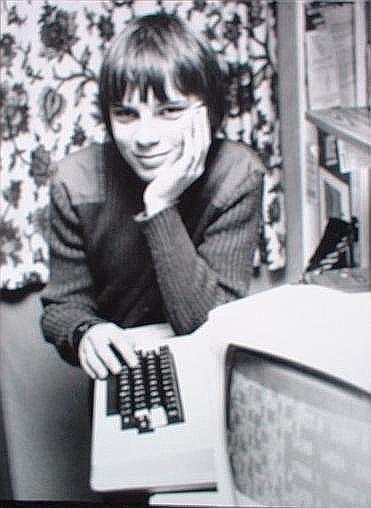
“our identity is constructed as human beings that can possess one or more natural persons and control one or more artificial persons. The higher up in the class system the better the access to status variety.”(Bunting)
The Status Project, is a study of the construction of our ‘official identities’ and creates what Bunting describes as “…an expert system for identity mutation”. His research explores how information the public supplies in their interaction with organisations and institutions is logged. The project draws on his direct encounters with specific database collection processes and the information he was obliged to supply as a public citizen to access specific services; this includes data collected from the Internet and information found on governmental databases. This data is then used to map and illustrate how we behave, relate, choose things, travel and move around in social spaces. The project surveys individuals locally, nationally and internationally, producing maps of “influence and personal portraits for both comprehension and social mobility”.
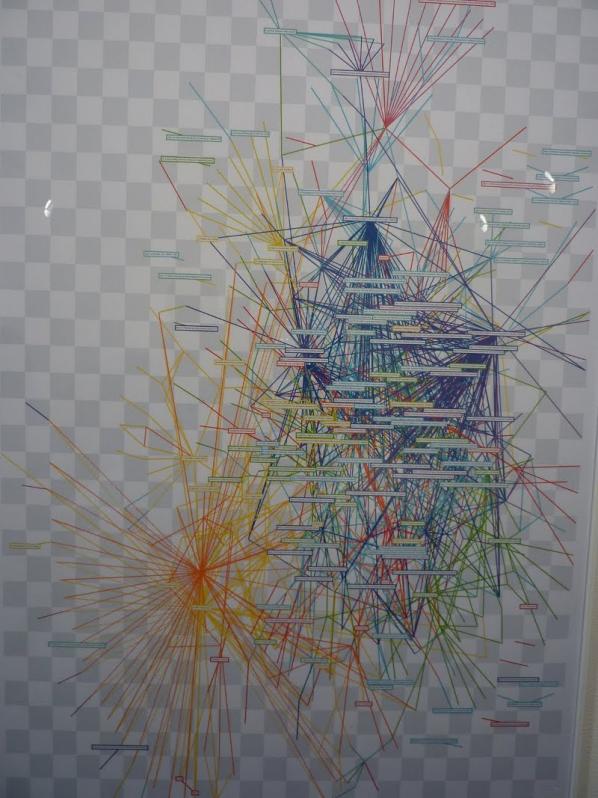
The use of data in contemporary life has made individuals an accessible resource for commercial and political interests. We are a rich source of data-mining material. Data mining is a process that potentially commodifies our interactions. Its historical roots lie with the development of artificial intelligence (AI) and 20th Century statistical analysis. These two methods of formulating data have grown ever closer together, backed by corporations and government-initiated military funding. Social networks such as platforms like Facebook and Internet networked institutions such as Google and the US military are all obsessed with our behaviours online. A good example is the NSA’s recent rebirth in turning most of its surveillance apparatus to spy on the US and its citizens. They have built a supercomputer tracing through billions of people’s emails, phone calls, and online activities in other countries outside of the US. The UK government is currently going through the political process of trying to implement similar spying protocols and systems to watch what UK citizens are up to.[2]
“Google suffers from data obesity and is indifferent to calls for careful preservation. It would be naive to demand cultural awareness. The prime objective of this cynical enterprise is to monitor user behaviour in order to sell traffic data and profiles to interested third parties.” [3] (Lovink)
Bunting is a Hacktivist Artist, acting (playing) out the role of a spy collecting and observing data content. Hacktivist Artists work with technology to explore how to develop their critical and imaginative practice in ways beyond the frameworks of the art establishment and its traditions. The established art arena is gradually catching up with this kind of artwork. However, one could be forgiven for thinking that many art critics and galleries are still caught in the 20th Century.
Two other artists also working on people’s data are Julian Oliver and Danja Vasiliev. They have collaborated on exploring alternative identities as the mysterious group, Men in Grey.[4] They detect online users’ vulnerabilities by tapping into and intervening in wireless network traffic – observing, tracing and copying user online activities. It is then redisplayed online on their website for others to view or transferred onto a visual screen on the side of a briefcase as an intervention in cybercafes for all to view. Although, no one knows other than themselves if the data is hacked and then redisplayed on these briefcases, as proposed in their video featuring one of their interventions. One thing is for sure – they have touched upon issues concerning our fears about personal data being seen by other people who we’d prefer were not viewing it.
The Status Project also taps into questions concerning technology, hierarchy and power. We are entwined in a complex game where the sacrifice of our information is part of connecting with others across digital networks. This raises the issue of our ‘human’ status being aligned ‘to and as’ objects of measurement. Through travel ports, our vehicles, passports, ID cards, library cards, mobile phones, alongside information about our health. We have mutated into networked (information-carrying) beings. Bunting’s own position on this matter is that “Technology is becoming more advanced and the administration of this technology is becoming more sophisticated, and soon, every car in the street will be considered and treated as persons, with human rights. This is not a conspiracy to enslave human beings, and it is a result of having to develop usable administration systems for complex relationships. Slaves were not liberated because their owners felt sorry for them; slaves were given more rights as a way to manage them more productively in a more technologically advanced society.”[5]

In the UK, in 2006 a research document called ‘A Report on the Surveillance Society For the Information Commissioner’ was published. Produced by a group of academics called the Surveillance Studies Network. This report was presented to the 28th International Data Protection and Privacy Commissioners’ Conference in London, hosted by the Information Commissioner’s Office. The publication begins by saying “Conventionally, to speak of surveillance society is to invoke something sinister, smacking of dictators and totalitarianism […] the surveillance society is better thought of as the outcome of modern organizational practices, businesses, government and the military than as a covert conspiracy. Surveillance may be viewed as progress towards efficient administration, in Max Weber’s view, a benefit for the development of Western capitalism and the modern nation-state.”[6]
We are not only under surveillance by entities we do not trust, we are also tracing each other online. Recently, in a show called ‘Being Social'[7] at Furtherfield’s new gallery, artist Liz Sterry showed her installation piece, ‘Kay’s Blog’. Sterry had “collated not only one form of online social engagements but all she could find about a Canadian blogger called Kay. Using everything from photographs to things Kay has mentioned in videos, blogs and posts on social networks, Sterry has recreated Kay’s bedroom in the gallery.”[8] (Scott)

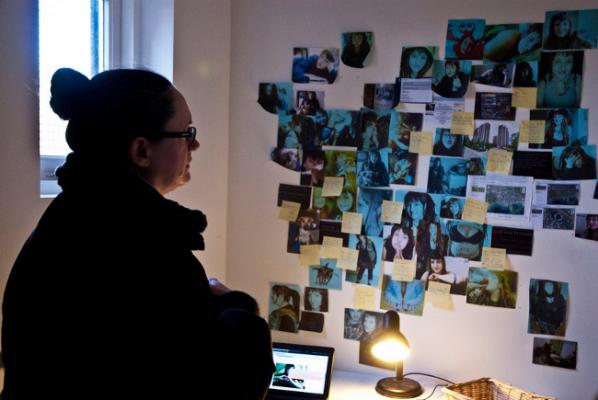
“”There were times when I felt quite creepy,” says Liz, 28, as she shows me lists of Kay’s Facebook friends and a Google Streetview of her apartment block while a playlist of her favourite songs plays in the background.”[9]
Yet, as this ever-creeping surveillance culture grows and attaches its all seeing eyes onto us all. Whether we are referring to domestic interactions, organizational or deliberate, this is not the main issue. Neo-liberalism has developed so much now, we are all part of the Netopticon. English philosopher and social theorist Jeremy Bentham in the late Eighteenth Century designed the Panopticon. It allowed officers in institutions, particularly in prisons, to observe (-opticon) all (pan-) inmates without them knowing whether or not they are being watched. In the end it was not built, but the French philosopher Michel Foucault in his publication Discipline and Punish: The Birth of the Prison,[10] in 1975 said that we are not only monitored in prisons, but in all hierarchical structures like the army, schools, hospitals and factories. This process has evolved through history to resemble Bentham’s Panopticon. The up-dated version of Panopticon, can now be thought of as the Netopticon – where individuals are complicit in feeding their own forms of collective co-surveillance, as well as being traced by corporations, governments and spammers.

“What your data body says about you is more real than what you say about yourself. The data body is the body by which you are judged in society, and the body which dictates your status in the world. What we are witnessing at this point in time is the triumph of representation over being. The electronic file has conquered self-aware consciousness.” [11] (Critical Art Ensemble)
So far, for the project he has created a functioning, sketch database of the UK system with over 10,000 entries – made over 50 maps of sub-sections of the system to aid sense of place and potential for social mobility. Bunting says he is also researching how to convert his identity generating software into a bot recognised under UK law as a person “covered by the human rights act i.e. right to life and liberty; freedom of expression; peaceful enjoyment of property. I am very close to achieving this.”
This bring us to another part of the project what I call ‘Identity Kits’, and Bunting calls ‘Synthetic off-the-shelf (OTS) British natural person’.[12] These kits consist of various items, personal business cards, library cards, a national railcard, t-mobile top-up card, national lottery card and much more. They take a few months to compile each of them because they are actual items that everybody uses in their everyday lives, involving evidence of identity. There is also a charge for the package of 500.00 GBP, which is cheap for a new identity.
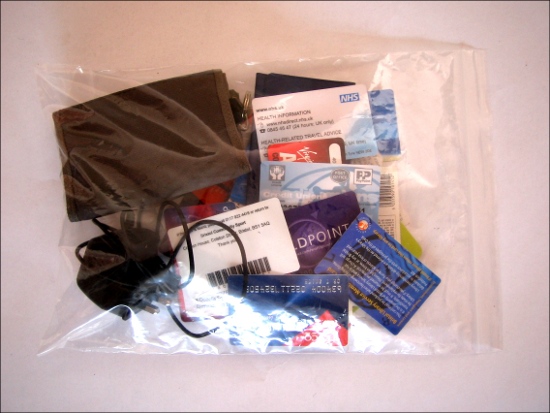
Bunting stresses that these UK identities are lawful and that there is no need for any official consulting or permission from an authority to use or make them. Through this he intends to illustrate a precise codification of class in the UK system. Currently, he defines three classes of identitiy: human being, person and corporate. What class of individual you are places you into categories of evaluation, this process allows others to judge your status, worth and value, within a hierarchy, which is clearly represented in the status maps.
This work touches on issues around our everyday status as a critique, but also as an investigative hack, and plays around with the quagmire of inequality currently in the UK. Inequality is built, constructed into the fabric our societies as an accepted default, through tradition, social or mechanistic, holding in place societal divisions. If there was a status project made in other countries reflecting their own status, worth and value of citizens there would be clear links defining where the connections and divisions lie, between each culture. In fact, another project worth mentioning here is ‘The Spirit Level: Why More Equal Societies Almost Always Do Better’. [13] The authors Richard Wilkinson and Kate Pickett have done their own ‘extensive’, detailed research in highlighting through many different graphs, mapping out inequality around ther globe.
“We know there is something wrong, and this book goes a long way towards explaining what and why.” [14] (Hanley)
Bunting’s work expresses a discipline conscious of agency, autonomy and enactments for self and collective empowerment. Hacking different routes around what at first is seen as too big to deal with, lessens its power and awe. Like Burbank in the ‘The Truman Show’, what we have been told is not real. Bunting knows this instinctively, and is on a quest to upturn each stone to see what lies beneath. But at the same time these facilities created to crack the social, and data orientated codes, are shared. He then leaves the paths he has discovered wide open for others pass through, as we all struggle to survive the ever creeping strangle-hold, of the Netopticon.
———————————————————————-
This article was written for and will be published as part of Heath Bunting’s presentation in Athens ‘Workshop How to Build a New Legal Identity’, May 5th 2012.
During the workshop, Heath Bunting will introduce us to techniques and strategies on how to form new identities. The distribution of the workshop How to Build a New Legal Identity across Europe aims at exploring the characteristics of identity in each country.
Artist’s Talk: May 4, 2012 @ 19.00
Workshop How to Build a New Legal Identity: May 5, 2012 @ 12.00
Frown Tails, 6 Paramythias str, Keramikos, Athens
Organised by: Katerina Gkoutziouli and Frown Tails
How can designers and programmers work more harmoniously? How can the tools being created better meet the needs of users? There is a need for designers to have a greater role in the production of the tools that they use, aside from just reporting bugs, requesting features or designing logos for open source projects. This is where the Libre Graphics Research Unit comes in. The Libre Graphics Research Unit (LGRU) is a traveling lab where new ideas for creative tools are developed. The unit has grand aims, looking to bring aspects of open source software development to artistic practices. The programme, sponsored by many organisations in Europe, is split into four interconnected threads:
The first meeting, Networked Graphics, took place in Rotterdam from 7-10 December, 2011 and was Hosted by WORM. This second meeting, Co-Position, for which I was present, took place at venues across Brussels from 22-25 February 2012. Co-Position is described by LGRU as:
[…] an attempt to re-imagine lay-out from scratch. We will analyse the history of lay-out (from moveable type to compositing engines) in order to better understand how relations between workflow, material and media have been coded into our tools. We will look at emerging software for doing lay-out differently, but most importantly we want to sketch ideas for tools that combine elements of canvas editing, dynamic lay-out, networked lay-out, web-to-print and Print on Demand.
The meeting saw the coming together of many international artists, theorists and developers for four days of work around this subject. As some of the sessions of the meeting took place simultaneously I’m unable to give a full synopsis of the event. Instead, what is presented below are some of the key issues raised at the meeting.
The subject of copyright cannot be avoided when discussing digital art and collaborative practices. There is a definite need to foster a safe and welcoming environment for artists and designers to produce, share and remix their work. Licensing of artwork under Copyleft licences – such as Creative Commons – helps to create this environment.
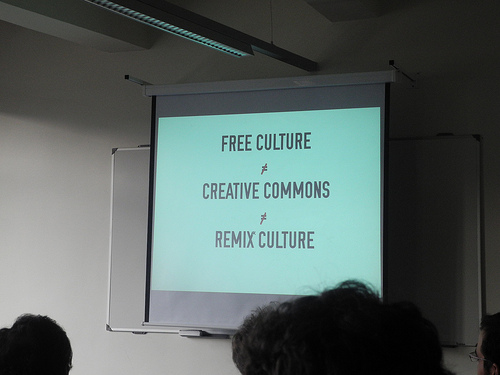
In his presentation, entitled “Libre Workflows – A Tragedy In 3 Acts”, Aymeric Mansoux was quick to point out that Creative Commons licences do not cover the source of the artwork. To put it into context, a JPG is covered by a Creative Commons licence but is the XCF/PSD file? Mansoux also considered what is actually a finished piece of artwork? In a remix culture is an artwork ever finished? Mansoux refers to this quote from Michael Szpakowski for further elaboration:
I’ve found it helpful to think of any artwork, be it literary, visual art or music as a kind of fuzzy four dimensional manifold. So the “complete” artwork is the sum of all its instances in time, and all epiphenomena. The entire artwork, seen this way, is a real and precisely enumerable sum, a concrete, not imaginary, set, which could be knowable in its entirety by something long lived and far seeing enough.
From their home town of Porto, Portugal, Ana Carvalho and Ricardo Lafuente produce Libre Graphics Magazine with ginger coons who is based in Toronto, Canada. For the production of the magazine they use Git, with their repository being hosted on Gitorious. As a tool for sharing files between collaborators Git is very useful. However, they explained that they feel they are not making effective use of all that Git has to offer. Part of this comes from the complexity of using Git. There are more than 140 commands in Git, each with their own unique function. These are usually entered via the command-line, but there are a number of programs with a Graphical User Interface (GUI) available. Programs with a GUI are usually favoured over command-line programs as they remove some of the complexity. Carvalho and Lafuente have found, however, that many of of these GUI programs simply replace commands with buttons, which doesn’t remove any of the complexity in using Git. What is needed is an easy to use specialised tool for the production of art.
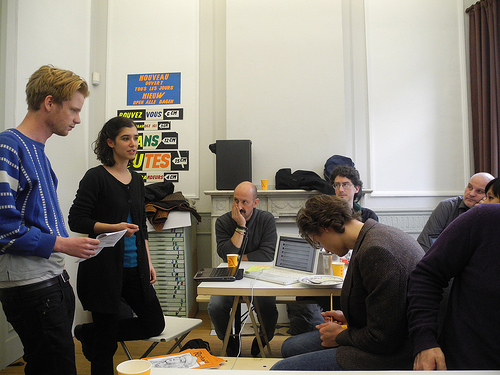
In this work session, presented by Ana Carvalho and Eric Schrijver, the work group imagined how to adapt existing version control tools to meet the needs of artists and designers. The session began by taking a look at how people currently implement version control. A common practice is to manually make backups, renaming files to differentiate between stages. This can be an effective way of making different versions, but it doesn’t address other issues such as making comparisons or merging changes. The ineffectiveness of these manual methods is soon very apparent. The work group was introduced to the Open Source Publishing (OSP) Visual Repository viewer, which begins to respond to some problems with current version control systems by providing thumbnails of files in a repository.
Using this as a basis we began to look at other functions that the OSP Visual Repository viewer should have, such as the ability to compare graphical files in different ways and to revert back to previous versions or merge versions. Although there was no time to produce working code we did seek to address the complex task of merging and comparing not only the ouput file but also the working files (svg/xcf/psd).
Every good work of software starts by scratching a developer’s personal itch.
This quote from The Cathedral and the Bazaar by Eric Steve Raymond could not be more accurate in describing the motivations behind the development of Laidout, developed by Tom Lechner, a comic artist from Portland, Oregon. Perhaps one of the most impressive software demonstrations of LGRU, Laidout is a program for laying out artwork on pages with any number of folds, which don’t even have to be rectangular.
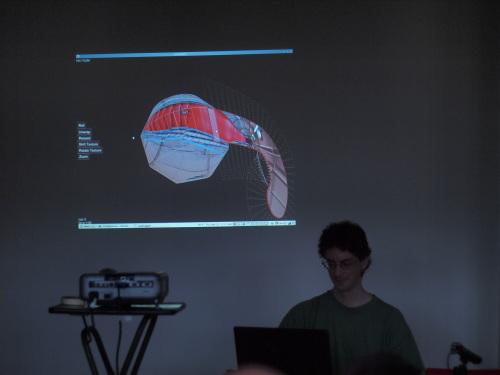
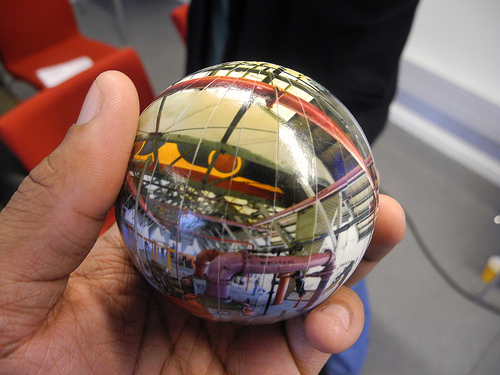
In an attempt to devise new tags that can be added to the SVG specification, Michael Murtaugh and Stephanie Villayphiou presented a work session that looked at the different ways language is interpreted by both humans and computers. To address this the work group took part in a task that saw them act as an interpreter of commands. With nothing more than a list of tags used in SVG files the work group would attempt to construct shapes.


The results varied from person to person and highlighted an important question: How can computers interpret ambiguity
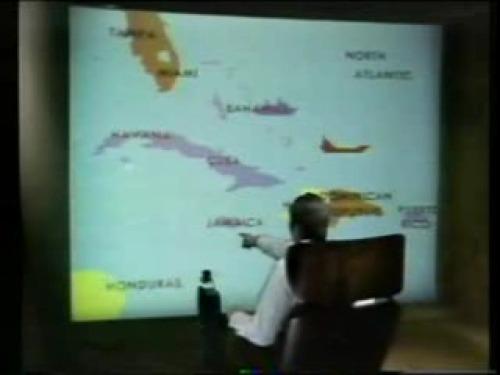
Using the Richard A Bolt “Put that there” demonstration, Murtaugh showed how human-computer interaction is still based around using very clear, unambiguous commands that can be easily interpreted by computers. In SVG only the most basic of shapes – rectangles, circles and lines – are represented. But, as the work group participants asked, could there be tags to represent more complex shapes, such as a horse?
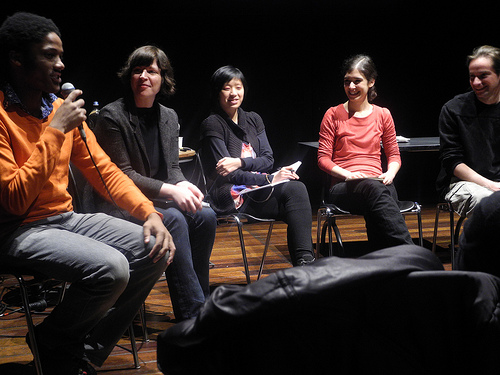
On the final day of the meeting I took part in a roundtable discussion, chaired by Angela Plohman and featuring myself, Stephanie Vilayphiou, Camille Bissuel and Ana Carvalho. The discussion first went over all that we had achieved over the four days at the meeting, and then the discussion focused on how and why we share our artwork. Expanding on the earlier quote from Szpakowski, how can we make sharing all of our artwork – including the early stages and inspirations behind it – an easier and integrated part of making artwork? In addition to sharing our final, “finished” artworks do we want to also share our processes and ideas behind the artwork? More importantly, can software easily aid this?
Other topics debated in the discussion revolved around opening up our artwork and processes to others. By opening up the development process of our artwork do we do so to invite collaborators and contributions or just observers? The Blender Open projects, for example, are highly regarded as an example of the work that can be made using open source software. The files used to make these projects are are released upon completion of the project, but the development process remains closed to the team of artists and developers. Would opening up this process to contributors add any value or could having too many ideas dilute the original vision of the project.
Although no conclusions around these topics were made, it was nonetheless important for everyone at the meeting to think critically about their practice
A concern of mine is that research is not always acted up on and exciting possibilities exist only as theory. However, I feel that the approach of Libre Graphics Research Unit, which combines research and practice, will ensure that the work undertaken at the meetings is implemented. It is actively working with developers and users to try and create solutions.
At the Co-Poistion meeting not one final product was made, but the initial vision for the future of layout was formed.
The next meeting, Piksels and Lines, takes place in Bergen, Norway and is organised by Piksel.
This show is curated jointly by Helen Sloan of SCAN and the John Hansard Gallery, Southampton. There is both curatorial interest in the technological aspects of the work as well as the subject matter of the war artist. Sloan was approached by the Arts Council in terms of initiating a project for the ‘Interact’ series of commissions, on which she worked with David Cotterrell. In 2007, Coterrell went to Afghanistan as artist-in-residence for a month in a field hospital. At his residency in 2008, at SEOS (now Rockwell Collins), a company that makes flight simulators. He explored the nature of representation itself, and particularly ‘the suspension of disbelief’. This relates to our relationship with digital data, and how often we regard it as more real, due to its nominal representation of reality and our use of this as information.
What appear to be ‘A-life critters’, are in fact scaled down human forms. Trawling across a dust-sculpted landscape, the real of the chalk dust intersects with the virtual projections of the A-life program which is mapping the movement of these forms to the reality of the sculpted landscape.
David Cotterrell doesn’t want to show pictures of the atrocities of war, but instead focuses on the complex experience of lived space in territorial combat and its mapping. He presents a kind of ‘topo-analysis’ of an imaginary space, with nominal figures located and moving in spatial relationship to one another. In Observer Effect the gallery viewer triggers the movement of the virtual entities who are attracted by a ‘sphere of influence’ to the viewers position in the gallery space. In this way, the phenomenon of space, location and relationship and the concomitant fear of combat, casualty, and mortality are implicit in the context of this exhibition.
Cotterrell has chosen to interrogate image making using technology, much as Vilém Flusser recommended, together with a lack of acceptance of the ‘normal’ indexical uses of photography and film about which he is ambivalent, although he used these media in Afghanistan.
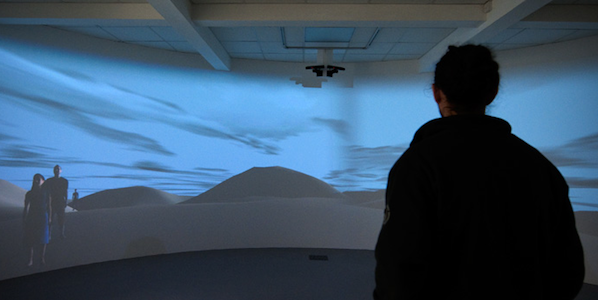
What these works achieve is the proposition of a ‘possible world’ where depersonalisation is understood as part of the virtual, nominal, mapped collective fantasy, which somehow then relates to the changing ‘world view’ of the Western citizen. It is also where the reference to science fiction comes from, ‘Monsters of the Id’ referring to the film Forbidden Planet. Science fiction is perhaps referred to in order to re-conceptualise our thinking as part of this Western view. In this sense it is about empowering us to think differently about the portrayal of conflict itself in the twenty-first century and to understand it as lived experience within specifically managed environments.
This is largely achieved through Cotterrell’s translation of his own experience as war artist in Afghanistan. He seems to want his experience to affect the viewer in a way which is different from that which he witnessed, to a reliance on the imagination instead, provoked by the portrayal of the landscape and militarised environment. Instead the exploration is one of attempting to convey the sense of isolation he felt in the military field hospital.
What becomes apparent on seeing this work, is that we are being presented with data objects, which we are then encouraged to relate to, as though they are the nominal representation of real subjects. It is significant that the work is realised with new technology. All three main works in the show explore a similar landscape but use three different projection systems. In Observer Effect the system relates to interaction with the gallery visitor who influences the installation in spatial relativity, through a device that senses and then calculates, through the algorithms and maths of a game engine, their relationship to the virtual space. Alternatively, in Searchlight 2, there is a synthesis between real and virtual as the figures traverse the landscape. He has said in relation to this piece that ‘from a great distance we lose empathy with the figures crossing the landscape’. In Apparent Horizon, the viewer encounters a semi-immersive relationship with video projected onto specially designed hemi-spheres, a view of the horizon, and a lengthy period of waiting for something to happen, which captures the tension between periods of violence. In this sense the artist has worked both as a war artist and as an artist using and developing the application of new technologies.
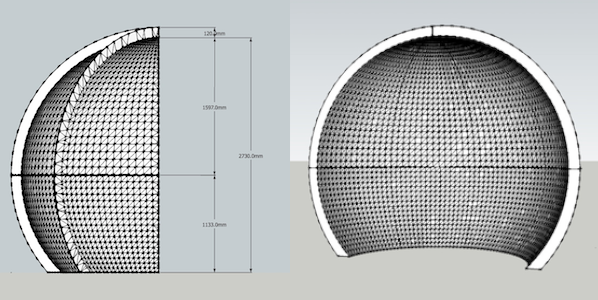
He talked about computer programming having a tendency towards ‘megalomaniac control’, and that the installation was addressed towards ‘how an audience inhabits a gallery’, with no ‘fetishizing of computers’. The residency at SEOS has obviously affected the nature of the technology employed in the work, with two ‘black boxes’ enabling aspects of the projections, as well as the hemi-spheres as immersive hardware. The system of Observer Effect is adaptive and therefore responds to the accumulated impact of viewers in the gallery. He talked about how a commercial games company would find it easy to make, but for him it had been a steep learning curve.
Cotterrell was able to return to Afghanistan in early 2008, due to support from the RSA, and was therefore able to look at the territory of the desert ‘outside the bubble of the military’, which had given him a limited understanding of the environment, a sense of dislocation, and the apprehension of casualties brought from the desert war zone. On this occasion he grew a beard and was able to disguise himself sufficiently so that he could interact with different groups of Afghani people and to gain a ‘pluralism of experience’, as on this occasion he was not part of the chain of command. In this second journey, he was ‘low value’ and therefore able to wander more freely.
Initially, he found it difficult to deliver art work in response to what he had experienced in Afghanistan. He was aware of the historical dilemma of the conflict between medicine and war. But for him, the trauma was ‘quieter’ and involved loss of identity. For example, the twenty-one year old soldier who after severe injury was ambiguous about what would happen for the rest of his life.
He found the operating theatre at the field hospital was ‘like a stage set’, and he took photographs of the surgeons, but found that the documentation ‘didn’t document’ sufficiently his lived experience. At one point he left a video camera running, documenting the arrival of casualties and then, when he was back at home, he edited the footage and left only the moments when attendant individuals ‘allowed their guard to drop’. He questioned though, whether ‘it was right to document trauma’. This left him with the ‘impossibility of conveying content’.
As war artist he has chosen to explore the military and political relationships with the technological portrayal of soldiers and civilians within a territorial combat zone. This is sufficient for Cotterrell in order to convey the sense of isolation and the particular landscape of Afghanistan. In this way, apprehending the virtual or nominal as a way of perceiving what could be real, and is real in a conflict situation, puts the viewer in a complex position, of both suspending disbelief and recognising the construct. The final work Monsters of the Id, includes in a small installation an army tent, desk and military communications equipment. This conjures up an image of Cotterrell’s experience as a war artist, although in fact it is his portrayal of how we might think of it – as naïve in other words.
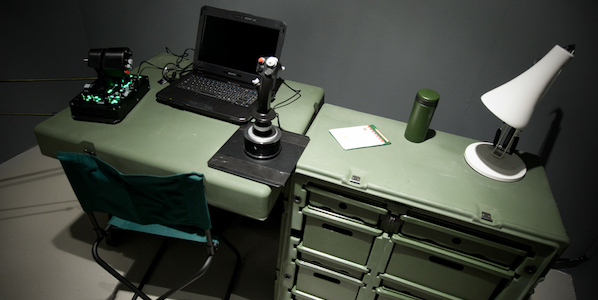
For the team of curators, gallery staff, and the artist, it has been curatorially important to work within the gallery space and Cotterrell claims that the ‘virtual can only really be understood in a gallery context.’ This is enabled through the works being not fully immersive so that you can stand back and reflect. As such the show is all about ‘the manipulation of imagery’ informed by the residencies in Afghanistan and at SEOS.
The exhibition continues till 31 March 2012 at the John Hansard Gallery, Southampton
“It is not accidental that at a point in history when hierarchical power and manipulation have reached their most threatening proportions, the very concepts of hierarchy, power and manipulation come into question. The challenge to these concepts comes from a redsicovery of the importance of spontaneity – a rediscovery nourished by ecology, by a heightened conception of self-development, and by a new understanding of the revolutionary process in society.” Murray Bookchin. Post-scarcity and Anarchism (1968).
The rise of neo-liberalism as a hegemonic mode of discourse, infiltrates every aspect of our social lives. Its exponential growth has been helped by gate-keepers of top-down orientated alliances; holding key positions of power and considerable wealth and influence. Educational, collective and social institutions have been dismantled, especially community groups and organisations sharing values associated with social needs in the public realm. [1] Bourdieu.
In this networked society, there are controversies and battles taking place all of the time. Battles between corporations, nation states and those who wish to preserve and expand their individual and collective freedoms. Hacktivist Artists work with technology to explore how to develop their critical and imaginative practice in ways that exist beyond traditional frameworks of art establishment and its traditions. This article highlights a small selection of artists and collaborative groups, whose work is linked by an imaginative use of technology in order to critique and intervene into the opressive effects of political and social borders.
In June 2000, Richard Stallman [2] when visiting Korea, illustrated the meaning of the word ‘Hacker’ in a fun way. When at lunch with some GNU [3] fans a waitress placed 6 chopsticks in front of him. Of course he knew they were meant for three people but he found it amusing to find another way to use them. Stallman managed to use three in his right hand and then successfully pick up a piece of food placing it into in his mouth.
“It didn’t become easy—for practical purposes, using two chopsticks is completely superior. But precisely because using three in one hand is hard and ordinarily never thought of, it has “hack value”, as my lunch companions immediately recognized. Playfully doing something difficult, whether useful or not, that is hacking.” [4] Stallman
The word ‘hacker’ has been loosely appropriated and compressed for the sound-bite language of film, tv and newspapers. These commercial outlets hungry for sensational stories have misrepresented hacker culture creating mythic heroes and anti-heroes in order to amaze and shock an unaware, mediated public. Yet, at the same time hackers or ‘crackers’ have exploited this mythology to get their own agendas across. Before these more confusing times, hacking was considered a less dramatic activity. In the 60s and 70s the hacker realm was dominated by computer nerds, professional programmers and hobbyists.
In contrast to what was considered as negative stereotypes of hackers in the media. Steven Levy [5], in 1984 published Hackers: Heroes of the Computer Revolution [6]. In three parts, he writes about the canonical AI hackers of MIT, the hardware hackers who invented the personal computer industry in Silicon Valley, and the third-generation game hackers in the early 1980s. Yet, in this publication, what has had the most impact on hacker culture and is still used widely as a guideline by many is the ‘hacker ethic’. He identified this Hacker Ethic to be a code of practice consisting of key points such as that “all information is free”, and that this information should be used to “change life for the better”.
1. Access to computers—and anything which might teach you something about the way the world works—should be unlimited and total. Always yield to the Hands-on Imperative!
2. All information should be free.
3. Mistrust authority—promote decentralization.
4. Hackers should be judged by their hacking, not bogus criteria such as degrees, age, race or position.
5. You can create art and beauty on a computer.
6. Computers can change your life for the better.
Levy’s hacker ethic promotes the idea of performing a duty for the common good, an analogy to a modern day ‘Robin Hood'[ibid]. Proposing the concept that hackers are self-reliant whilst embracing a ‘healthy’ anti-authoritarian stance, combined with free and critical thinking. Proposing that hackers should be judged by their ability to hack, and presenting hacking as an art-form. Levy also says that the Free and open source software (FOSS) movement is the descendant of the hacker ethic. However, Levy’s hacker ethic has often been quoted out of context and misunderstood as to refer to hacking as ‘breaking’ into computers. This specifically prescribed role, denies the wider and creative context of what hacking is and could be. It does not have to be just about computer security.
This leads us to ‘crackers’. All crackers hack and all hackers hack. But, crackers are seen as second rate wannabe hackers by the older generation of hackers. The Black Hat Hacker or cracker designs and releases malicious code, gathers dangerous information and brings down sensative systems. The White Hat Hacker hunts down and destroys malicious code, and the casual hacker who hacks in order to learn information for his or her own curiosity; both generally dislike ‘Black Hats’ and ‘Crackers’, and tend to view them as computer criminals and dysfunctional juveniles. Lately, crackers have also been labeled as ‘script kiddies’. As a kind of snobbish insult, it refers to those who are not capable of building or programming their own tools, but tend to use scripts and programs written by others to perform their intrusions. To add to the confusion we also have the term ‘Grey hat’. Which refers to a hacker acting between black hat and white hat. Indeed, this could demonstrate where art hacktivists reside, challenging the trappings of the traditional concept of goody and baddy.
“There is another group of people who loudly call themselves hackers, but aren’t. These are people (mainly adolescent males) who get a kick out of breaking into computers and phreaking the phone system. Real hackers call these people ‘crackers’ and want nothing to do with them.” [7] Raymond.
“The basic difference is this: hackers build things, crackers break them.” [ibid] Raymond.
But before we judge,
let’s view a snippet of the \/\The Conscience of a Hacker/\/ by +++The Mentor+++
Written on January 8, 1986.[8]
“This is our world now… the world of the electron and the switch, the
beauty of the baud. We make use of a service already existing without paying
for what could be dirt-cheap if it wasn’t run by profiteering gluttons, and
you call us criminals. We explore… and you call us criminals. We seek
after knowledge… and you call us criminals. We exist without skin color,
without nationality, without religious bias… and you call us criminals.
You build atomic bombs, you wage wars, you murder, cheat, and lie to us
and try to make us believe it’s for our own good, yet we’re the criminals.”
The term ‘Hacktivism’ was officially coined by techno-culture writer Jason Sack in a piece about media artist Shu Lea Cheang published in InfoNation in 1995. Yet, the Cult of the Dead Cow [9] are also acknowledged as defining the term. The Cult of the Dead Cow are a group of hackers and artists. They say the Hacktivism phrase was originally intended to refer to the development and use of technology to foster human rights and the open exchange of information.
Hacktivism techniques include DoS attacks, website defacement, information theft, and virtual sabotage. Famous examples of hacktivism include the recent knocking out of the PlayStation Network, various assistances to countries participating in the Arab Spring, such as attacks on Tunisian and Egyptian government websites, and attacks on Mastercard and Visa after they ceased to process payments to WikiLeaks.
Hacktivism: a policy of hacking, phreaking or creating technology to achieve a political or social goal.
“Hacktivism is a continually evolving and open process; its tactics and methodology are not static. In this sense no one owns hacktivism – it has no prophet, no gospel and no canonized literature. Hacktivism is a rhizomic, open-source phenomenon.” [10] metac0m.
The practice or behaviour of Hacktivism is at least as old as Oct 89 when DOE, HEPNET and SPAN (NASA) connected to (virtual) networked machines world wide. They were penetrated by the anti-nuclear group WANK worm.
WANK penetrated these machines and had their login screens altered to…
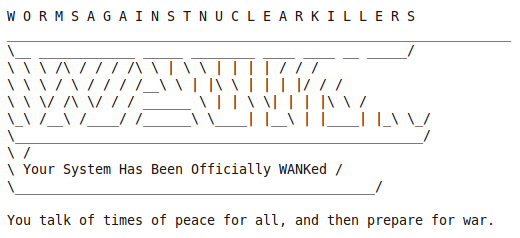
HACKING BORDERS: Examples of Art Hacktivism & Cultural Hacking…
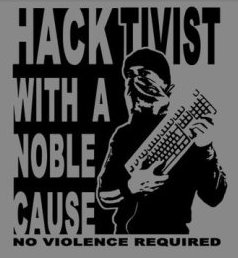
“Radical groups are discovering what hackers have always known: Traditional social institutions are more vulnerable in cyberspace than they are in the physical world. And some members of the famously sophomoric hacker underground are becoming motivated by causes other than ego gratification.” [11] Harmon.
Hacktivism, exploits technology and the Internet, experimenting with the immediacy of distributable networks as a playful medium for independent, creative and free expression. There has been a gradual and natural shift from net art (and net.art) into Hacktivism. Net Art in spirit, has never really been just about art being viewed on a web browser alone. Some of the very same artists whose artwork involved being shown in browsers and making code behind the browser as part of the art, have also expanded their practice outside of the browser. One such artist is Danja Vasiliev, “Fifteen years ago WWW was something very new in Russia and besides the new dial-up aesthetics and world-wide means it brought a complete new layer of existence – “netosphere”, which made my youth.” Vasiliev very soon moved on from playing with browsers into a whole new territory. [12]
Danja co-founded media-lab moddr_ in 2007, a joint project at Piet Zwart Institute alumni and WORM Foundation. Based in Rotterdam moddr_ is a place for artists and hackers, engaging with critical forms of media-art practice. He collaborated with Gordan Savicic and Walter Langelaar from the moddr.net lab on the project Web 2.0 Suicide Machine, which lets you delete your social networking profiles and kill your virtual friends, and it also deletes your own profile leaving your profile image replaced by a noose.”The idea of the “Web 2.0 Suicide Machine” is to abandon your virtual life — so you can get your actual life back, Gordan Savicic tells NPR’s Mary Louise Kelly. Savicic is the CEO — which he says stands for “chief euthanasia officer” — of SuicideMachine.org.” [13]
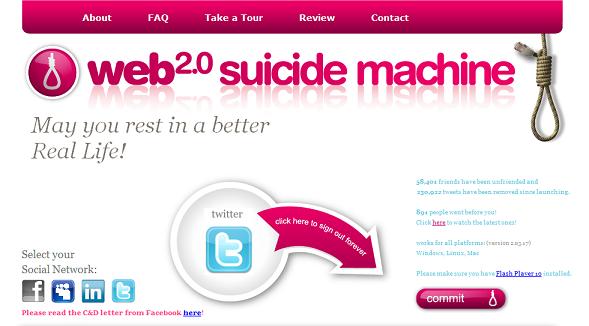
Just like another project called ‘Face to facebook’ that stole 1 million facebook profiles and re-contextualized them on a custom made dating website (lovely-faces.com), set up by Italian artists Paolo Cirio and Alessandro Ludovico, whom also just so happens to be editor in chief of Neural magazine. Web 2.0 Suicide Machine, had to close its connections down regarding its Facebook activities after receiving a cease and decease letter from Facebook. [14]
Julian Oliver and Danja Vasiliev teamed up and formed the mysterious group Men in Grey. The Men In Grey explore our online vulnerabilities by tapping into, intervening into wireless network traffic. Observing, tracing and copying what we do. This hack then redisplays our activities back to us, showing the data of our online interactions.
At first no one (except myself & a few others) knew who they were. When they first arrived on the scene I started an interview with them and then suddenly, I was asked to hold back due to their antics on the Internet and interventions in public environments receiving much coverage. They were not sure how it would pan out for them. Partly due to the anonymous nature of their project, and also because of the sudden impact of the larger hacktivist group Anonymous getting much press in commercial media themselves.
“Men In Grey emerge as a manifestation of Network Anxiety, a fearful apparition in a time of government wiretaps, Facebook spies, Google caches, Internet filters and mandatory ISP logging.” M.I.G
“Spooks are listening into calls, just like they always have,” said Eric King of London’s Privacy International, in an e-mail. “With A5/1 being broken—you can decrypt and listen into 60 calls at once with a box smaller than a laptop.” [15]
Later they won the Golden Nica (1st prize) Interactive Arts category, Prix Ars Electronica in 2011. In a show called Project Space — M.I.G. — Display of unknown, quarantined equipment hosted at the Aksioma Project Space Komenskega, Ljubljana 2011. The statement read:
“The particularly threatening quality of the Men In Grey equipment is its apparently invasive nature; it seems able to penetrate – and even hack into – virtually any electronic device in its reach. While we are all aware of the wire-tapping and data retention done by the government (along with the spying carried out by corporations like Facebook and Google), Men In Grey seem to operate with a range of tools and techniques well beyond those that are currently known to be in use.”
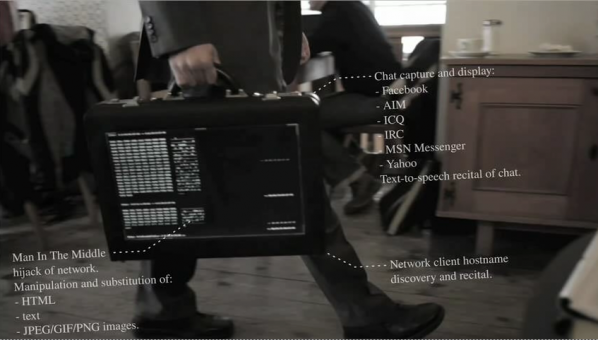
Hacktivism involves many different levels of social intervention and engagement. Whether it is to do with direct action, self-referential geekiness, obscure networked antics, crtical gaming, or peer 2 peer and collective change. Hacktivists challenge defaults put in place by other people, usually the systems imposed upon them and the rest of us by authority. Even though the subjects themselves may be concerning serious matters, humour and playfulness are both essential ingredients.
“A promising tactic for the early Situationists was the unpredictable yet forceful potential of play — what anthropologist Victor Turner termed the “liminoid,” or the freeing and transformational, moments of play when the normal roles and rules of a community or society are relaxed.” [16] Dovey & Kennedy.
One group crossing over from the digital into physical and social realms, is Tiltfactor. [17] Their form of intervention is not necessarily about causing political controversy, but is engaged in reaching people through games of play. Experimenting with social everyday contexts, making games that tackle less traditional topics, such as public health, layoffs, GMO crops. One of the many games creating awareness on these subjects, is POX “Our game actually helps a player understand how a disease can spread from one place to another and how an outbreak might happen” says Mary Flanagan. [18]
A local public health group called Mascoma Valley Health in the New Hampshire region of the US approached Tiltfactor with the problem of the lack of immunization. “At first, a game about getting people immunized seemed like one of the most “un-fun” concepts imaginable. But that sinking feeling of impossibility almost always leads to good ideas later.” [19] Flanagan.
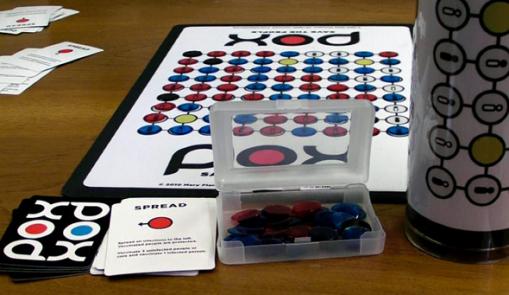
“Geopolitical space has always been a conflicted and fragile topic. Borders and frontiers are changing so fast, that sometimes it seems that our sociopolitical status can change from “citizen” to “immigrant” from one moment to another, or simply live under the “immigrant” status all your life. We’re getting used to words like refugees, enclaves, war, borders, limits –and the list has no end.” Ethel Baraona Pohl & César Reyes
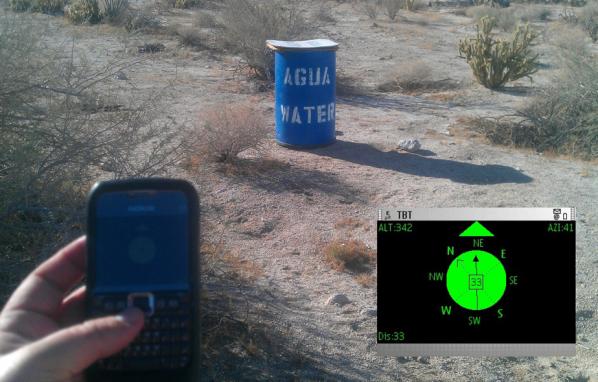
Ricardo Dominguez collaborated with Brett Stalbaum, Micha Cardenas, Amy Sara Carroll & Elle Mehrmand, on (TBT) (and others), on a hand-held mobile phone device that aids crossers of the Mexico-US border. An inexpensive tool to support the finding of water caches left in the Southern California desert by NGO’s for those crossing the border.
“The entire group of artists who are part of Electronic Disturbance Theater 2.0/b.a.n.g. lab working on the Transborder Immigrant Tool (TBT) was being investigated by UCSD and 3 Republican Congressmen starting on January 11, 2010. Then I came under investigation for the virtual sit-in performance (which joined communities statewide against the rising students fees in the UC system and the dismantling of educational support for K–12 across California) against the UC Office of the President (UCOP) on March 4, 2010. This was then followed by an investigation by the FBI Office of Cybercrimes.” [20] Ricardo Dominguez.
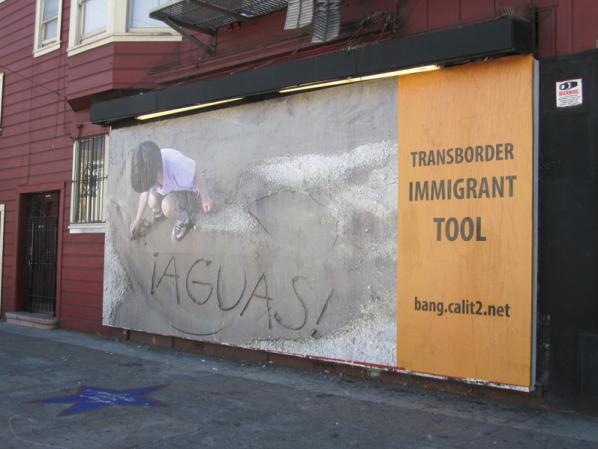
In an interview with Lawrence Bird Dominguez discusses that the TBT is still developing as a gps tool, but infers that it is not just a tool but also ‘border disturbance art’, consisting of different nuances existing as part of a whole with other factors at play. Such as a hybrid mix of things, objects and expressions “artivism, tactical poetries, hacktivism(s), new media theater, border disturbance art/technologies, augmented realities, speculative cartographies, queer technologies, transnational feminisms and code, digital Zapatismo, dislocative gps, intergalactic performances, [add your own______].” [ibid]
“Borders are there to be crossed. Their significance becomes obvious only when they are violated – and it says quite a lot about a society’s political and social climate when one sees what kind of border crossing a government tries to prevent.” [21] Florian Schneider
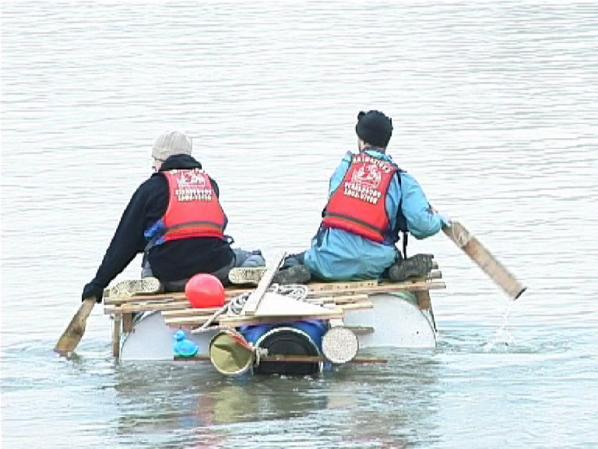
National borders are front-lines of political and social friction. The exerience of asylum-seekers and political migrants reflect some of the most significant issues of our time. Immigration is a toxic issue and unpopular with voters. Bunting’s BorderXing Guide, plays on the fear of invisible alien hordes of people crossing our borders illegally.
The context of this work fits well with issues about borders, whether it is about creating borders online or physical environments. Only those needing to cross a border are allowed access to the site, it is limited to ‘social clients’ who have a static IP (Internet Protocol) address and who, most notably, have gained the artist’s confidence. Such as peer activists and immigrants using libraries, colleges, cultural centres. The site allows those who would other wise end up crossing borders in harmful ways, such as in containers, on the backs of (and underneath) lorries and planes.
Heath Bunting’s BorderXing Guide website primarily consists of documentation of walks that traverse national boundaries, without interruption from customs, immigration, or border police. The work comments on the way in which movement between borders is restricted by governments and associated bureaucracies. It is a manual written not at distance like a google map, but by foot. A physical investigation, involving actually going to these places; trying these discovered routes out and then sharing them with others. A carefully calculated politics of public relations.
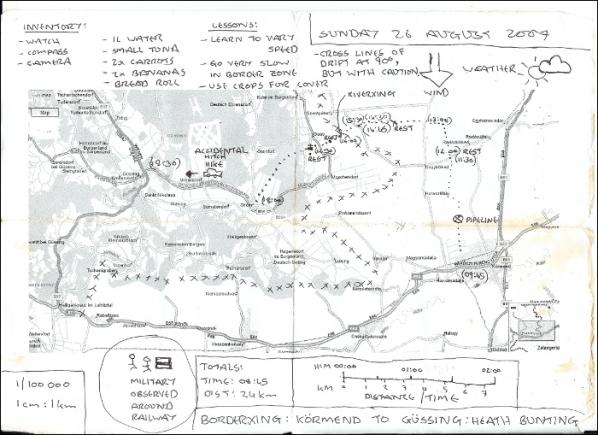
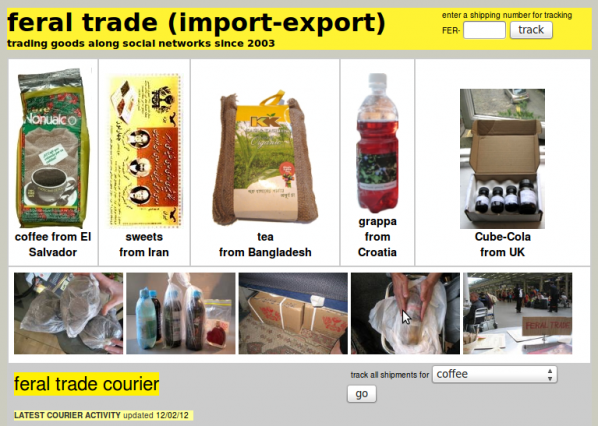
“The Feral Trade Café is more than just an art space that’s a working café, it’s about provoking people to question the way big food corporations operate by looking at the journey of the food we end up scraping into our pampered bins.” [22] Gastrogeek
Feral Trade uses social and cultural hand baggage to transport food based items between cities, often using other artists and curators as mules. Feral Trade products (2003-present), alongside ingredient route maps, bespoke food packaging, video and other artefacts from the Feral Trade network. The goods rangefrom coffee from El Salvador, hot chocolate from Mexico and sweets from Montenegro, as well as locally sourced bread, vegetables and herbs.
Kate Rich uses the word ‘feral’ as a process refering to being deliberately wild, as in pigeon, as opposed to romantic nature wild as the wolf. It is an unruly wild, shitting everywhere, disruption and annoyance in contrast to ‘official’ human structures and connected infrastructures. Feral Trade freight operates largely outside commercial channels, using the surplus potential of social, cultural and data networks for the distribution of goods. Working with co-operatives, small growers and food producers.
The Feral Trade Courier is a live shipping database for a freight network running outside commercial systems. The database offers dedicated tracking of feral trade products in circulation, archives every shipment and generates freight documents on the fly.
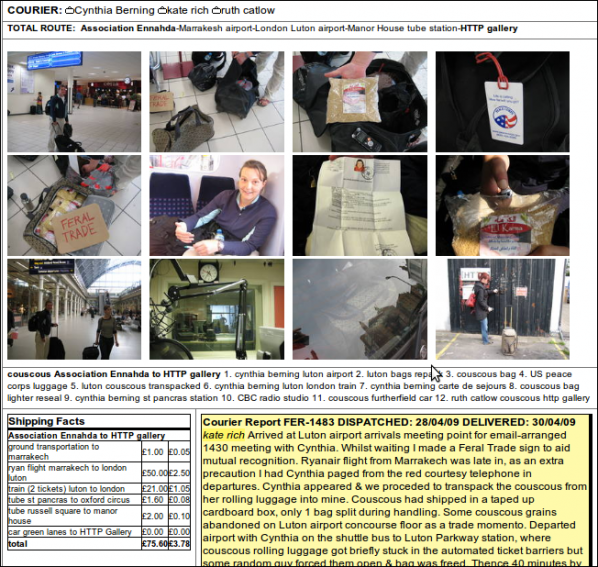
Every shipment is different and has its own story of how and where it was delivered from. Also included is information on who the carriers are with details about producers and their local culture as contextual information. The product packaging itself is also a carrier of information about social, political context and discussions with producers and carriers.
![Feral Trade at Furtherfield's Gallery (2009) [23] Link to exhibition](http://www.furtherfield.org/wp-content/uploads/2012/03/3657297700_42b1c26014_b.jpg)
Since the rise of the Internet individual and collective actions are symbiotically connected to the every day. In a world transformed, common people have access to tools that can change ‘our’ cultures independently; sharing information, motivating actions and changing situations. We know of the Arab Spring, the Occupy movement, Anonymous and Wikileaks and how successful they have been in exploiting technology and social networks. Technology just like any other medium is a flexible material. By tweaking, breaking and remaking ‘something’ you can re-root it’s function, change its purpose.
The links between these mass social movements and the artists here are not just relating to technology’s use but, a shared critique at the same enemy, neo-liberalism.
“”Neo-liberalism” is a set of economic policies that have become widespread during the last 25 years or so. Although the word is rarely heard in the United States, you can clearly see the effects of neo-liberalism here as the rich grow richer and the poor grow poorer.” [24] Martinez & Garcia.
At the same time as highlighting the continual privatization of human society. This form of art practice shows us the cracks of where a social divide of gate-keeping has maintained power within the Western World’s, traditional art structures. We now realize that the art canons we have been taught to rely on as reference are more based around privelage, centralization and market dominance rather than democratic representation or even just pure talent. Hacktivist artists adapt and recontextualize with a critical approach, towards a larger and more inclusive context beyond their own immediate selves. Demonstrating a respect and use of autonomy, and an awareness of social contexts and political nuances, freeing up dialogue for new discussions which include a recognition of social contexts, as a vital ingredient and valued resource in art. Re-aligning, reconfiguring the defaults of what art is today.
Lies, Lawlessness and Disbelief 1. Thinking Art and Capital: Conceptual Capitalism and Risk Management, is the first of five essays by Canadian artist & critical thinker, Katie McCain. McCain discusses how capitalism has become on the one hand all encompassing and on the other utterly unreal. Arguing that we need to be prepared to think the impossible so that resistance is able to grow.
DOWNLOAD the full text (including all 5 parts) here.
An Attempt at Thinking Art and Capital: Conceptual Capitalism and Risk Management
this sentence is a lie[1]
Capitalism is no longer the simple fordist system of production and consumption. It has, in its post-fordist lifetime become a more and more complex and intangible form. Today, it is a conceptual capitalism that has become unmoored, free floating, and all encompassing. As it continues, capital has the amazing ability to subsume everything it encounters, including criticism and resistance.[2] This proliferation seems to leave little room to resist – there is no longer a way to step outside and critique, since the death/failure of really existing socialism,[3] but this means only that critique must come from within, which is no small feat. It is a method riddled with paradox and self-defeat, but this perhaps reflects the nature of capital itself – as a system it offers up many moments of fissure or collapse that can be manipulated. The vastness of capitalism and the complexity of the bureaucracy necessary to hold together a system of “order” that directly contradicts chaos theory inevitably begins to circle and break down. It is these moments of circuity, of fissure, that this essay will focus on.
Contemporary capitalism is conceptual capitalism – it runs on the idea of money in the form of loans, mortgages, hedge funds, junk bonds; it is fictional money and a fictional market based on an elaborate system of risk management, which implies some intrinsic (but impossible) knowledge of the future. It also seems that this fictional market can be bolstered by belief alone. ‘The financial crisis of 2008 showed enormous sums of money spent not on a real, concrete problem, but rather to restore belief in the market. Capital, in all its intangible forms, is the Real of our lives’.[4]
If what Žižek states is true, and capitalism can be equated with Lacanian theory of the Real[5], it again seems to close down access to it further still. It is opposed to reality, which encompasses the Imaginary and the Symbolic and it is located beyond them, out of reach, but exerting influence. It is undifferentiated, without fissure, always in its place.[6] It is impossible to imagine, to verbalize, to integrate in the Symbolic order. But perhaps this impossibility is the moment, the fissure, which can bring about its demise.
The signification of the Real is attempted in the Symbolic order, but is impossible. The Symbolic structures everything, and through repetition is subject to the death drive. That is, in its constant return to enjoyment the Symbolic transcends beyond pleasure in search of death. This could be seen as some radical call to accelerationism, a desire to weaponize capitalism against itself, and in a way it is, but not in the apocalyptic sense that accelerationism implies, pushing it to its extreme.[7] Rather, a radicalism could exist in simply exploiting these impossibilities, finding weak points in rationality, and the supposed rationality of capitalist systems, in its inherent bureaucracy.
This Symbolic capitalism is contingent in regards to the Real; it does not spring from it[8], but is created out of a desire to verbalize the impossible, to understand something that is impossible to understand, to socialize this intangible system. It could be said that it is impossible to speculate on the origins of the Symbolic once it is in place, generated as it is from a primal prohibition, a negation, le-nom-(non)-du-pere[9]; once capitalism is in place, it becomes impossible to see an alternative to the universe it creates.[10] This is mostly due to the all-encompassing nature of conceptual capitalism. Perhaps then, the ability to catch it in a paradox, in a state of bureaucratic failure, could open up a space to trip it up and think other and could offer a passage a l’acte.
other other other say it three times in the mirror
Employing the idea of a contingent conceptual capitalism, that is, one which is not necessary, which is indifferent to existence, one can argue that in fact it is very possible to think of the other to capitalism. It is logic and rationality that trips it up, that prevents any thought of the alternative, just as it is strictly impossible to think infinity, or an ancestral time prior to human existence. Science can prove facts about both ancestral time and descendant time (prior to and after the death of consciousness), but philosophy is paradoxically stuck with the idea of a relation to the world before or after the existence of thought[11]. How can thought think the death of thought?[12] According to Hakim Bey it is impossible to really conceive of death – it appears rather as ‘an unpleasant vagueness’[13] – the death considered is never actual death. Similarly, how can one think anti-capital from within conceptual capitalism? If it is permitted that both the universe and capitalism are contingent, and therefore completely indifferent to human existence and human thought, then the possibility for alternatives opens up.
A speculative and realistic approach to thinking capital can restore our ability to resist.
Once it is granted that the tension between equality and liberty cannot be reconciled and that there can only be contingent hegemonic forms of stabilization of their conflict, it becomes clear that, once the very idea of an alternative to the existing configuration of power disappears, what disappears also is the very possibility of a legitimate form of expression for the resistances against the dominant power relations.[14]
If conceptual capitalism encompasses everything, there is less and less physical space for resistance, unless resistance moves into the conceptual realm as well. The idea, the imaginary, the psychical: these all offer a variety of forms of resistance to a boundless capital. For the concept, in its true dematerialized form, is capable of altering systems, of bolstering illogic, of predicting the future. It is the very boundaries of thought, beyond which lies psychosis (the lack of the Symbolic, or capital) that prove to be integral in terms of non-knowledge and the unknown, a knowledge of the unknown, or a thinking of the impossible. Perhaps lies, fiction and the radical un-real can be the site of production for a capitalist alternative.
Ideas are characterized as both distinct and obscure. They are distinct insofar as they are perfectly differentiated via the reciprocal determination of relations and the complete determination of points – but obscure because they are not yet differenciated – since all Ideas coexist with one another in a state of virtual perplication.[15]
Ideas are simultaneously two things, distinct and obscure. Graham Harman introduces the idea as something not only possible, but actual insofar as an idea is thought as an image. This introduces all things possible to the realm of the actual, even if only in thought.[16]
The contemporary mantra of risk management as a fundamental economic strategy is in itself paradoxical. If, in fact, a risk could be managed, then it would not really be considered a risk. This term depends on the belief in an organized system of capitalism that extends both directions through time – the idea that it is a constant that can be depended upon, is predictable, forever. In fact, the amount of bureaucracy that goes into even the tiniest element of conceptual capitalism manifests itself through many circular moments, many points of fissure. In compatibility with Gödel’s Theorem of incompleteness, no system can be totally defined without incurring some kind of paradox. There will always be statements that are true, but that cannot be proved within the system. If the system is capable of proving certain basic facts, then one particular truth the system cannot prove is the consistency of the system itself.[17]
Risk management is nothing more than a reaffirmation of our collective belief in the predictive qualities of financialization, our collective consent to the idea that an intangible, unmoored, all-encompassing economic system can be predicted. In fact, prediction alone is a falsity that humans fall prey to frequently; the notion of the future as anything other than a continuation of the past is a mental operation at which the mind continues to fail. When thinking of tomorrow, the mind just projects another yesterday.[18] The future, or rather a human relation to the future, is deemed philosophically impossible. After all, how can consciousness think something devoid of consciousness?[19]
It is impossible for thought to think an object or event in-itself – in this sense, thought can only experience a relation between the subject and the object-as-given. Lacan argues in his fifth discourse that we do not derive libidinal enjoyment from object relations, but rather it is capital’s link of subject-to-object that frustrates and isolates the subject. Capitalism is successful in the sense that it produces a continual desire, but no longer satisfies it, which for Lacan – and a world full of neurotics – falls in line with our drives.[20]
Lacan also reorients Marx’s analysis of surplus value. An older, more tangible form of capitalism sold objects for more than it cost to make them. This ‘surplus value’ is what Marx stated that the capitalists stole from the proletariats – it was used by the capitalists for leisure or libidinal enjoyment. Now, capital demands this surplus value to be re-invested at the level of production to create an unrelenting, perpetual motion machine of production and consumption of money by a business in-itself. We are now, according to Lacan, all proletariats, subject to the will of capital that has taken over the role of master from the capitalists themselves.[21]
The debt circulates on its own orbit, with its own trajectory made up of capital, which, from now on, is free of any economic contingency and moves about in a parallel universe (the acceleration of capital has exonerated money of its involvements with the everyday universe of production, value and utility). It is not even an orbital universe: it is rather ex-orbital, ex- centered, ex-centric, with only a very faint probability that, one day, it might rejoin ours.[22]
This faint probability is the only thing tying us to capital.
Adorno, Theodor.W. Negative Dialectics. Translated by E.B. Ashton. New York: Continuum, 2005. First Published 1966 by Suhrkamp Verlag.
Associated Press. “Romanian Witches Curse Latest Government Clampdown,” The Guardian, February 9, 2011, main section, 20.
Bartlett, Monica Y., Aida Cajdric, Nilanjana Dasgupta and David DeSteno, “Prejudice from Thin Air: The Effect of Emotion on Automatic Intergroup Attitudes.” Psychological Science 15, no. 5 (May, 2004): 319-324.
Baudrillard, Jean. Global Debt and Parallel Universe. Translated by Francois Debrix. http://www.egs.edu/faculty/jean-baudrillard/articles/global-debt-and-parallel-universe/ (accessed April 4, 2011).
Baudrillard, Jean. Radical Thought. Translated by Francois Debrix. Edited by Sens & Tonka. Paris: Collection Morsure, 1994.
Bey, Hakim. T.A.Z.: Temporary Autonomous Zone, Ontological Anarchy, Poetic Terrorism. New York: Autonomedia, 2003. First Published 1985.
Bradley, Will. “Guarana Power.” in Self-Organization/Counter-Economic-Strategies, edited by Bradley, Hannula, Ricupero and Superflex, 311 – 333. New York: Steinberg Press, 2006.
Brassier, Ray. “I Am a Nihilist because I Still Believe in Truth” Interview with Marcin Rychter. Kronos: March 4, 2011 http://kronos.org.pl/index.php?23151,896 – accessed: march 23rd, 2011.
Brassier, Ray. Nihil Unbound: Enlightenment and Extinction. Basingstoke: Palgrave McMillan, 2007.
Critical Art Ensemble. Marching Plague: Germ Warfare and Global Public Health. New York: Autonomedia, 2006.
Declercq, Frédéric. Lacan on the Capitalist Discourse: Its Consequences for Libidinal Enjoyment and Social Bonds. Psychoanalysis, Culture & Society 2006, 11, (74-83).
Fisher, Mark. Capitalist Realism: Is There No Alternative? Winchester: Zero Books, 2009.
Foucault, Michel. Power/Knowledge: Selected Interviews & Other Writings: 1972-1977. New York: Pantheon Books, 1980.
Fromm, Erich. The Fear of Freedom. London: Routledge & Kegan Paul Ltd., 1966.
Groys, Boris “Art and Money,” E-Flux 24 (2011), http://www.e-flux.com/journal/view/226.
Harman, Graham. Circus Philosophicus. Winchester: Zero Books, 2010.
Hofstadter, Douglas R. Gödel, Escher, Bach: An Eternal Golden Braid. London: Penguin Books Ltd., 1979.
Holt, Jim. “The Way We Live Now: Against Happiness,” New York Times, June 20, 2004.
Horizon: What is Reality? Documentary. Directed by Helen Shariatmadari. BBC: ep. 9, 2011.
Huberman, Anthony, ed. For the Blind Man in the Dark Room Looking for the Black Cat that Isn’t There. St. Louis: Contemporary Art Museum St. Louis, 2009.
Huxley, Aldous. Brave New World. London: Vintage Books, 2007. First published 1932 by Chatto & Windus.
K-Punk Blog. http://k-punk.abstractdynamics.org/archives/004421.html
Kafka, Franz. The Castle. Middlesex: Penguin Books Ltd., 1964. First published 1926 by Das Schloss.
Kurant, Agnieszka and Nassim Nicholas Taleb. “Unknown Unknowns: A Conversation between Agnieska Kurant & Nassim Nicholas Taleb about the Benefits of Uncertainty.” Frieze, September 2010, 127 -135.
Lacan, Jacques. “Seminar on the Purloined Letter.” Yale French Studies 48 (1972): 39-72.
Lacan, Jacques. The seminars of Jacques Lacan: Book II: The Ego in Freud’s Theory and in the Technique of Psychoanalysis 1954-1955. Ed: Jacques-Alain Miller. New York: W. W. Norton and Co., 1991.
MacKinnon, Catharine A. “Feminism, Marxism, Method and the State.” Chicago Journals 8, no. 4 (1983), 635-658.
Meillassoux, Quentin. After Finitude: An Essay on the Necessity of Contingency. London: Continuum, 2008.
Mouffe, Chantal. The Democratic Paradox. London: Verso, 2000.
Noys, Ben. Persistence of the Negative: A Critique of Contemporary Continental Theory. Edinburgh: Edinburgh University Press, 2010.
Place, Vanessa and Robert Fitterman. Notes on Conceptualisms. New York: The Ugly Duckling Presse, 2009.
Stephen, Kylie. “Sexualized Bodies.” in Real Bodies: A Sociological Introduction, edited by Evans and Lee, 29-45. Basingstoke: Palgrave MacMillan. 2002.
Taleb, Nassim Nicholas. The Black Swan: The Impact of the Highly Improbable. London: Penguin Books Ltd., 2007.
Thacker, Eugene. “Nihil Unbound” review of Nihil Unbound: Enlightenment and Extinction, by Ray Brassier, Leonardo 42: no.5, (2009): 459-460, http://muse.jhu.edu/journals/leonardo/v042/42.5.thacker.html (Accessed April 2, 2011).
The Trap: What Happened to Our Dream of Freedom? Documentary. Directed by Adam Curtis. BBC Two: March 2007.
Trotta, Roberto. “Dark Matter: Probing the Arche Fossil.” Interview with Robin Mackay. Collapse: Philosophical Research and Development 2 (2007): 83-169.
Vidal, John. “Bolivia Enshrines Natural World’s Rights with Equal Status for Mother Earth.” The Guardian. April 11, 2011. Main section, 15.
Weaver, Matthew. “Romanian Witches to Cast Anti-Government Spell.” The Guardian. January 7, 2011. Main section, 23.
Wilson, Eric G. Against Happiness. New York: Sarah Critchton Books, 2008.
Žižek, Slavoj. First as Tragedy, Then as Farce. London: Verso, 2009.
Žižek , Slavoj. The Iraqi Borrowed Kettle. http://www.lacan.com/zizekkettle.htm (accessed April 4, 2011).
Žižek, Slavoj. What Rumsfeld Doesn’t Know that He Knows About Abu Ghraib. (2004) http://www.lacan.com/zizekrumsfeld.htm (accessed April 4, 2011).
Featured image: Martijn de Waal, co-founder of The Mobile City, introduces the conference (image courtesy Virtueel Platform)
On Feb. 17th Amsterdam hosted Social Cities of Tomorrow, a conference on new media and urbanism. Adapting its title from Ebenezer Howard’s Garden Cities of Tomorrow, but taking equal inspiration from the work of Archigram, the conference presented a snapshot of the direction cities are moving today: as conventional means of planning and designing are renegotiated through our engagement with new media technologies:
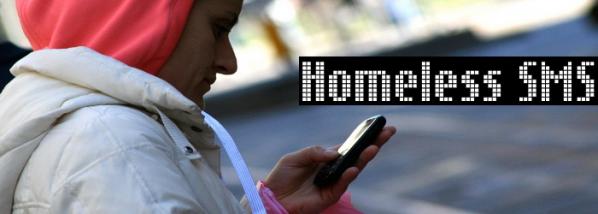
Organized by The Mobile City and Virtueel Platform, the event showcased best-practise examples of the use of media in urban analysis, design, art and activism. These ranged from “Homeless SMS”, a text-messaging system designed to provide information to the 70% of homeless Londoners who own cell phones; “Amsterdam Wastelands”, an on-line mapping of disused sites in Amsterdam and Zaanstad; “Koppelkiek”, a game project in which residents of a troubled area of Utrecht collected “couple snapshots” (in couples of friends, relatives or complete strangers), promoting social interaction through play; and “Urbanflow”, and New York-based project to rethink the contents of urban screens. In all, a dozen such projects were presented at the conference.
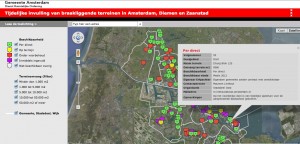

http://www.socialcitiesoftomorrow.nl/showcases
Immediately preceding the conference an intensive three-day workshop took place at ARCAM, the Amsterdam Centre for Architecture. This event brought together two dozen interdisciplinary creatives from around the world to tackle urban issues in four current case-studies: Haagse Havens, Den Haag; Zeeburgereiland; Strijp-S Eindhoven; and the Amsterdam Civic Innovator Network (a proposal to open up Amsterdam’s civic resources to distributed control by citizens). Working with local stakeholder organizations, the participants brainstormed how to leverage new media to solve intractable or new problems in these real-world sites.

http://www.socialcitiesoftomorrow.nl/workshop/the-four-cases
Also at ARCAM, a roundtable discussion on the alternative forms of trust emerging out of new media conditions was held, with panelists (below, left to right) Tim Vermeulen, Henry Mentink, Rietveld Landscape, Scott Burnham, Michiel de Lange (image courtesy Aurelie).

Keynote speakers Usman Haque, Natalie Jeremijenko, and Dan Hill concluded the conference with a panel discussion that placed the presentations in the context of distributed technology, contemporary art, social innovation, and architecture (image courtesy Virtueel Platform).

Featured image: ‘Angry Women’ by Annie Abrahams, 2011. (From photograph by Michael Szpakowski)
Opening Event: Saturday 25 February 2012, 1-4pm
Open Thu – Sat 12 noon – 3pm
contact: info@furtherfield.org
See images from the exhibition here
Read reviews of Being Social on Wired magazine and Enfield Independent
Being Social is the opening exhibition at Furtherfield Gallery in Finsbury Park in North London. Furtherfield has established an international reputation as London’s first gallery for networked media art since 2004. With this exciting move to a more public space Furtherfield invites artists and techies – amateurs, professionals, celebrated stars and private enthusiasts – to engage with local and global, everyday and epic themes in a process of imaginative exchange.

This exhibition brings together artworks by emerging and internationally acclaimed artists: Annie Abrahams, Karen Blissett, Ele Carpenter, Emilie Giles, moddr_ , Liz Sterry and Thomson and Craighead.
Since the mid-90s computers have changed our way of being together. First the Internet then mobile networks have grown as cultural spaces for interaction – wild and banal, bureaucratic and controlling – producing new ways of ‘being social’. Visitors are invited to view art installations, software art, networked performances and to get involved with creative activities to explore how our lives – personal and political – are being shaped by digital technologies.
Free activities for all ages (booking advisable) Saturday 10-1pm
Embroidered Digital Commons with Ele Carpenter and Emilie Giles
Furtherfield invites all gallery visitors to take part in one or more of our Saturday morning embroidery sessions and come together to stitch a term from the Raqs Media Collective’s text ‘A Concise Lexicon of/for the Digital Commons’ (2003), chosen in relation to the specific theme of the Being Social exhibition at Furtherfield Gallery. Throughout March and April 2012.
To book a place please contact Alessandra Scapin ale@furtherfield.org +44 (0) 2088022827

Annie Abrahams
Annie Abrahams has a doctorate in biology from the University of Utrecht and a degree from the Academy of Fine Arts of Arnhem. In her work, using video, performance as well as the internet, she questions the possibilities and the limits of communication in general and more specifically investigates its modes under networked conditions. She is an internationally regarded pioneer of networked performance art. She has performed and shown work extensively in France, including at the Pompidou Centre, Paris, and in many international galleries including, among others, Espai d’Art Contemporani de Castelló, Spain; the Museum of Contemporary Art, Tokyo; and the Armenian Center for Contemporary Experimental Art, Yerevan; festivals such as the Moscow Film Festival and the International Film Festival of Rotterdam, and on online platforms such as Rhizome.org and Turbulence.
Karen Blissett
Karen Blissett was born on the 3rd of May 1991, on the same day that the first successful double head-heart transplant was being carried out in a hospital in London. Her parents are the neoist artists Karen Eliot and Luther Blissett. They are only interested in art and politics, not in how Karen spends her days on the Internet.
Ele Carpenter
Ele Carpenter is a curator based in London. Her creative and curatorial practice investigates specific socio-political cultural contexts in collaboration with artists, makers, amateurs and experts. She is a lecturer in Curating at Goldsmiths College, University of London.
Since 2005 Ele has facilitated the Open Source Embroidery project using embroidery and code as a tool to investigate the language and ethics of participatory production and distribution. The Open Source Embroidery exhibition (Furtherfield, 2008; BildMuseet Umeå Sweden, 2009; Museum of Craft and Folk Art, San Francisco, 2010) presented work by over 30 artists, including the finished Html Patchwork now on display at the National Museum of Computing at Bletchley Park. Ele is currently facilitating the ‘Embroidered Digital Commons’ a distributed embroidery exploring collective work and ownership 2008 – 2013.
Emilie Giles
Emilie Giles is an alumnus of MA Interactive Media: Critical Theory and Practice at Goldsmiths College. Since graduating in 2010 her time has been spent co-organising MzTEK, a women’s technology and arts collective, as well as completing an internship with arts group Blast Theory and working for social video distributors Unruly. She is currently involved with TESTIMONIES, a project which explores oral history in relation to the 2012 Olympic and Paralympic Games largely through social media.
Emilie’s own practice revolves around notions of pervasive gaming, married with urban exploration and psychogeography. Her most recent focus lies in taking fundamental gaming principles from Geocaching and exploring the consequences of adding an emotional dimension.
moddr_
moddr_ is a Rotterdam-based media/hacker/co-working space and DIY/FOSS/OSHW fablab for artgeeks, part of the venue WORM: Institute for Avantgardistic Recreation. Since being founded in 2007 by alumni of the Piet Zwart Institute (department of “Networked Media“) they host and promote young local and international talent with a focus on the artistic modification (’modding‘) of contemporary and emerging technology. moddr_ represents a critical attitude in our ‘new’-medialandscape through spawning and development of artistic projects, workshop series, lectures, exhibitions and of course good parties.
Liz Sterry
Liz Sterry is an Essex based artist currently completing a Digital Art and Design degree at Writtle College. Liz works using different mediums including performance photography, video and installations. Communication has now become a key theme in her work. She aspires to make art that invites people to question what they think they already know.
Thomson and Craighead
Jon Thomson and Alison Craighead are artists living and working in London. They make artworks and installations which are shown in galleries, online and sometimes outdoors. Much of their recent work looks at live networks like the web and how they are changing the way we all understand the world around us. Their work has been shown in major international exhibitions and is part of public collections at Harris Museum and British Council Collection. They are shortlisted artists for the Samsung Art Prize 2012. Recent awards include Current (2011) and Vital Spark (2005). Having both studied at Duncan of Jordanstone College of Art in Dundee, Jon now lectures part time at The Slade School of Fine Art, University College London, while Alison is a senior researcher at University of Westminster and lectures in Fine Art at Goldsmiths University.
Four spaces – the Park, the Gallery, the Common Room, the www
Furtherfield’s new gallery at McKenzie Pavilion is located in a highly animated area of Finsbury Park next to a boating pond and adventure playground, near to the café and athletics track. The richly connected diversity of people, creatures, plants, activities, enthusiasms alive in the park provides the context and the inspiration for Furtherfield. The pavilion has two rooms.
The Gallery, which will display evocative and provocative exhibitions of selected contemporary artwork that address technology and social change drawing on Furtherfield’s international network of artists.
The Common Room, which will display work contributed by open call in response to exhibition themes, curated with local people. It will also act as the base for a series of free activities for local schools and visitors to the park.
Finally the www connects local users to an international network of enthusiasts, experts and audiences. It provides a place for people to share their artworks, proposals, ideas and commentaries. It will also provide access to further information about exhibitions, including downloadable catalogues and essays, information about programmes of free events and activities, and a living archive of all past work.
Furtherfield will exhibit the best of contemporary work in art, technology and social change in a truly ‘public’ space, developed with and for local residents and users of the park, and wider participants and audiences. Ultimately, we are looking for ways for local people and visitors to the park and from further afield to use this art space imaginatively together, and to connect with our international community of artists, designers, thinkers and technologists.
Furtherfield Gallery
McKenzie Pavilion, Finsbury Park
London N4 2NQ
T: +44 (0)20 8802 2827
E: info@furtherfield.org
Furtherfield Gallery is supported by Haringey Council and Arts Council England
Taina Bucher interviews curator Gaia Tedone about her latest online curatorial project called ‘Is Seeing Believing?’ as part of the TRUTH programme at or-bits.com, an online platform for the display of contemporary arts and production of new works. Born in Italy, in 1982 Gaia Tedone holds an MFA in Curating from Goldsmiths, and has for the past year been one of the curatorial fellows at the Whitney Independent Study Program, New York. She has been involved in a number of art projects and worked with institutions such as Whitechapel Gallery, James Taylor Gallery, The David Roberts Art Foundation and Tate Modern.
Taina Bucher: Tell me a bit about your background for doing curatorial work. How did it get started and what are some of the thematic interests that have been important to your work?
Gaia Tedone: I started doing curatorial projects in London, where I was living and working for the past five years. The time spent at Goldsmiths was extremely formative from a practical and intellectual point of view. I was involved in a number of projects – some of them in collaboration with institutions in London, such as the series of talks Curating Fictions organised at Whitechapel Gallery, others were developed within the academic context, as for instance IM magazine and the publication A Fine Red Line (A Curatorial Miscellany) which I edited with fellow curators Isobel Harbison, Ilaria Gianni, Nazli Gürlek, Rosa Lleo and Yannis Arvanitis. The latter experience led us to establish the curatorial collective IM projects – a platform for editorial projects for which I contributed for the following two years.
The MFA in Curating at Goldsmiths and the Whitney Independent Study Program have both helped me to locate my interest in the history of art production within today’s global context and to look at the ways in which specific economic and political contexts shape the production and circulation of art. These two complementary programmes of study informed my research interests, which are located at the intersection between the fields of new media and cultural studies.
This year, within the context of the Whitney Program, I was exposed to a number of seminal authors and texts that since the 70s have contributed to the development of the field of cultural studies, and I was deeply inspired by the recent work of David Harvey and the political philosopher Chantal Mouffe. This intense year of research has informed the conception and realization of the exhibition Foreclosed. Between Crisis and Possibility that I co-curated with ISP fellows Jennifer Burris, Sofía Olascoaga, and Sadia Shirazi at The Kitchen in New York.
The exhibition, which included works by Kamal Aljafari, Yto Barrada, Tania Bruguera, Claude Closky, Harun Farocki, Allan Sekula and David Shrigley, took the current housing crisis in the U.S. as the departing point to explore other meanings of the word foreclosure, which also evokes processes of exclusion and a shutting down of recognition.
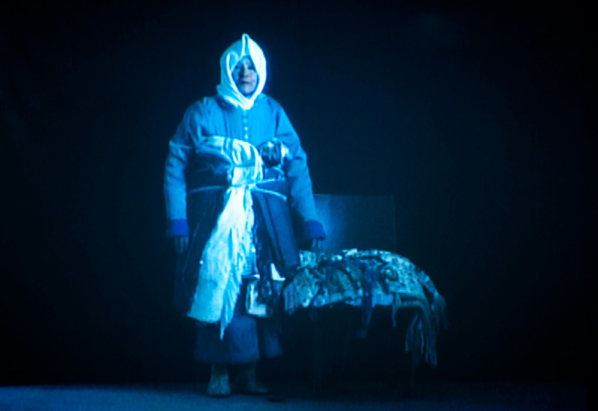
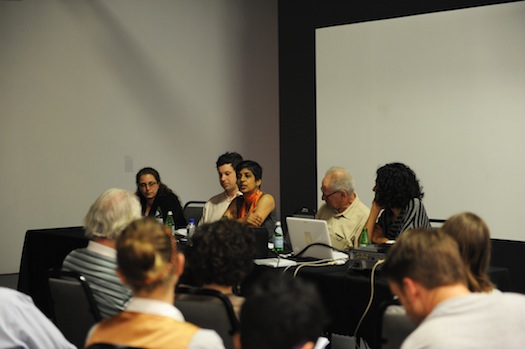
Taina Bucher: How did you get into doing online curatorial work?
Gaia Tedone: I was invited few months ago by Marialaura Ghidini to collaborate with her and Christine Takengny on the autumn issue of or-bits.com. Marialaura had some preliminary thoughts on how she wanted to develop the programme, and after few Skype meetings we established a common ground upon which we built three parallels projects. The programme curated by Marialaura was launched in early October with works by Angus Braithwaite/David Raymond Conroy/Adelita Husni-Bey/Iocose/ M+M (Marc Weis and Martin De Mattia)/Richard Sides and my response followed shortly after that. Is Seeing Believing? is my first curatorial work online.
Taina Bucher: How do you feel about exhibiting art online, what are the challenges and benefits? In what ways does the conceptual work with developing a project online differ from curating exhibitions in a more offline institutionalized setting?
Gaia Tedone: or-bits.com provided me with technical support in terms of coding and web-design, while I was left totally free to develop my own curatorial strategy. My original idea was to build up a True or False web-based questionnaire, mainly text-based. However, the project developed in a slightly different direction and I was happy to adapt its format to the eclectic contributions I was receiving. Once I gathered all the content, I chose to mimic the format of an online newspaper, as this seemed the best visual strategy to actually play with the ideas being put forth while maintaining an inner coherence for each artist’s contribution.
I found the context of the web extremely challenging from a curatorial perspective, as it required the ability to work simultaneously on different elements, from the editing of content to the formalization of a coherent visual output, employing an approach both flexible and rigorous. It felt like a condensed version of a ‘traditional’ show, yet faster in pace and with a different degree of curatorial control. It came together fairly organically. The Web I think poses a number of important questions, especially in relation to the short attention span we generally dedicate to what we read or look at when surfing the net. Would the type of art being produced have to play or interject whit this? How would it change the public’s experience or engagement? These are all open questions for me.
Taina Bucher: What is the idea behind your current exhibition on or-bits?
Gaia Tedone: The theme TRUTH developed out of several conversations inspired from Žižek’s text Good Manners in the age of Wikileaks and a shared interest in somehow questioning the democratic claim of the web as a space of freedom, in light of the recent developments of Wikileaks and of the role that social media played during the Arab Spring. In a world in which everyone can be the author of his/her own news, how do we assess what is true or false? And how is this shifting power’s relationships and individual agency?
Within this larger framework, the project Is Seeing Believing? specifically focuses on the relationship between image and belief and develops from the engagement with two particular images: first, the image of Caravaggio’s iconic painting The Incredulity of Saint Thomas (1601-1603), depicting Apostle Saint Thomas’ unwillingness to believe without direct, physical and personal evidence in Jesus Christ’s Resurrection. Second, the image published in the news showing President Obama, Hilary Clinton, Joe Biden, along with members of the national security team, watching Bin Laden’s death live.
The latter image, which quickly became one of the most publicly viewed in occasion of Bin Laden’s death, claims to present a less crude version of the story, but in fact it does not. On the contrary, it carries the absence of the image we are actually looking for – the one of Osama Bin Laden’s death body – affecting the viewer on multiple levels. On the one hand, by making the relationship between political power and media control even more visible; on the other, by acknowledging the necessity to see an image in order to believe in a fact. Then again, to what extent does it really matter if what we are looking at is the actual event or other people witnessing it? Has seeing become believing? These are some of the questions and preoccupations that have animated the conception and realization of this online project.
Taina Bucher: ‘Is Seeing Believing?’ is an exhibition displayed in the format of a newspaper. Who are the contributing artists?
Gaia Tedone: I began by approaching a number of artists, designers and activists whose work I admire and who, in my opinion, share a highly critical approach towards the production and reception of images and often employ a strategic use of the media in their practices. Some of the contributors, like for instance Jon Rafman, Nate Harrison, Alterazioni Video, The International Errorist and Foundand, have used the web extensively as the source and context of their works, others as for instance Azin Feizabadi and Oliver Ressler & Martin Krenn brought to the project their experiences of artists working within specific public spaces. A couple of interventions, such as the ones of MDR, Sadia Shirazi and Alessandro Sambini were specially conceptualised and produced for or-bits.com.
The idea of assembling them within the format of an online newspaper came at a later point, once all the material was gathered. It also pays homage to The New York Times Special Edition produced by The Yes Men and Steve Lambert and distributed for free in the streets of New York City in 2008. The paper announced the end of the Iraq’s war and changes in the US government’s policies on global warming, embracing for one day the philosophy of ‘All the News We Hope to Print’, at the beginning of President Obama’s administration.
The choice to play out specifically with Al Jazeera’s website was driven by the visual intelligibility of its design and by the desire to locate the project’s investigation within the context of this year political events and the role that social media played within the Arab Spring. As Sadia Shirazi interestingly points out in her contribution about Wikileaks as a socially engaged practice, if information is the terrain of war, what better context than a newspaper to put forth such urgent questions?
Taina Bucher: It is interesting that you say your or-bits contribution seeks to challenge the debate on image and truth by embracing the visual volatility of the web. Yet your newspaper is surprisingly static to be a webpage. Was this a conscious choice?
Gaia Tedone: This is a pointed observation. The webpage attempts to create a visual cohesiveness to the project, but it also asks the viewer to be actively engaged with the navigation.
I would see it as an attempt to fix in time the volatility of the web, maintaining in its content the associative and eclectic character of a browsing session, yet proposing a specific vantage point. In a sense it is like an exhibition, in which the works are in dialogue with each other, but have their own space and are framed by the specificity of the context.
Taina Bucher: Your project seems to suggest that we have no choice but to believe the image. Why is that? Haven’t we by now learned to be critical of the image, of its truthfulness and representability? Just think of Judith Butler’s book Frames of War where she addresses the dramaturgy of the Abu Ghraib photos. Susan Sontag already argued in 1977 that visual representation had become a cliché, that we are constantly bombarded with sensationalist images that numb our sense of believing. In what ways do you think, then, that the explosion of images online has somehow led to a diminished capacity to be critical?
Gaia Tedone: What interests me is the relationship between the access to images and the mechanisms of power that regulate this access and how this relationship is becoming more sophisticated and problematic within the context of the web and the role that social media play in the diffusion of images and information.
I think that a critical approach towards the reception of images is a condition that needs to shift and constantly adapt itself to the development of the image’s status itself. It cannot be separated from the historical and technological context in which images are produced and cannot be considered resolved as such, as the social and political configuration of the world is shifting also through the news and the images accompanying them.
Through the question Is Seeing Believing? I wanted to direct attention to the individual agency and the possibility for artists to filter, edit and rearrange the information and images they are exposed to, in this way challenging the notion of truth. To quote Siegfried Kracauer, who is also mentioned in the project, and his famous collection of essays ‘The Mass Ornament’ published in 1963: Never before has an age been so informed about itself, if being informed means having an image of objects that resembles them in a photographic sense. Never before has a period known so little about itself. In the hands of the ruling society, the invention of illustrated magazines is one of the most powerful means of organizing a strike against understanding.
These words still resonate powerfully with me, as they crucially point out to the ambiguous relationship between photography and information. Although there is a risk involved in believing in the image – risk that we must be aware of – what happens when the access to the image is negated to us? When this process of identification, compassion and repulsion that images often instigate is no longer accessible? Do we stop believing in reality or do we start to understand it?
President Obama’s decision not to diffuse the image of Osama Bin Laden’s body marks, in my opinion, a very important moment in the history of the images of the last decade.
It counterbalances with its absence 9/11, one of the most photographically reproduced events of this century – the day in which history and fiction met in the brutal instant of a photographic frame. I see this absent image as an occasion to stop, look back and critically reflect on what happened
Since the turn of the millennium, there have been shifts toward new forms of sociopolitical dissent. These include strategies such as cellular forms or resistance including asymmetrical warfare like global insurgencies, the use of social media. Examples would be Twitter and Facebook in their ability to lens dissent for actions in Syria, Egypt and Tunisia, Wikileaks and its ability to mirror, and politics that use anarchistic forms of collective action such as the Occupy Movement. Although my focus is more concerned with the Occupy Movement, what is evident is what I call an amorphous politics of dissent. Amorphous is defined as “without shape”, and can be applied to most of the mise en scenes listed above.
The dissonance of power in regards to conventional politics can be seen in its structure. For example, the nation-state has a tiered, hierarchical structure of power relations. There is a President or Prime Minister, a legislative organ of MPs or Representatives, Parliaments, Houses, and the like, a Judicial organ, and a Military organ that includes any number of militia and police. Although I am referring mostly Western forms of government, we can also argue for the hierarchical form in terms of the Corporation, with its CEO, Board, Shareholders, Managers, and Workers. This can be expanded historically to Feudal lords with their retinue of Vassals, Nobles and Warlords with their coteries of Warriors and support personnel. The point is that conventional power typically operates in a pyramidal command and control hierarchy with a centralized Leader at the “capstone”. One can argue that the pyramid may have different shapes, or angles of distribution of power, but in the end, there is usually a terminal figure of authority. To put it in terms of stereotypical Science Fiction terminology, when the alien comes to Earth, the standard story is that it pops out of the spacecraft and says, “Take me to your leader.” This signifies the hegemonic paradigm of Leadership as the central gestalt of First world power. Leadership, then, is the conventional paradigm of power in Western culture, and dominates the industrialized world.
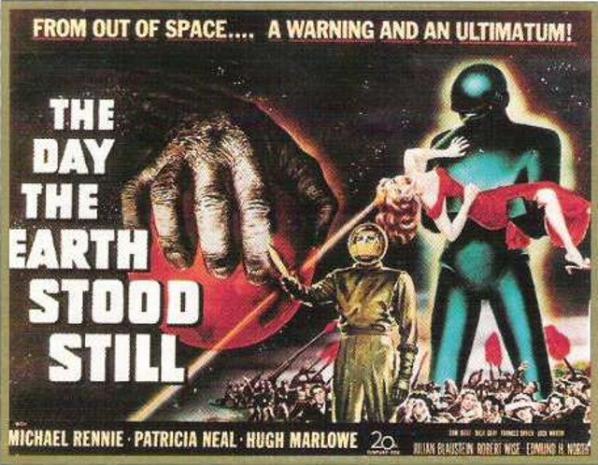
Territorialization refers to the exertion of power along perimeters, or borders. Functionaries expressing the constriction of territory include customs agents, and border patrols; but are terminally expressed by the military wing of the nation state. This military is also generally pyramidally constructed in terms of Generals, Colonels, and other officers leading Battalions, Regiments and Divisions, which are organized as defenders of a nation’s sovereignty. These military organs are conversely best optimized to exert their power against either parallel or subordinate structures. Parallel structures include the armies of other nations, their Officers, et al, and their troops and ordnance that possess a similar organization. Conversely, subordinate structures over which military powers can exert power over are domestic masses that can be overrun with overwhelming power, although these forces are more specialized (such as National Guards or Gendarmeries). In the conventional sense, power is expressed orthogonally, whether it is against equal or subordinate forces.
Another aspect of this conversation relates to the expression of power/force through conflict and violence, but has its inconsistencies The examples I will use from American pop culture I will use in this missive to explain amorphous action may be violent in nature, but the violent nature of these examples do not relate to the paradigmatic jamming of conventional power. Their citation is related more to the fact of conventional power’s orthogony, or parallelism of exertion of power to similar structures or dominance of the subordinate, and the panic state it experiences when confronted with non-conventional difference or passive resistance. We could express the power relationships between amorphous politics and conventional power in terms of a tetrad in terms of examples of violent and peaceful exertion of amorphous dissent as well as orthogonal conflict. We could cite the Occupy movement as a site of passive, and the Tunisian uprising as violent exemplars of amorphous conflict or dissent. Conversely, the Gandhi/King is a non-violent model of as orthogonal/hierarchical/led action, and World War Two as conventional orthogonal conflict. What is important here is the inability of the conventional politics and power to cope with leaderless, non-hierarchical, non-orthogonal discourse that refuses to talk in like terms such as centralization, leadership and conventional negotiations that include concepts such as “demands”. This is where the site of cognitive dissonance erupts, often resulting in a panic state or in the “figureheading” of dispersed networks of power.
The need for the traditional power structure to focus identity on the antagonist in terms of figureheads is evident in the Middle East and Eurasia in the personification of terrorist and insurgent networks, but is more simply illustrated in the films Alien and Aliens, and Star Trek: The Next Generation. Both of these feature their respective antagonists, the “alien” as archetypal Other, and the Borg, symbol of autonomous, collective community. In Alien, the crew of the Nostromo encounters an alien derelict ship that has been mysteriously disabled to find a hive of eggs of alien creatures whose sole role is the creation of egg factories for further reproduction. At the onset of the franchise, pilot Ellen Ripley is positioned as the “everywoman” placed in the center of cataclysmic events. In the Alan Dean Foster book adaptation, and an extended edit of the Scott film, Ripley finds during her escape from the ship that Captain Dallas has been captured and organically transformed into a half-human egg-layer whom she immolates with a flamethrower. However, in the Aliens sequel, the amorphous society of the self-replicating aliens has been replaced by a centralized hive, dominated by a gigantic Queen that threatens to impregnate the daughter-surrogate Newt. This transformation from a faceless to centralized threat creates a figurehead for the threat and establishes a clear protagonist/antagonist relationship, and establishes traditional orthogony.
This simplification of dialectic of asymmetrical politics is also evidenced in Star Trek: The Next Generation by the coming of the Borg, a collective race of cybernetic individuals. Although representations of the Borg vary as to fictional timeline, in televised media they began as a faceless hive-mind, which abducted Captain Jean-Luc Picard as a mouthpiece, not as a leader. It was inferred that if one sliced off or destroyed a percentage of a Borg ship, you did not disable it; you merely had the percentage left coming at you just as fast. However, by the movie First Contact, the Borg now possesses a hierarchical command structure to their network and, more importantly, a queen. With the assimilated and reclaimed android Lieutenant Data, the crew of the Enterprise infiltrates higher level functions of the Borg Collective, effectively shutting down the subordinate elements of the Hive. In addition, the Queen/Leader is defeated, assuring traditional figurehead/hierarchy power relations rather than having to deal with the problems of the amorphous, autonomous mass. There are other “amorphous” metaphors in cinema that address the issue of amorphousness. These include the 1958 movie, The Blob, in which a giant amoeba attacks a small town and grows as it engulfs everything. Another is The Thing, about a parasitic alien that doppelgangs its victims, creating another form of faceless threat. Lastly, we have the classic Invasion of the Body Snatchers where alien plant “pods” would bear fruit of duplicates of living people, giving a metaphor for the Communist threat of the Red Scare originating during the Cold War. Perhaps these are historical references to mediated expressions of anxiety in regard to autonomy’s threats to regimented/striated hegemony, stating that this sort of anxiety and terror are not new.
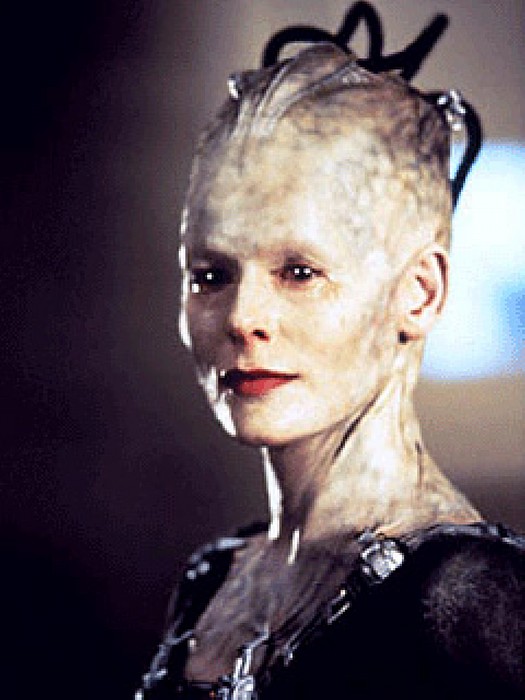
One of the most asymmetric cultural Western interventions in relation to constructs of traditional power is the involvement of Anonymous as part of the Occupy Movement. Anonymous, which has been called a “hacker group” in the mass media, is a taxonomy created on the online image sharing community 4chan.org, arising from the practice of posting “anonymously” unless one wants to use a name, or handle. Although the idea of Anonymous is at best an ad hoc grouping, the use of the “group” name has been ascribed to various factions. According to The State News, “Anonymous has no leader or controlling party and relies on the collective power of its individual participants acting in such a way that the net effect benefits the group.“ The idea of Anonymous fits with the “faceless collectives” mentioned above, and certainly presents an asymmetric, if not non-orthogonal, exercise of power. Anonymous first rose as a voice of dissent that emerged against the Church of Scientology (see Project Chanology), where flash mobs of individuals in Guy Fawkes masks and suits arrived to protest at sites around the world, with boom boxes playing “The Fresh Prince of BelAir”, a popular agitational or “trolling” anthem. It has engaged in other activities, including hacking credit card infrastructures opposed to handling donations to Wikileaks and creating media around Occupy Wall Street. However, without a clear infrastructure and only transient figureheads, Anonymous functions as an organizing frame for a cloud of individuals interested in various collective actions, and represents an indefinite politics based on networked culture. In an expected exercise of force, during the actions against elements opposed to Wikileaks, conventional power struck back wherever it could against members of Anonymous, by arresting over 21, some violently, in July during the actions against credit providers boycotting Wikileaks. This exercise of power was repeated in September, with admonitions about the arrests appearing on YouTube thereafter. Anonymous has also posted videos in support of the Occupy movement. Such a response is not surprising, but is the exact response to non-orthogonal dissent under our model. The problem is that in arresting any number of Anonymous members, traditional power is confronted with the first, distributed model of the Borg that merely exists minus two or twenty members.
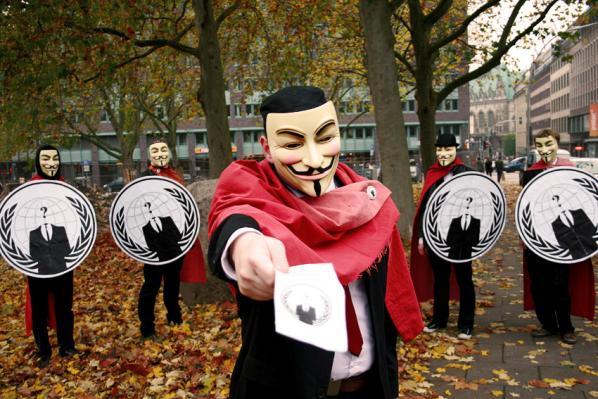
Another dissonance between the Occupy Movement and conventional politics is the perceived lack of agenda. This is due to its dispersion of discourse in giving its constituents collective importance in voice. What is the agenda of the disempowered 99% of Americans, or world citizens marginalized by global concentration of wealth? Simply put, the agenda is for the disempowered to be heard. What does that mean? It means anything from forgiveness of student loans to jobs to redistribution of wealth to affordable health care, and so on. It isn’t a list; it is a call to systemic change of the means of production, distribution of wealth and empowerment in political discourse. It isn’t as simple as “We want a 5% cut in taxes for those making under $30,000.” It’s more akin to “We’re tired that there are so many sick, hungry, poor and uneducated, and we want it to end. Let’s figure it out.” It is the invitation to the beginning of a conversation that has no simple answers other than the very alteration of a paradigm of disparity that has arisen over the past 40 years through American capitalism.
The last challenge to the traditional power discourse is that of passive resistance. This is not a new strategy, especially under the aegis of Gandhi and King’s movements. However, it is traditional power’s mere tolerance of nonviolent resistance that does not result in violence. As we can see from the UC Davis assaults and the dispersions after the second month anniversary, conventional power exerts its force against, as Brian Holmes put it, “anomalies” so that the system can be restored and the commodifiable classes are reintegrated into the system to reproduce its agendas. As long as resistance does not present undue inconvenience for the circulation of power and capital, it is allowed. Once it loses its patience with non-orthogonal forces, or if materially sacralized spaces, like Wall Street are threatened, the hegemonic order is reified. The irony of the technical loophole of Zucotti Park being privately owned and having few rules allowed the Occupy movement also highlights the tenuousness of public discourse in Millennial America. However, even with this oddity, on the two-month anniversary of Occupy Wall Street, force has begun to be used against the occupiers as traditional power’s patience grows thin with amorphous politics. In the streets, the marches are split up, and rules about occupation begin to be enforced with cupidity. As said before, hegemonic patience has worn thin, with assaults/dispersions taking place in Oakland, Davis, Philadelphia, and New York, among others. However, the movement moves forward for the moment.
Amorphous politics is based on plurality, collectivism, dispersion and ideas. The hierarchical nation-state has no idea what to do with the amorphous blob as it grows except to try to contain it, but as with Anonymous, it is a whack-a-mole game. If one smacks down one protest, two pop up across town, or five websites pop up on the Net. Shut down Wikileaks, and a thousand mirror sites show up. People in the streets swarm New York and other cities throughout the US, and the world, and conflict arises. Asymmetry and amorphousness are dissonances to traditional power. Ideas in themselves are not hierarchical.
Desires sometimes have no agendas.
Sometimes people want what is right, and all of it.
Dragana Zarevska and Jasna Dimitrovska are visual and performing artists, cultural workers and activists from Macedonia, who also, often work together under the artistic pseudonym Ephemerki. While at the same time loving and teasing the rigidity of academism, they like decoding magic, making it transparent, go behind Wizard of Oz’s curtain and put his pants down. The name of the duo is a funny derivate of Bapchorki (band of few grannies who used to sing Macedonian traditional songs in a rustic nasal style). It suggests that Ephemerki are their ephemeral version, or at least, the ones doing the ephemeral part of tradition. Their work is driven from and inspired by Donna Haraway, Judith Butler, Deleuze and Guattari, Agamben, and other contemporary thinkers and practitioners within arts, technology, society.
The Lele method is their latest performance (a performative event for a bunch of people, as they like to call it) and so far was performed at AKTO 6, Festival for Contemporary art in Bitola and Kondenz & Locomotion, Performing arts festivals organized in Skopje and Belgrade. Here is the story behind the project.
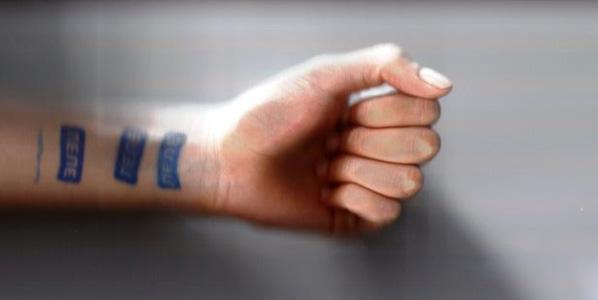
Darko Aleksovski: ‘Lele’ (Мac: леле) is a word that has profound significance in the Macedonian language. It is a universal word that can be used in different contexts and can imply several different emotional states. Can you describe what was the inspiration for this project dedicated to the word ‘lele’? What is the subjective meaning of this word for you?
Dragana Zarevska/ Jasna Dimitrovska: The particular situations this word implies and the problems it addresses might sound quite confusing for the non-Macedonian readers, but, if any of them have visited, or will visit our country, it’ll be deadly surprising how many “leles” per minute one hears around. The word “lele” is totally devoid of meaning, but it is being used to emphasize certain emotions, wondering, shock, great happiness and similar. It is just a shout out, like…the French “oh-la-la” for instance, the Bulgarian “ma-leeeh” or like the Serbian “yoooooy”. The project is being titled “The Lele Method”, directly and totally driven from the local obsession with lele and its possible application.
For us, this word sometimes depicts the shortly shaken numbness and the apathy of our current socio-political constellations, but only with a shout, and then again – everything goes on as usual.
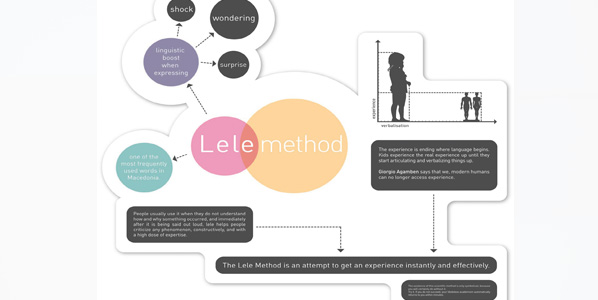
Darko Aleksovski: What is the ‘lele method’? Considering the performative act of the ‘lele’ word, and its everyday use in Macedonian speech, do you think that a method like this can still function as relevant? Can the ‘lele method’ be appropriated by anyone, or it is just a method that you as an artist use?
Dragana Zarevska/ Jasna Dimitrovska: Sure. It can be appropriated by anyone, but it is still a joke. You will certainly do without it as a method. Using it will not bring anything to your life what you’ve not had before. This is how we define it: Lele is one of the most frequently used words in Macedonia… people usually use it when they do not understand how and why something occurred, and immediately after it is being said out loud, Lele helps people criticize any phenomenon, constructively, and with a high dose of expertise. Try it. If you do not succeed, your libidoless academism automatically returns to you within minutes.
These instructions can help a lot in experiencing this useless experience through this useless method. But, stating the obvious with The Lele Method is what we enjoy the most. We give people what they already have, like selling snow to Eskimos.
Recently, in an interview we gave for the Canadian .dpi Magazine we discussed some particular effects we achieved by performing Lele. Nobody is aware of performing it daily here in Macedonia, and while we were preparing the performance out of it/about it, we realized the power of defamiliarization. You perform something which is being performed daily in a constant automatization. By naming a method Lele and putting it on a stamp, we gave the word a particular relevance and a different form. We made it “unfamiliar” and “difficult”, and by that, we prolonged the process of perception of that word. By trying to remove the automatism of perception, we got a new perspective of a word, of a problem. This technique has been used in the literary criticism of Russian formalism to differentiate prose from poetry, but we use it to differentiate and to delay perception. As Russian formalist critic Viktor Borisovich Shklovski has said in his well-known essay “Art as Device,” – the purpose of art is to impart the sensation of things as they are perceived and not as they are known.
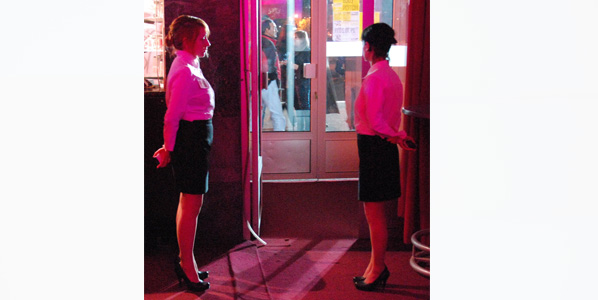
Darko Aleksovski: You have presented this project two times so far – as a performance accompanied by the printed version of the scheme of the ‘lele method’. How much performance is a necessary medium for this project?
Dragana Zarevska/ Jasna Dimitrovska: We’ve shown the performance at this year’s Akto Festival for Contemporary Art during August (Bitola/Macedonia), and at the Kondenz & Locomotion curatorially joint festivals for performing arts organized in Skopje and Belgrade during October. We must admit we entertain ourselves a lot during the performance because people enter the room and they perceive it as some irrelevant and boring employees who put a stamp on everyone’s hand at the venue’s door. Then, they look at the stamped hand/arm and shout “Leeeeeh-leeeeeh!” because that’s being engraved on our stamps.
During the performance we are dressed in our Lele uniforms which are extremely office-like and conservative, our faces are shit-serious, and inside the room there are printed materials (scattered leaflets on the tables, or printed panels on the wall) with diagrams on them explaining the empirical part of the Lele Method. The concept behind the Lele Method is being driven by our love and respect towards Giorgio Agamben’s work and his ideas on experience shown in his work Infancy and History. The experience is ending where language begins. Kids have the real experience until they start articulating and verbalizing things up. Giorgio Agamben says that we, modern humans can no longer access experience. The Lele Method is an attempt to get an experience instantly and effectively. The existence of this scientific method is only symbolic, because it is just mocking the academia and the naive ones simultaneously, as – all of the work we did/do by far.
Much of this performance auto-perpetuated, it is happening by itself. Performance is always a necessity. It is better for us to be aware of it, because we all perform all the time. This performance is all about being aware that we perform something of which we usually forget, but is actually performable – something automatized like the word Lele.
Darko Aleksovski: The project was very well received by the audience, other artists and critics. Does it have another aspect of it, that is directed as a critique towards the whole Macedonian art system?
Dragana Zarevska/ Jasna Dimitrovska: Thank you for this notion. Actually it was fantastic how great it was received. Our work can often be seen as an overlap between theory, movement, process and production. The contextualization of these things shapes the performative events we present that test and deconstruct different versions of reality and its geography, directly related to awareness of the possibilities of language. We criticize language/es through language.
Darko Aleksovski: Do you see ‘lele’ differently, now that you have made a project out of it?
Dragana Zarevska/ Jasna Dimitrovska: Yes we do. We got de-familiarized with it (by getting hiper-familiarized), while, at the same time we started to think of it as of our own word, which is pretty selfish. We totally “adopted” it. Other people who came to our performances also tell us they experience it a bit differently than before, one friend said “Whenever I say Lele I think of you!”. We know this might sound weird and vain, but it seems we assimilated it as our own piece of art, and the truth is – it is so not ours, it is everyone’s. We surely assimilated the illusion of having it as ours though.
more about the artists: zarevska [at] gmail.com, yasna.dimitrovska [at] gmail.com
Darko Aleksovski interviews artist Toni Dimitrov about his work ‘Total surveillance’ featured in the group exhibition SEAFair ’11 ‘Energy, Biopolitics, Resistance strategies and Cultural subversion’. Curated by Melentie Pandilovski, Elena Veljanovska, Zoran Petrovski, ending on the 20th November at the Skopje Museum of Contemporary Art, SEECAN (South East European Contemporary Art Network) and Kontejner, Zagreb. SEAFair 2011 contextualises the artistic and theoretical discourses developing around Bio-politics, aiming at re-evaluating its meaning today, as well as address the possibilities for resisting the dominant international discourses through emancipation and cultural subversion.
Darko Aleksovski: Inspiration is a term which has been differently interpreted throughout the history of art, but generally implies the genealogy of the idea. What was the main inspiration for a project like this? Can you tell us about your references (other similar projects, theory, philosophy, etc)?
Toni Dimitrov: Throughout the twentieth century, art changed its forms of representation. Representation through painting, making objects and visual contemplation, and prior to all – the mimesis – artists changed them with new ways of representation which more and more directly respond and represent the changes in the society, emphasising process, concept, action, interaction, new media, technology, surroundings and of course, the critical discourse… The thing that challenged, and still challenges me to express is the critical discourse and the resignation which is a result of the systematised life and the limitations of the system. It is that primordial anger which one feels at the moment of gaining awareness, when we actually realise where and how we live. Everything that is presented to us as a system that aims to ease our life, is not actually quite so. Take for instance, science and technology, and their goal to “work” for the benefit of humanity. It is not just that they do not seem to make life easier, but on the contrary their usage is harmful for humanity. Exactly from the moment when the greatest hopes were given to technology, science and the great theories, they seem to have failed to fulfill the expectations. Instead of being tools for achieving the ideals of humanity and attaining prosperity, they are becoming the most powerful tools of the system for establishing new forms of power and domination. That same indignation generated from this cognition is my greatest inspiration, from my first critical artwork, through to some other art project, different philosophical essays, and until now.
As inspiration from philosophy, primarily I can mention Baudrillard and Virilio, who precisely vivisect contemporary reality. Then my greatest interest for the utopians and anti-utopians from More and Campanella, who criticise the system at the moment by offering a solution, and all the way to Orwell, Zamyatin and, of course, Huxley, who gives the most precise image of the society we live in – benevolent totalitarianism. I also need to mention the Frankfurt School through From, Horkheimer, Adorno and of course Markuse and other contemporary scholars like Zygmunt Bauman, Ulrich Beck, Frank Furedi, Lars Svendsen…

Darko Aleksovski: To which extent digital media is important for you as an artist? Do you regard the digital artworks to be carriers of more information in a present day digital surplus, or you think that art necessary expresses through digital media because it is the prevalent media in today’s life? How much is the ready-made aspect of this project necessary?
Toni Dimitrov: Digital art affirms all these social changes and at the same time offers a departure from them, leaving different questions from different areas in the center of the discussion. Unambiguously, digital art develops wider contexts and penetrates in other different fields like philosophy, physics, linguistics, semiotics, politics, sociology, even biology. When you visit an exhibition like this, you no more have the feeling that you are at an exhibition where you should experience something beautiful, but you feel like being in a lab where something new is created, something unacceptable even for science itself. Ethic rules and scientific methods have no significance here. Some of those works went too far and by looking at them, you are likely to feel disgust or resignation, feelings that are important for expressing the critical dimension and gaining awareness.
Concerning the ready-made aspect of the digital art, we have to agree with Walter Benjamin, who considers that through making reproductions, the unique experience is replaced by many others and the replication contributes to the loss of the aura of the artwork, with the fact that the artwork through the process of distribution, is not so original, unrepeatable, unique, but can be reproduced and replicated. Simply, the uniqueness of the original is transformed in infiniteness or many others. That is one of the main critical perspectives addressed towards the art that originates after the mechanical reproduction and the development of arts such as film, photography, printmaking, and today we can include a wide variety of digital arts, where practically the original is not present. Here art loses its uniqueness, or aura to be more precise, but receives the “readiness” of the ready-made aspect.
Besides this critique with which I agree, I still think that art/music are created today to be seen/heard today, and not after ten years when they will be a part of the history. This means that art today is created with digital tools and digital media, equally as electronic music is created. In my opinion one should be current and to express through momentary assets, in order to express and present the new social and critical streams more precisely. On the other hand, this does not mean that we should not use classical media in a contemporary way and that I do not draw, or even make a mosaic, but still “officially” I use digital media and conceptual art to express myself and to address a critique.

Darko Aleksovski: Do you consider your project as a critique towards the social apparatus and the instrumentalised life, or towards the inert subject, instructed to accept ready-made social situations?
Toni Dimitrov: Of course the critique is directly addressed to the society and the system. Society is the one who possesses the monopole of power and imposes these aspects of subtle, total control. However, the subject itself is not spared from the critique, precisely because of his inertness, because he does not react against this imposition, but unconditionally accepts it under the vague excuses that all of it is for “his own good”, for his security, protection, etc. Still this imposition is generated by the system, through the upbringing, educating and modeling of the subject itself, so it is more than obvious who is to blame for this condition.
“Total surveillance” addresses the critique towards one of the most explicit “benefits” of contemporary society, which is so much present in our everyday life, that we do not even notice it. The project refers to the anti-utopian dimensions society gets in today’s context. The exposure to constant surveillance is the subject of the anti-utopian works, which precisely anticipate the consequences of irregular use of technology, and the philosophical dimension of which totally corresponds with our present.
It is in these points that we see the postmodern analysis of institutions and discourses of modern art and the ways in which they normalise and discipline the subjects, analyses of the new communication technology, mass-media and their mechanisms of establishing power and domination… We see a critique directly addressed towards today’s modern forms of power which establish new forms of domination. The critique towards information and communication technologies that contribute to the development of human capacities, decomposition of the centralised structure and concentration of power, democratisation of culture… as much as they contribute to the depersonalisation of individuals and manipulation of people.
The realisation of this progress is a vision of the anti-utopia made real, realisation for which time is becoming increasingly shorter. Today we see that, the anti-utopian predictions for the negative consequences of technological and social development are realised with surgeon’s precision, in all of its wide variety, realised through social restrictions, concentration of power, social insecurity, depersonalisation of the individual, destroying of the emotions, control via mass media, mass production, instant entertainment… All these are described and anticipated by the smallest detail, in the works of the anti-utopians years before they became reality.

Darko Aleksovski: Do you see art as the most relevant way for critical actions?
Toni Dimitrov: No. Art is just one, maybe the most banal, but still most receptive way of critical action which will not leave many traces in reality. Art is a paradigm which represents things in a symbolic way. That does not mean that art is insignificant and that there are not examples of art and its critique generating a change or at least raising awareness of some issues, but still it is an accompanying method for addressing direct critique. Theory/ philosophy MUST be inevitable part of the art through which it gets the crucial point for a direct critique and eventually initiating changes. Art without theoretical basis is nearly empty art.

Darko Aleksovski: Your project is a vicious circle copy of the surveillance cameras. To which extent this artistic situation is a replica of the real one, or you consider the real situation to be even worse? How much you think engaged and critical art are perceived nowadays, considering the dispersed art system?
Toni Dimitrov: Unfortunately too true a copy of reality. When you enter the exhibition room, you practically enter a real situation, i.e. you exit in the social reality. This is practically a copy of the social system which we live in. In that case there is no need for gradation of better or worse situation. Go out on the street, pass by the surveillance cameras and feel it. There were mixed reactions when visitors entered the exhibition room, most of them were real, expressed with unpleasant feeling and disgust when they realise they are uncoated and observed from every side. It is the very same thing that happens in every institution and outside on the streets, but we are unaware of who is observing us. That is the feeling I conveyed here; the feeling when you see the results of the observation. It is a precise reflection of the anti-utopian character of our society which develops in this direction mediated by technology.
On the other hand the technological revolution that happened in the last fifty years and the IT revolution created in the digital age, also created fundamental changes in society and the way it functions, even in the physical space. For Virilio, even reality is divided or more accurately it is substituted with another – a virtual one that becomes more powerful mediated by the new technologies. That is why the essay that goes along with the installation begins with a quote by Virilio: One day the virtual world might overwhelm over the real world. This is that same virtual reality in which monitors you look at your existence. It is Virilio that warned us that almost every critique toward the technology disappeared and that we unconsciously accept every innovation without critical view on its consequences, by which we slip in the dogmatism of totalitarian techno-culture. All of this is criticising the way technology changes the contemporary world and human himself, recognising a key factor in technology that determines the modern world.
Finally “Total surveillance” represents a kind of video installation or a network/structure composed of video cameras, video projectors and screens which mutually intersect and constantly record the object/viewer in front of them, from every angle. The viewer, with his/her presence is a participator and part of it at the same time. The cameras record his presence from all four sides, and the viewer is capable of watching the recordings on the screen in front of him i.e. to watch himself. It is about the total surveillance of the viewer, but one in which the viewer is under surveillance by himself from every side and perspectives which are usually invisible for him. In the surveillance, other viewers in the room are also included, by watching themselves, or by watching other viewers. With this, you get a network of crossed cameras and projectors which project images of the viewer from every side, fill the whole room and complement it with the visual noise of the space. This replication and reproduction creates a projection of the viewer in the screens, outside himself, in a sort of virtual world, which continues to infinity, similar to a mirror projected in another mirror, gaining new and new aesthetical forms, a product of the replication and reproduction of themselves.
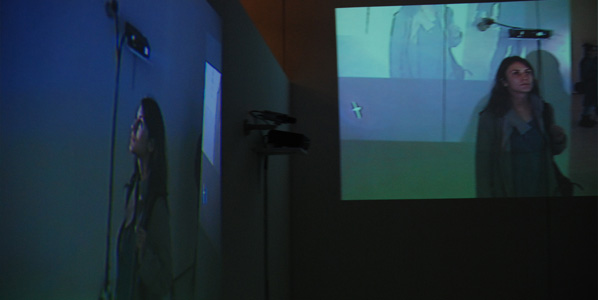
More information about the project and the artist: tonidimitrov [at] gmail.com
All images by Ilija Madzarovski.
On 28th October 2011, I travelled to Sète in the South of France to see and review Annie Abrahams’ show Training for a Better World.
The first of two reviews (the second will be somewhat longer and in an academic journal later this year) is now available on DVblog.
What was particularly pleasing about going to the press view and then staying on for the opening proper was the opportunity to engage with the work over quite a long period – some four hours.
About halfway through the evening, I started both photographing and sketching as aides-memoire for my reviews, but I soon began to enjoy the feeling of responding to the work for its own sake, and I began to think about presenting the drawings and photographs (plus some drawings made from the photos two days later, as well as a couple of manipulated photos) as a kind of photo-essay/derivative work.
The Transborder Immigrant Tool (TBT) is a project created by the University of California at San Diego’s Electronic Disturbance Theater (EDT) 2.0/b.a.n.g. lab, and still evolving today. Here Ricardo Dominguez, co-founder of EDT (with Brett Stalbaum), Principal Investigator of b.a.n.g. lab, and Associate Professor in the Visual Arts Department at UCSD, discusses the project with Lawrence Bird. The interview includes input from other members of the collective: Brett Stalbaum, Micha Cardenas, Amy Sara Carroll and Elle Mehrmand.
Lawrence Bird: Simply put, the Transborder Immigrant Tool is a hand-held device to aid crossers of the Mexico-US border. As far as the cultural and political implications of this device, it’s loaded. But as a starting point, could you tell us a little bit about the technical side of the device?
Ricardo Dominguez: We began with the basic question: what ubiquitous technology would allow us to create an inexpensive tool to support the finding of water caches left in the Southern California desert by NGO’s? Our answer was that the sub-$20 iMotorola phone series could be made useful for emergency navigation. The early generation of the platform we targeted can be made reasonably useful in a better-than-nothing scenario. Meanwhile, later phone generations (that don’t yet cross our price barrier but are getting closer everyday) are already fully useful as practical aids without even a SIM card installed or an available network service. With proper use, the GPS performance of newer phones equals any GPS designed for desert navigation, and their used prices are falling. Moreover, GPS itself does not require service and has free global coverage, courtesy of the United States government. In an emergency scenario, we trust these later mobiles to direct a lost person to a nearby safety site. The TBT’s code is also available on-line to download at walkingtools.net, sans water cache locations, for any individual or community to use for their GPS investigations.

Lawrence Bird: It’s an interesting instance of technology intersecting with geography. You have referred to Donna Haraway’s work in your own comments on the intersection between “border crossing” and other forms of “trans”-being. Would it be accurate to see the TBT as a cyborg component; and if so, what does this mean for the relationship between technology, politics and poetics?
Ricardo Dominguez: Part of the TBT project is to call into question the northern cone’s imaginary about who has priority and control of who can become a cyborg or “trans” human – and immigrants are always presented as less-than-human and certainly not part of a community which is establishing and inventing new forms of life. When in fact these flowing in-between immigrant communities are a deep part of the current condition that Haraway’s research has been pointing towards – for us it is a queer turn in its emergence, both as unexpected and as desire. The investigation of queer technology and what this queering effect has been or might be is an important part of our conversations – especially via Micha Cardenas’ research. This gesture dislocates the techno-political effect with aesthetic affects that become something other than code: a performative matrix that fractalizes and reverses the disorder of things with excessive transbodies acting from the inside-out of those enforced borderless borders. These affects assemble new empirico-tran(s)cendental forms of multi-presence(s) incommensurable with the capitalist socius of the so called “immaterial” Empire. As the Zapatistas say, “we do not move at the speed of technology, but at the speed of dreams” – the heart of the trans-border-borg.
Lawrence Bird: As you say, that –borg is spatial. Do you do any work with professionals of space design – for example, you have mentioned elsewhere the architect Teddy Cruz, who’s done design projects and spatial analyses focused on the Mexico-US border, especially urban borders?
Ricardo Dominguez: We have not worked directly with any urban space designers, such as Teddy Cruz, who teaches here at the Visual Arts Department at UCSD as well – but we have learned a great deal about the nature of the border-as-design and auto-assemblage – especially from the Political Equator gatherings that he has been at the forefront in creating. But recently we were invited to create a gesture for Political Equator 3 that we really enjoyed and offered a poetic materialization of bringing TBT into Mexico: at 12:30 p.m on June 4th, 2011 the Transborder Immigrant Tool was walked into Tijuana, Mexico via an aquaduct from the U.S. side of the border by artist Marlène Ramírez-Cancio (a video of this event is embedded above).
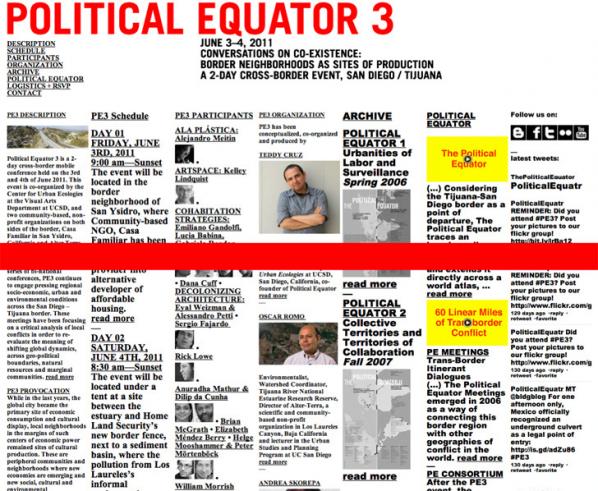
Lawrence Bird: Does any of this work intersect with American fear over border permeability to terrorism? The criticisms of TBT seem to focus on economic migration but the reaction bleeds into fears over security.
Ricardo Dominguez: TBT does crisscross a number of these types of affective conditions that have been floating around the border since 9/11; or one might push it back to early formations of the Mexico/U.S. border. And yes, it intersects with the growing state of fear in the U.S. (and around the world) about immigrants dismantling the U.S. economy – which has always struck me as extremely ironic – since as we have encountered in these past couple of decades, neo-liberal economics on a global scale have done much more to dissolve the romance of the nation via a series of self-made economic bombs than any immigrant “invasion.”
Lawrence Bird: In fact your development of this tool has come at a significant personal cost. You’ve been accused of supporting illegal activity and misuse of public funds. You’ve been called a traitor. Your position at UCSD was threatened. Could you talk about that and where this situation stands today?
Ricardo Dominguez: The entire group of artists who are part of Electronic Disturbance Theater 2.0/b.a.n.g. lab working on the Transborder Immigrant Tool (TBT) was being investigated by UCSD and 3 Republican Congressmen starting on January 11, 2010. Then I came under investigation for the virtual sit-in performance (which joined communities statewide against the rising students fees in the UC system and the dismantling of educational support for K–12 across California) against the UC Office of the President (UCOP) on March 4, 2010. This was then followed by an investigation by the FBI Office of Cybercrimes. So, it was three investigations in total— and they were all seeking to find a way to stop TBT and threaten to de-tenure me for doing the very work I was hired to do and then tenured for. In the end all the investigations were dropped. I did agree not to do another virtual sit-in performance on the UCOP for four years, but the day I signed the agreement, a number of supporters across the nation did a virtual sit-in on UCOP again. One strange element about the agreement that they wanted me to sign without even giving me or my legal team time to look it over was that I would never speak or write about what had happened, create any artwork that might disturb anyone and refrain from an artivist performances. Of course I agreed to none of it.
Lawrence Bird: The vitriol in the attacks on you is remarkable, and disturbing: you received a great deal of hate mail and a number of death threats because of this project. You mention in your play Sustenance (published in Artists & Activists 12) that these messages “constellate into remarkable patterns”, form a chart as it were of the agitated contemporary discourse over immigration, security, and national purity vs. liberty. It’s significant that you’ve built a play around this. Do you see the political and popular response to your project (you refer to it as “viral reportage”) as part of the TBT’s performative aspect?
Ricardo Dominguez: Part of the history of the Electronic Disturbance Theater 1.0/2.0 and b.a.n.g. lab (stands for bits, atoms, neurons and genes) at CALIT2/UCSD has been to develop works that can create a performative matrix that activate and take a measure of the current conditions and intensities of power/s, communities and their anxieties or resistances. So, for us the U.S. Department of Defense launching “info-weapons” at us for a virtual sit-in on September 9th, 1998 or the current confluence of “viral reportage” and the affective contagion of hate about the project that followed are all part of the performance – of course we would much rather the hate-mail never occurred – dominant media is bad enough to deal with. The aesthetics of working in the zones of post-contemporary artivist gestures cannot really escape these types of encounters; it is part and parcel of the patina of our work. But, we also feel that the hate mail or the general fear of losing national purity is co-equal in importance with the poetry that they were attacking. In fact Glenn Beck, an extreme right wing pundit on the Fox News Channel, attacked not only TBT’s use of poetry, but that the poetry itself had the power to “dissolve” the nation. The performative matrix of TBT allows viral reportage, hate-mail, GPS, poetry, the Mexico/U.S. border, immigrants, to encounter one another in a state of frisson – a frisson that seeks to ask what is sustenance under the sign of globalization-is-borderization.

Lawrence Bird: Can you tell us a little more about the poetry that accompanies the guidance system? How was this chosen, what does it concern? How do you envision the poetry developing as the project continues?
Ricardo Dominguez: Electronic Disturbance Theater 1.0/2.0 has always been invested in experimental poetry as part of its gestures – from the found poetry of the “404 file not found” of our ECD performances in 90’s to the border hack actions with the Zapatista Tribal Port Scan in 2000 on U.S. Border Patrol servers, where we would scan and upload Zapatista poems that we had written into their servers. When we started to develop TBT it became important once again to have a core impulse of the gesture. In 2008 I asked my partner, Amy Sara Carroll, who is an experimental poet and scholar, at University of Michigan, Ann Arbor – one of the areas of her research is on art and Mexican/U.S. border. She thought that TBT becoming a geo-poetic-system (gps) could expand the frame of experimental poetry and artivism. She then began to work with us and established two geo-poetic tracks – one conceptual and the other an echoing of desert survival manuals in multiple languages, which speaks to the multiple borders that are crisscrossing the planet and the multiple languages that are crossing Mexican/U.S. border via immigrants. Here is Amy speaking about TBT:
“…my collaboration with Electronic Disturbance Theatre (EDT) on the Transborder Immigrant Tool…(is) imagined as a global project under development, my own involvement in that ongoing process is linked to the question of what constitutes sustenance in the quotidian of the conceptual, on the varied musical scales of the micro- and macro-. For, often—rightly enough—conversations about crossing the Mexico-U.S. border refer to disorientation, sun exposure, lack of water. The Transborder Immigrant Tool attempts to address those vicissitudes, but also to remember that the aesthetic—freighted with the unbearable weight of ‘love’—too, sustains. A poetic gesture from its inception, the Transborder Immigrant Tool functions, via the aspirations of such a dislocative medium, as dislocative media, seeking to realize the possibilities of G.P.S. as both a ‘global positioning system’ and, what, in another context, Laura Borràs Castanyer and Juan B. Gutiérrez have termed, a ‘global poetic system.’ The Transborder Immigrant Tool includes poems for psychic consultation, spoken words of encouragement and welcome, which I am writing and co-designing in the mindset of Audre Lorde’s pronouncement that ‘poetry is not a luxury.’ … speaks to the Transborder Immigrant Tool’s overarching commitment to global citizenship. For, the excerpt, itself infused with the ‘transversal logic’ of the poetic, acts as one of the Transborder Immigrant Tool’s internal compasses, clarifying the ways and means by which I and my collaborators approach this project as ethically inflected, as transcending the local of (bi-)national politics, of borders and their policing.” http://bang.calit2.net/xborderblog/?tag=poetry
Here is a poem that made Glenn Beck extremely angry:
TRANSITION
(song of my cells)
Gloria Anzaldúa writes, “We have a tradition of migration, a tradition of long walks. Today we are witnessing la migración de los pueblos mexicanos, the return odyssey to the historical/mythological Aztlán” (1999 [1987]: 33). The historical? The mythological? Aztlán? It’s difficult to follow the soundings of that song. Today’s borders and circuits speak at “lower frequencies,” are “shot through with chips of Messianic time.” Might (O chondria!): imagine the chips’ transliteralization and you have “arrived” at the engines of a global positioning system—the transitivity of the Transborder Immigrant Tool. Too: when you outgrow that definition, look for the “trans-” of transcendental -isms, imperfect as overwound pocketwatches, “off”-beat as subliminalities (alternate forms of energy which exceed Reason’s predetermined star maps). Pointedly past Walden-pondering, el otro lado de flâneur-floundering—draw a circle, now “irse por la tangente”—neither gray nor grey (nor black-and-white). Arco-iris: flight, a fight. Of fancy. This Bridge Called my Back, my heart, my head, my cock, my cunt, my tunnel. Vision: You. Are. Crossing. Into. Me.
Here is a beautiful video version that Micha Cardenas and Elle Mehrmand did of the poem: http://bang.calit2.net/xborderblog/?p=49
In the strongest possible sense poetic practice has emerged in TBT that is co-equal with Brett Stalbaum’s idea of a “last mile” tool and his development of the code necessary to have it work. In fact we also think of the code-as-poetry as well – an expansion of codeswitching – literally.
Here is one of the desert survival poems:
En última instancia, muchos dirán que
la naturaleza establece el estándar de
la neutralidad. A diferencia de los seres
humanos, la naturaleza no hace lazos
de lealtad con la nación, la familia, los
negocios o la religión. Usted sabe bien
que el mayor peligro que enfrentará en el
desierto puede no ser el clima o el terreno.
Habrá quienes no tengan en consideración
su bienestar. Los rescatistas tienen el
compromiso de ayudar a quien lo necesite;
exíjales cumplir esa promesa. No confíe su
vida a nadie más, a ningún extraño.
All them are available in multiple languages to the user on TBT.

Lawrence Bird: How do you navigate the legal issues? Did you have a strategy in place ahead of time for dealing with these, or have you had to deal with them ad-hoc? Does your strategy/defense link up at any level with that of apprehended border-crossers?
Ricardo Dominguez: We are not attempting to navigate “legal” (national or international) issues – but we are trying to establish a reconfiguration of the border and immigration in terms of what we are calling transborder justice – the question of a “higher law” doctrine that David Henry Thoreau established in On Civil Disobedience. Also, in a more speculative manner as artists we see TBT as still in the process of becoming – it is still shape shifting and performing itself into potential spaces of use and poetics. TBT is border disturbance art that constitutes a visible geo-aesthetic/geo-ethics gesture against the boundaries and borderless borders that are crisscrossing every single body on the planet – we call for a geo-aesthetics that starts at the nanoscale and reaches to the GPS (Global Position System) grid system that floats around the planet, we call for a geo-aesthetics that connects both the human and the inhuman, geography and ethics, we call for a geo-aesthetics that crosses into and dislocates the smooth space of geo-spatial mobility with ethical objects for multiple forms of sustenance. We live in a world where only goods and services have rights to cross borders – a world that is a chaosmosis of markets that demand global exchange and aggressive state social filters. We need a geo-aesthetics that can construct ethical and performative complexities for the new earths to come, that can touch new geographies for new bodies – transbodies with transborder rights – artwork that can function as a geo-philosophy for bodies that are flowing as transborder bodies across all the borders the world – a flowing-trans-nation the planet cannot survive without.
Lawrence Bird: Have you considered applications of the TBT more globally, in Europe for example, or the Canada/US border, which has its own tensions relating to indigenous sovereignty? Or would this take it out of the specific politics you want to focus on?
Ricardo Dominguez: We imagine TBT’s code and gesture as open to use on multiple borders and that it is not bound to just the Mexico/U.S. border. One way that we have attempted to promote this possibility is by making the code available to anyone or any group at walkingtools.net.
Lawrence Bird: How extensively has your system been used on the Mexico/U.S. border? Or is it primarily rhetorical so far (it’s certainly been successful that way). How is it coordinated with others’ humanitarian efforts for border-crossers?
Ricardo Dominguez: On a very practical level our work with NGO’s has been focused on working with groups in Southern California who have established networks of water caches for immigrants crossing that area of the border – specifically Water Stations Inc. and Border Angels. Water Stations Inc., the longest running NGO working on this issue, has been very open to helping us test TBT and has also offered us extremely important insights into what the real conditions on the ground and what problems immigrants are facing. We recommend that if folks have funds to donate to these groups – please do. They were very wary of us at first – but they have now become much more supportive – especially because of the work that Brett Stalbaum and his partner, artist Paula Poole, have done in with them beyond TBT.
On the rhetorical end of the gesture much of the work that we do at b.a.n.g. lab is to start our research as a politics of rehearsal, a rehearsal of politics, as part of our art practice – to create an aesthetic of minor-signals and lower-frequencies…”like physics, aesthetics is a science whose primary object is signals, the physical materiality of signs….”– to quote from a recent tweet by Jussi Parikka. To manifest a type of science of the oppressed or engineering of the oppressed that imagines creating speculations that automatically, conceptually, begin to disturb not only the lines of thinking that criss-cross not only our bodies, but the ecologies of the Americas, and certainly the globe. And, so it becomes necessary to create these speculative disturbances that can allow one to think about another possibility, another impossibility, that these systems both manifest and, at the same time, call for an “anti-anti-utopian” potentiality, so that the engineering of the oppressed, the science of the oppressed, is about rehearsing the fictions that will then become realities. Our work in one sense is simply a gesture of “plagiarism”—a cutting and pasting of what is already an assemblage or a system that exists because immigrants are crossing multiple spaces around the world and GPS is everywhere in our cloudy global Empire. And so TBT itself is an attempt to create the multiple layers that manifest the social frictions, the speculative fictions, the rehearsal of politics, and of a counter-machine aesthetics—a machine of difference that can only really be performed by more than the multitude, if you will, to interrupt what Mary Pat Brady calls the U.S/Mexico border, “a state-sponsored aesthetic project.” We can see how these speculative gestures do create social responses on a global scale.
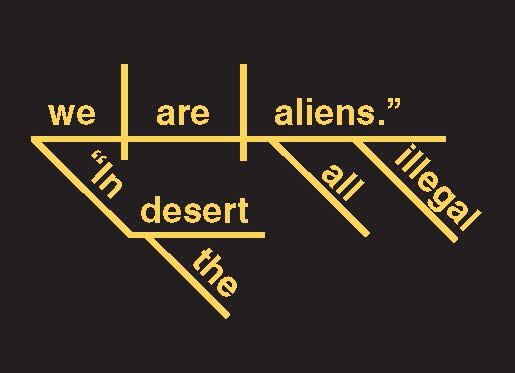
Lawrence Bird: TBT doesn’t just provide a map and way of locating oneself, it offers directions to various support services – where to find water, medical help. How are such safe sites managed and their position made public without making them vulnerable to border patrols? Are there any ethical issues involved here?
Ricardo Dominguez: The water cache sites are already well known by the U.S. Border Patrol, Homeland Security and anyone else who cares to take a trip along the Anza-Borrego desert in Southern California – in fact they have large flags signaling their locations. So TBT at this point is only doing one thing – offering the location of these known and established water caches – as a last-mile safety tool and nothing more. The cell phones we are using are not robust enough for anything else – now as more cheap high-end phones come on the market TBT will be able to offer more on multiple levels. So the ethical questions about TBT on the U.S. side of the border are not as complicated as those on the Mexico side of the border: these are questions about how TBT would interact with the coyote networks, would it be just one more material burden to those crossing, how does the extreme violence of the narco-war shut down the abilities of NGO’s etc., to work on distributing TBT with us – these questions seem much more important in terms of the ethics of the project – would it do more harm than good? Or is it a gesture that would offer a way out for some immigrants from the violence of these dangerous networks that they have to deal with in order to cross? At this point due to all last year’s issues we have not been able to formally present TBT to the immigrant communities preparing to cross to have a dialogue about these questions – but we are hoping to move forward with these encounters – sans any further investigations.
Lawrence Bird: And how has TBT been taken on the Mexican side – what is it’s perception on the part of Mexican citizens, politicians, media? I’m curious how their reaction compares to the response on the American side, which approached violence.
Ricardo Dominguez: It is difficult for us to access Mexico’s response to TBT in relation to coyote economies or the narco-war on the border – these are zones that we have not attempted to have conversations with or have correspondences with. But EDT 2.0 is concerned about how TBT might function within or alongside these violent enclosures that immigrants have to deal with on multiple levels. We do not want TBT to become an attractor for immigrants who are already targets for these groups. But what we can say is that Mexico’s dominant media and alter-media networks, from Tijuana to Chiapas, have been very responsive and supportive of TBT. One of the first awards TBT received was in 2007 from the new media arts festival Transito_MX, who awarded TBT the “trans-communities award,” and the award was handed to us by a representative of the U.S. Embassy in Mexico. So at this time the response to TBT is both unknown and known. Another concern that we have and that we hope to be able to have a better sense of by the end of the year is how the design works for immigrants, and to what degree do they consider it useful as an art work and “last mile” safety tool – this will be done via workshops with potential immigrants in Tijuana, Mexico. Also one of the core questions we will have, based on all the materials that immigrants leave in the desert while crossing – the heat and difficulty of crossing call for dropping as much away from the body as possible, from money, to telephone numbers, to pictures of loved ones, etc. – is one more thing to weigh one down really necessary? These are EDT 2.0’s concerns at this time in relation to the border on the Mexican side.
Lawrence Bird: You mention that what drives border crossers is a hope that amounts to a “hope for the unknown”? Could you elaborate on this? At any level do you see a contradiction between this and the technologies of transparency, like GPS?
Ricardo Dominguez: The radical gesture of transparency was extremely important to EDT 1.0 in relation to Electronic Civil Disobedience as theory and practice and it still is in relation to the general distribution of TBT – who were are, where we are, and why we are doing it. But we are also very interested in the notion of translucency as an aesthetic possibility for TBT that functions to dislocate the readability of GPS (Global Positioning System) and gps (a geo-poetic system) – a minor form of the technology that is no longer bound to the total vision of GPS that is now embedded in almost everything. This translucency functions as a single-bounce GPS that initiates the database of TBT and then shuts off – thus making triangulation impossible – unless the user decided to turn the function on during the crossing. TBT’s gps creates an aesthetic disturbance that dislocates GPS as a transparent device and instead offers a navigational translucency of the “last mile” with hope-as-sustenance as its guiding wave-point.
Lawrence Bird: In Sustenance you refer in passing to Baudrillard’s “desert of the Real”. It’s a compelling way of looking at the border desert where migrants are abandoned in their pursuit of the American fantasy. But adopting a perhaps more humanist attitude, would it be remiss to recall Saint-Exupéry’s words that “Ce qui embellit le desert…c’est qu’il cache un puits quelque part.” / “What makes a desert beautiful is that, somewhere, it hides a well.” Perhaps based on that juxtaposition, how would you place your project in relation to the tension between poetry, activist politics, and humanitarianism?
Ricardo Dominguez: TBT is still in a (gps) process of becoming – it is still shape-shifting and performing itself into potential spaces of use for activists and expanding the frame of dislocative poetics. TBT is border disturbance art that constitutes a waterwitching tool that indeed crosses the desert of the Real, the hard simulations of the border which seek to target and kill. It offers another possibility – with the anti-anti-utopian offer of the desert’s “beauty” that you are keying into the conversation. We imagine that this gesture echoes practices that fractalize the desert’s geo-aesthetics as: artivism, tactical poetries, hacktivism(s), new media theater, border disturbance art/technologies, augmented realities, speculative cartographies, queer technologies, transnational feminisms and code, digital Zapatismo, dislocative gps, intergalactic performances, [add your own______].

Face to facebook is the final project in a three part series named “Tha Hacking Monopolism Triology” by the two Italian artists Paolo Cirio and Alessandro Ludovico. It was launched on the 2nd February 2011, with a mixed media installation at the Transmediale festival in Berlin, and a press release announcing a new dating website called lovely-faces.com.
The set-up for the ‘Face to facebook’ project was to steal 1 million facebook profiles and re-contextualize them on a custom made dating website (lovely-faces.com). The data collected from the profiles was only information available publicly on the internet, like the users name and profile picture. No facebook account was needed to access it. The 1 million facebook profile pictures were then checked for images that were usable in a dating webstie context. The remaining 250,000 profile pictures were then fed through various face recognition filters to assign an assumed personality to the subjects and a new profile was created ready for the dating website. Once published on lovely-faces.com, interested pursuers could get in contact with the people behind the original facebook profiles through facebook messages.

On the 10th February, 8 days after its launch, the dating website lovely-faces.com was shut down. This was following a cease and decease letter from Facebook[1]. Back in 1999, the net artist Heath Bunting was also subject to a cease and decease letter, that time from American Express. The letter sent to Paolo Cirio and Alessandro Ludovico in 2011 (as PDF) can be seen here, and the letter sent to Heath Bunting in 1999 is published here.
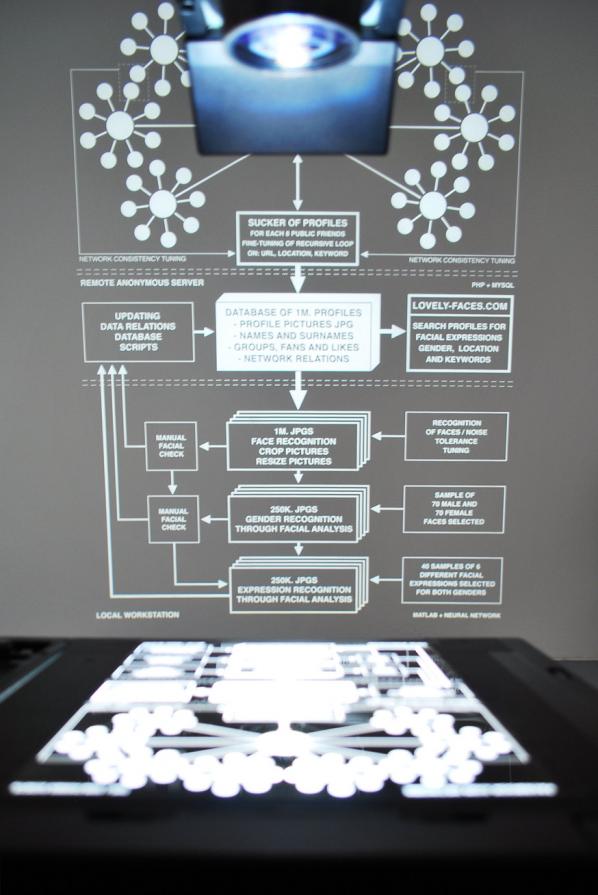
This project, and the ripples it left on the media water, highlights an ambiguous relationship many have with facebook. Many people sign up, upload a smiling profile picture of themselves and declare personal details to the large corporation that is Facebook without concern. Not until these identities and personal images were scavenged and then reused, the ownership and potential audience of this personal data is questioned. As the artists state themselves: “The final step is to be aware that almost everything posted online can have a different life if simply recontextualized. “
“The process is always illustrated in a diagram that shows the main directions and processes under which the software has been developed. We found a significant conceptual hole in all of these corporate systems and we used it to expose the fragility of their omnipotent commercial and marketing strategies. In fact all these corporations established a monopoly in their respective sectors (Google, search engine; Amazon, book selling; Facebook, social media), but despite that their self-protective strategies are not infallible. And we have been successful in demonstrating this.”
Web 2.0 Suicide machine (http://suicidemachine.org/) is another project which deals with your online identity. It allows you to automatically delete all your social network profiles and it simplifies the process – according to their website 8.5h quick then a manual deletion. Incidentially, the facebook is not one of the profiles subject to deletion in the suicide machine anymore, following another cease and decease letter: http://suicidemachine.org/download/Web_2.0_Suicide_Machine.pdf.
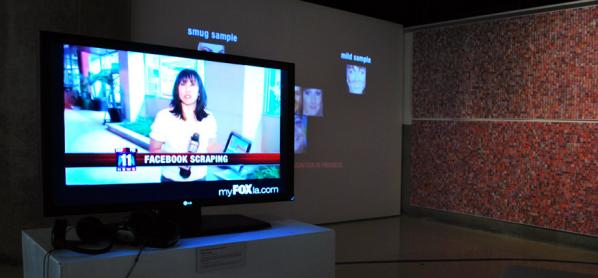
Since the lovely-faces.com dating website is still closed down, the project now (September 2011) consists of: documentation of the process used to acquire the facebook profiles; documentation of the global mass media hack performance, in the form of news broadcasts, magazine articles and blog post referring to the project; legal correspondence between the lawyers of the artists and Facebook; a mixed media installation; a touring lecture given by the authors. The latter two being re-performed and installed in various venues around Europe and beyond. The former are all available on the website face-to-facebook.net
The ever changing nature of this project therefore makes it a great example of a piece of contemporary art of variable nature, one which is in constant flux and is formed by the cultural, networked and physical landscape surrounding it. It does not only challenge the ownership of your online identity, it is also a nuisance for a mainstream contemporary art market based on institutional preservation and commercial commodification. These disruptions may also be linked. On the one hand there is an action to copy a system collecting and commodfying people and then use them as assets in one’s art expression and experience. “In all the three projects, the theft is not used to generate money at all, or for personal economic advantage, but only to twist the stolen data or knowledge against the respective corporations.” And then on the other hand, it is an art project which is not straightforward to see what the remaining artefacts actually are, whilst defying the process of being added to traditional art collections.
Other Info:
The Hacking Monopolism Trilogy. Face to Facebook is the third work in a series that began with Google Will Eat Itself and Amazon Noir. http://www.face-to-facebook.net/hacking-monopolism-trilogy.php
Elin Ahlberg is studying Art and Visual culture at the University of the West of England in Bristol. She has been living in the UK, and Bristol, since her move from Sweden in 2006. As an artist, she works in a variety of mediums and produces work which aims to both amuse and provoke. Her practice and research is informed by quasi-anthropological observations and an interest in technology. “One year ago I gave up Facebook for lent. It was quite an interesting experiment and I realised how integrated my life was with the social networking website as I actually felt that I missed out on things.” Ahlberg’s essay Meanings constructed around Facebook can be found here http://elinahlberg.wordpress.com/2011/07/18/essay-meanings-constructed-around-facebook-2011/
Emilie Giles interviews artist Mary Flanagan about Tiltfactor’s latest social game, Pox: Save the People. http://www.tiltfactor.org/pox
Emilie Giles: Can you give an introduction to POX: Save the People, and why Tiltfactor was keen to produce a game which explored issues around immunisation?
Mary Flanagan: POX: Save the People is a 1-4 player board game that takes on the public health issue of disease spread. We developed the game after wishing to pursue some public health issues and having prototypes games on cholera and HIV awareness at the lab. A local, and quite open, public health group called Mascoma Valley Health Initiative up in the New Hampshire region of the US approached us with the problem of the lack of immunization. At first, a game about getting people immunized seemed like one of the most “un-fun” concepts imaginable. But that sinking feeling of impossibility almost always leads to good ideas later, so I agreed to take the project on. We decided we could make something fun from the topic, and ruled out nothing, from crazed needles to taking the point of view of the disease whose main purpose in life is to spread around.
In our final version of the game, the board is modeled after a community, with the spaces representing people. The game begins with two people being infected with an unnamed disease, and the illness speads. Players try to contain the disease and save lives. There are vulnerable people among the population noted in yellow, and these people — pregnant women, young babies, and those in frail health — cannot be vaccinated.
EG: Schools have the option to download a sample lesson plan which incorporates the game into a science class. Please explain how you feel play can encourage learning in an educational environment.
MF: Play is one of the best ways to learn something — certainly tried and true classrooms such as Montessori method schools use play as a part of the curriculum. In the best scenario, play provides experiment space, where failure is ok. In games related to pedagogy, players can test the rules of the system at hand. POX players, for example, can try to cure all of the people on the board to test if this is a good strategy. They can test out best ways to avoid the spread of a disease. Ultimately, they get to make the meaningful choices from within the game rules. Playing POX while learning about real world diseases makes the phenomena more concrete, and gives the learner agency to think about what he or she might do to solve the problem.
The lesson plan for schools was edited by both trained teachers in US middle schools as well as doctors at Dartmouth’s medical school. Truly, then, the game is produced by a community. We could not have created the game to this level of quality without our partners, friends, and supporters.
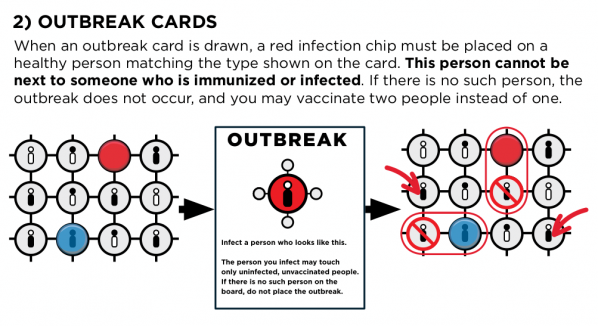
EG: In most games, a competitive element is introduced to result in a ‘winner’ and ‘loser’. POX deliberately avoids this convention, encouraging players to work together in order to stop the virus. Why was the game designed for this mode of play?
MF: One of the ethos of Tiltfactor games is cooperative play. We like to make games in which players can use collaborative strategy. We define collaborative strategy games as those in which:
1. Games (or in some situations, components of games) where if one player reaches the lose state, everyone playing also loses;
2. The extent to which players win is positively correlated to the success of other players.
Often the most interesting games do not fit comfortably into stereotypical models of play. And because we make games about less traditional topics — public health, layoffs, GMO crops, and other political and social challenges –it is important that the game model itself reflect that. In educational scenarios or in community development, games mirror more closely the ways in which people work together to solve problems. So, the reason that POX is a cooperative game are deeply set in the lab ethos towards problem solving — we can only solve problems together.
EG: You are working on a digital version of the game for the iPad. What was your rational for approaching the topic through both a digital and physical platform and do you think these result in a different type of engagement?
MF: Yes — we’re also creating an iPad version and have an online version to launch as well. It is fascinating to make multiplatform games like this– we are a small lab so we’re doing most everything ourselves, including packaging, promotion, and research.
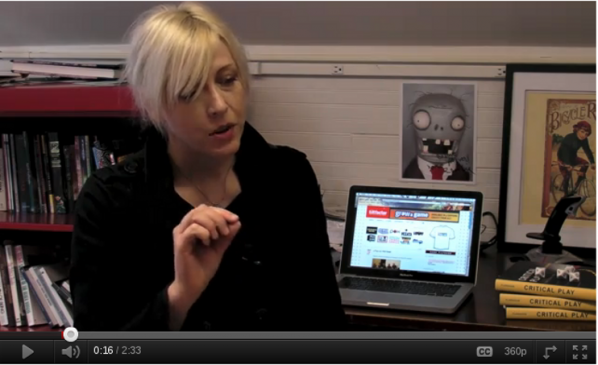
The differences between the platforms for the game are so dramatic, we’ve decided to conduct a study with the same game and different platforms, because watching people play the same game, the same rules, on a different platform clearly results in an different play experience. It is clear to me that very different things are going on, and I want to back up claims with data. For example, players play much faster if the game is computer based via an online game or the iPad. Players seem to like pressing buttons fast. In the board game, for example, observation shows us that players pick up pieces and discuss the moves with the other players, considering this option and that. The game piece actually becomes a kind of thinking object, I don’t know for sure, but it is very different. The speed up in time with a computer-based game appears to cut down conversation and meaningful dialogue that we’ve recorded in our last study on the board game. So, this is something that as games makers we’d really like to understand better, and share with others.
As an artist, I’m known to make media art and works that engage with play and game culture. In the laboratory context, I love developing and researching games with my team. I have amazing people to work with: Sukdith Punjasthitkul is my project manager who has a background in underground Asian culture, public health, and tennis; Zara Downs is a graphic designer and rural hipster who loves biology; Max Seidman is my accomplished undergraduate engineering student who has racked up several games in his time at the lab, and he loves wearing vests. Matt Cloyd is working with me, a recent graduate who is involved in sustainability issues in communities. Erika Murillo is a new student team member obsessed with social issues and animation. The list goes on. Part of the mission of what we do is to help the next generation who care about social issues have the tools to push what we do now, further.
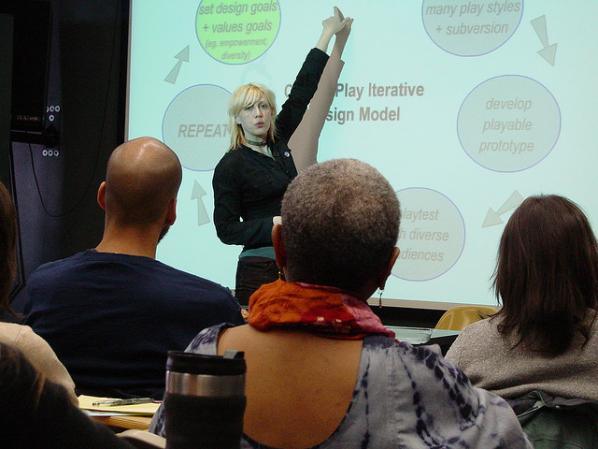
EG: Your point about how you’ve found players to engage more in dialogue when involved in a board game is very interesting. Non digital games such as board games and pervasive urban games have become more popular over the past few years; do you think players are desiring a more socially interactive experience?
MF: Board games are enjoying a renaissance, it is true. First, because I think people really like playing together in a physical space. Perhaps the new technologies — Wii and Kinect — remind people of that. Perhaps they played recently at a family gathering and remembered how much fun they are. It is impossible to say. Second, there are some really well-designed games out there right now, and available in many countries (in part, due to online purchase power), that are certainly worth playing. People do really like playing with each other in physical space, and they still enjoy watching sports in person. Technology can help facilitate this as with mobile games and pervasive games, but it is not a requirement for a good game. I think different kinds of conversations may happen over board games as compared to digital games, but this is something that needs some data behind it. So, we’ll be doing a study on these nuances in my lab very soon.
EG: Looking at Huizinga’s idea of ‘the magic circle’, there is a clear boundary between play and non-play. What were the challenges in designing a game which straddles this boundary, on one hand trying to entice participants through play and interaction, and on the other attempting to create real life social change?
MF: Emilie, this is the riding question for all of game design engaged with social issues, and behind all of the debates on how gamification can incite real behavioural and social change. You’ve hit the nail on the head! There are many forms of play, some which stay within the game in a nice neat package, like our board game, and some that bleed over into real life, such as ARGs. But one should not be fooled into thinking that this means that the former is useless for education and social change, and the latter is obviously better at it. We are about to release our pilot study on the learning in the game, and the results are surprising, showing that learning transfers out of the game as players can apply concepts in the game to new topics. We’re careful researchers. As artists, and as people critical of flippant comments about games and change, we don’t take research lightly. We don’t, for example, cite major gains on attitudinal change and make assumptions on long term behavioural change from a 40-minute game play session. That would be bad science. So we scale our questions accordingly, and in fact, are still surprised and pleased by the effect the game has. I’ll update you on the specifics when the paper is published this autumn!
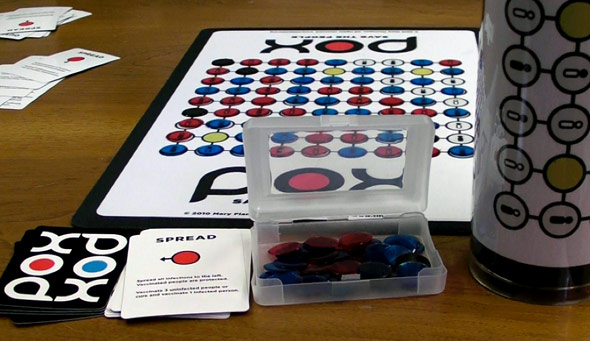
The deeper issues on the limits of how games can incentivise real behavioural and social change can get rather dark. How Pavlovian do we want to be in influencing people? Even those in social change arenas have to pause and think. Education and influence for good is what we strive for. Designers and companies can only go so far before we have something much more sinister at hand. This is why our team’s work on the Values at Play project (http://www.valuesatplay.org) remains relevant.
The first interview with Jake Harries, took place on one of Furtherfield’s Radio broadcasts on Resonance FM, earlier this March 2011. Fascinated by the historical context that came out of the radio discussion, we asked Jake for a second interview, this time it took place via email.
Jake Harries has been making music in Sheffield since the 1980s and is a sound artist, musician/producer, composer and field recordist with a strong interest in media art and the practical use of Open Source audio-visual software. He was a member of electronic funk band Chakk which is best known for building Sheffield’s first large recording studio, FON Studios, in the mid 1980s. He is currently one of “freestyle techno” trio Heights of Abraham and The Apt Gets, a band which uses guitars and only Open Source software on recycled computers to create songs from spam emails. He is Digital Arts Programme Manager at open access media lab, Access Space, and the current curator of the LOSS Linux Open Source Sound a website dedicated to music made with FLOSS.
Marc Garrett: Lets talk a bit about your own history first. You were in a band in the 80s called Chakk, could you tell us a bit about that?
Jake Harries: Chakk was based in Sheffield during the mid 80s and we are best known for building a heavily used facility, FON Studio, Sheffield’s first large commercial recording studio. Chakk made “industrial funk” music, a mix of funk base lines and drums with influences ranging from punk to soul to free jazz and electronica. Our music was aimed squarely at the dance floor. We believed that technology, in this case the recording studio, was the most important instrument a band could have both creatively and financially.
MG: So, you are part of the electro music history of Sheffield with bands like Cabaret Voltaire & The Human League in the late 70s – 80s?
JH: Yes, but the band itself didn’t have too much commercial success, a couple of indie chart top 10s and a couple of low 50s in the main UK chart, so few people remember us now. People are more likely to remember FON Studio.
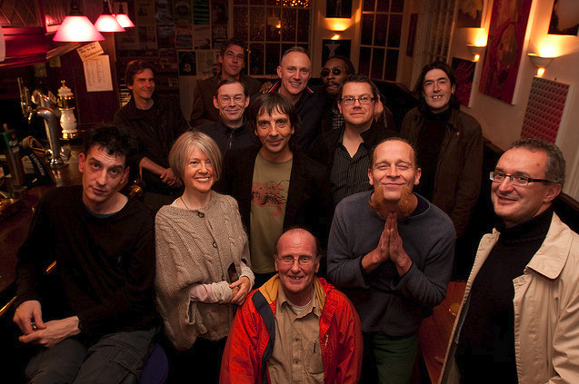
Recently a documentary has been made, called The Beat Is Law, about Sheffield music at that time, so perhaps there will be a bit more interest in the band.

MG: Open Source software is freely downloadable from the Internet for free and Linux is the most widely used Open Source operating system. How long have you been using Linux operating systems and Open Source?
JH: I had heard of Linux before, of course, but I came across music applications which were developed only for Linux in 2002-3 while searching for new software tools. These intrigued me sufficiently to install the operating system on a pc which I had fixed where I was working at the time.
MG: Do you feel that artists, techies and others are choosing Free and Open Source resources for reasons which connect with ethical and environmental issues and concerns?
JH: Well, I’d like to integrate into this answer the general themes of openness and transparency. FLOSS is akin to an encyclopedia of how to make things in the software realm because all the code is available for anyone to download and develop; closed, proprietary software is like a “sealed box” which it is illegal to prise open.
But it goes a bit deeper than that: in the world we are living in now the “sealed box” is increasingly becoming the mode of choice for all kinds of products, most of which, because they are designed to be superseded, have built in obsolescence. When something goes wrong with a product, you are unable to fix it yourself because you can’t get inside it, and even if you could you can’t find out how to fix it. If it is out of warranty, either you pay a lot of money to get it fixed or you throw it away; then you buy a new one! (Which is what the market wants you to do…)
So, it feels very much as if we are surrounded by technology we are not encouraged to understand and products with a limited life span: the obvious environmental concern is, “what happens to my ‘sealed box’ when I throw it away?”
Using a Linux operating system can increase the useful life of a computer by several years, and perhaps, if you can hack into them, other products too. So it is great if both hardware and software are open.
We also know that sharing knowledge is generally considered to be a good thing as it allows people to build on what has already been discovered. Being able to give the people in workshops the software they have been learning to use because it is FLOSS, rather than them having to pay several hundred pounds because it is only available on a commercial license, is great and often the idea of this kind of freedom takes a while for people to get used to if they’ve not come across it before.
MG: Why is it important as a creative practitioner to be using Open Source?
JH: Well, personally, I have realised that what I’m interested in is freedom, not just as a hypothetical, but the practical reality, finding out how to achieve some of it and if it is possible to sustain it. Free & Open Source operating systems and software are one way of stepping out side of the constant pressures of the commercial market places which dominate our culture.
We tried this in Chakk in the 80s with FON Studio, attempting not only to personally own the means of producing our music, the studio (allowing us to be outside the corporate system of production), but also to be able to explore our creativity in the way we wanted to. In the case of Chakk it didn’t work out. We had, rather cheekily, persuaded a giant corporate (MCA Records, owned by Universal) to bank roll it all and they found ways of scuppering our plan by making our product conform to their idea of the market place: transforming it into something “radio friendly” and bland, taking the energy and urgency out of the music. We were quite a politicised band and that energy was essential to our musical integrity.

However, when MCA dropped us we had a recording studio which could help nurture new music without too much external pressure, and this led to records produced there by local acts fulfilling their potential and going into the charts.
I think it is important for artists to have certain freedoms, to have ownership over the means with which they create their work. The fact that FLOSS allows you the user the potential of customising the tools you use and to distribute them freely via the web or other means is quite profound. And one of the real benefits of using FLOSS as a creative practitioner are the use of open standards and formats.
MG: OK, let’s move onto your own band: The Apt Gets. Now, since The Human League & Cabaret Voltaire, a whole generation has experienced the arrival of the Internet. Your group seems to reflect this aspect of contemporary, networked culture – a kind of Open Source rock band. Could you tell us about this band The Apt Gets, how you all got started and why?
JH: It began with workshops I was leading for musicians on FLOSS audio tools in 2007. The idea of an “open source rock band” came up – at the time we didn’t think there was one so a couple of the workshoppers and myself formed one. The Internet was the main source of inspiration really: we used recycled computers with Linux we’d downloaded, as well as guitars and vocals. I’m interested in re-purposing junk as raw material for creative processes and decided to re-use some of my spam emails as lyrics. We all hate spam, but re-contextualising it like this is fun, as is introducing a song by saying, “Here’s a classic Nigerian email asking for your bank details”. The themes of spam emails are generally things like greed & money, status & sex appeal as well as “meds”, so there’s more to them than you might think.
MG: Now, I personally know why, but others who are not as familiar with Linux and Open Source Operating systems, will not immediately know this. The naming of your band’s name – it’s specific to installing software. Could you tell us more about that?
JH: On a Debian Linux based operating system one can install software from the internet using an application called apt. One could type apt-get install the-name-of-the-software into the command line and apt will get the software from what is called a repository on the Internet, where the software is stored for download. We thought that if you called someone an Apt Get it could be interpreted as an insult meaning something like, clever bastard. So, that’s why we named the band The Apt Gets.

MG: How long has your research project with FLOSS been going?
JH: The research project started in 2007. Ever since I began to use FLOSS I’ve been interested in the practical realities of using it, particularly as an every day set of tools, as an ordinary computer user would use it: for instance, when I do work on the arts programme at Access Space I don’t use anything else. So, it made sense to discover how a number of non-Linux using musicians would find using FLOSS audio tools – if I was being an advocate for FLOSS I ought to look at it from the new user’s angle and discover how far they could go and what kind of time scale they need.
MG: And the web site address is?
JH: http://audiotools.lowtech.org
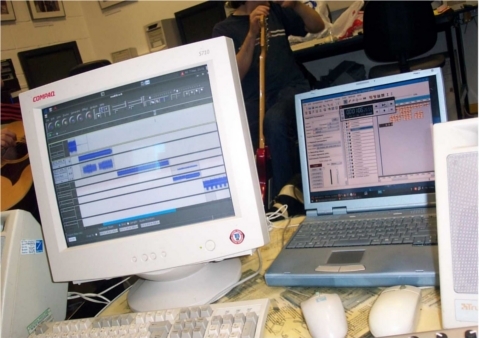
MG: How easy is it for someone with little or no experience of Open Source software and Linux based operating systems to install it?
JH: It is quite easy nowadays. A Linux distribution like Ubuntu has an easy to follow installer which allows you to create a dual boot if you want it, that is, keeping your Windows system as well so you have the choice of both.
MG: At Access Space in Sheffield, you are curator and researcher of LOSS (Linux Open Source Sound) a website dedicated to music made with FLOSS – which is basically LOSS with the letter ‘F’ added, meaning ‘Free Linux Open Source Sound’ – FLOSS!
JH: Yeah! Free is the word! It is a repository for music made with FLOSS tools and released under a Creative Commons license. You can freely download and upload tracks. Initially it was based around two projects, a physical CD issued in 2006 curated by Ed Carter, and LOSS Livecode, a mini conference and gig curated by Alex McLean and Jim Prevett based around the international livecoding community. The website is at http://loss.access-space.org.
MG: What is Access Space and what is different about them as a group?
JH: Access Space is an open access media lab, based in central Sheffield. It uses reused and donated computer technology to provide Internet access and Open Source creative tools, free of charge, five days a week. It started in 2000 and has become the longest running free Internet project in the UK.
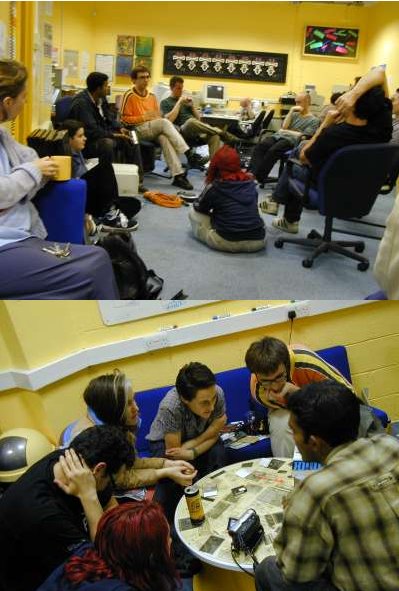
We recycle computers, put on art exhibitions, creative workshops and sonic art events. We’re currently developing a DIY Lab, modelled on MIT’s FabLab or fabrication laboratory. This will be an interface between the physical and digital domains where new kinds of creative activity can be developed.
MG: What operating systems would you suggest to newbies coming to Linux for the first time?
JH: Ubuntu or its derivative, Linux Mint, are both very user friendly for everyday use. For audio try Ubuntu Studio, 64 Studio or Pure:dyne.
MG: And regarding yourself, what are you using?
JH: I have set up eight Ubuntu Studio pcs for use in audio and video workshops at Access Space; and I use Pure:dyne live DVDs if I’m out and demonstrating on other people’s pcs. For everyday use, again Ubuntu Studio with a few additional applications like OpenOffice.
MG: Thank you for a fascinating conversation.
JH: It was a pleasure…
Open Access All Areas: an Interview with James Wallbank about Access Space by Charlotte Frost
http://www.metamute.org/en/Open-Access-All-Areas
Ubuntu Studio 11.04 release.
http://ubuntustudio.org/
64 Studio Ltd. produces bespoke GNU/Linux distributions which are compatible with official Debian and Ubuntu releases. http://www.64studio.com/
Puredyne is the USB-bootable GNU/Linux operating system for creative multimedia.
http://puredyne.org/
Pure:dyne Discussion, interview by Marc Garrett & Netbehaviour list Community 2008.
http://www.furtherfield.org/interviews/puredyne-discussion-netbehaviour